






Cornerstone Schools in Detroit has long achieved academic excellence by working closely with the region’s business community, but now the partnership is facing a new challenge as changing family dynamics impact basic reading skills, attendance, and classroom culture.


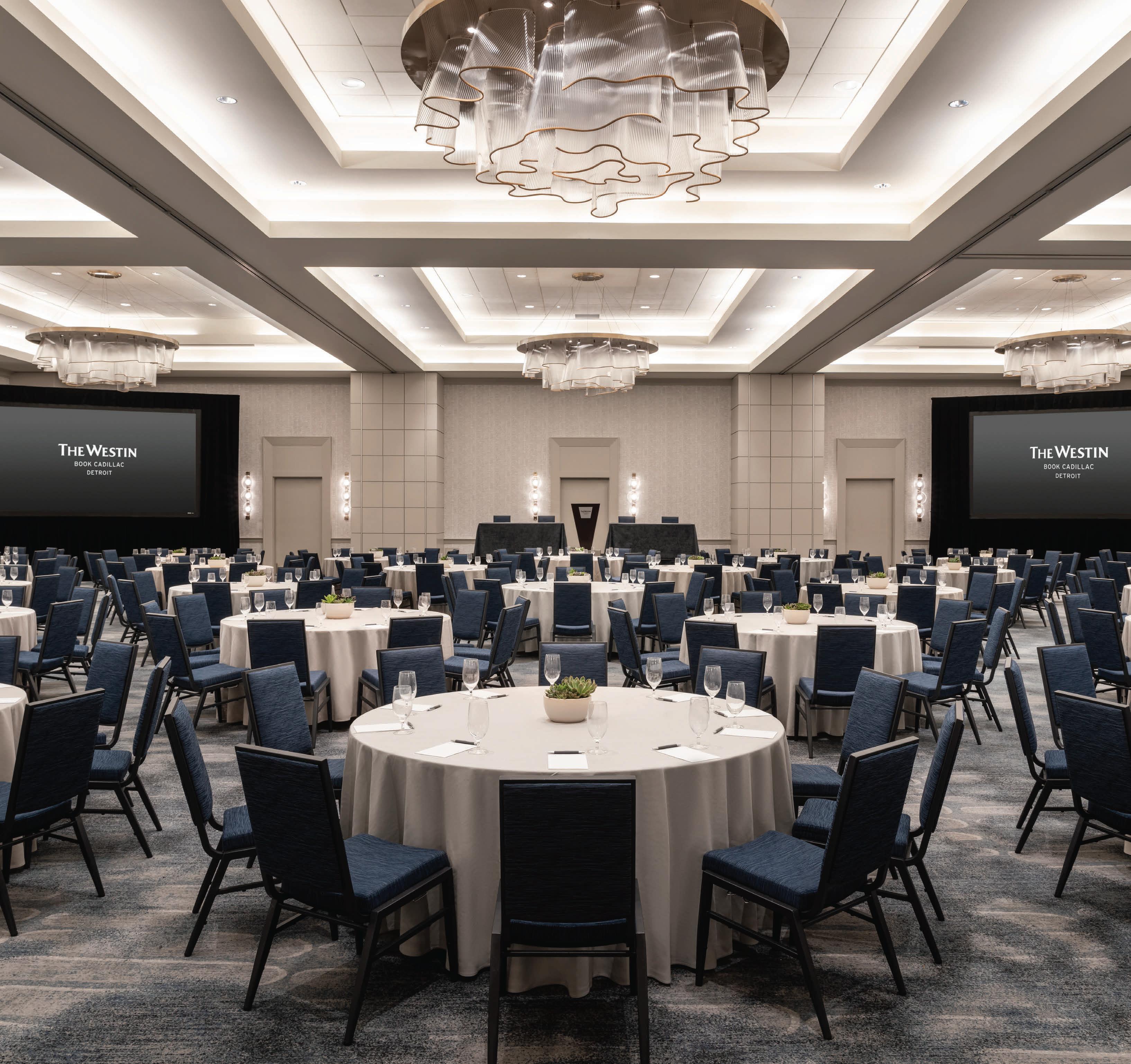


Staying true to the legacy, the historic Westin Book Cadillac Detroit offers meeting and event spaces thoughtfully redesigned for every occasion—from intimate board meetings to largescale conferences and sophisticated celebrations. Discover our reimagined guestrooms and suites, and impress clients or colleagues with a dining experience at Sullivan’s Steakhouse and the newly opened Haus of Brunch. Just steps from major corporate headquarters and downtown attractions, our location puts Detroit’s best right at your doorstep.
Connect with a meeting specialist today at 313-442-1616 or visit westinbookcadillac.com.























































No matter what your industry, ESOPs of all
We offer commercial payments and investment
as well
employer from our industry experts.
Take advantage of our local team:
David Mannarino
KeyBank Market President 4000 Town Center, Suite 1260 • South eld, MI 48075 Phone: 248-204-6550
David Mannarino@keybank.com key.com/commercial



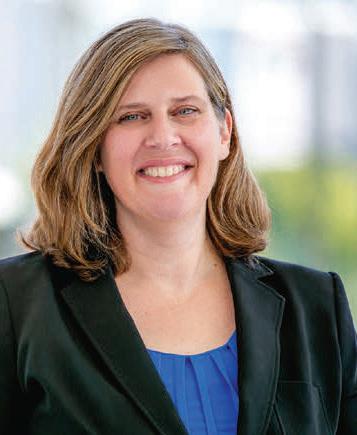

















From iconic props to full environments, Display Group’s Custom Fabrication team brings imagination to life.
Congratulations on being named one of Metro Detroit’s Most Powerful Business Leaders -


Your commitment to making health care better for people is what sets you apart. Thank you for your inspiring leadership.









In 2024, Detroit was named the #1 emerging startup ecosystem in North America, and Michigan Central’s renaissance is at the center of it all.Supported by the MEDC, the landmark’s renovation has created a hub for 100+ Michigan startups to seize their opportunity. Ready to seize yours? Visit MICHIGANBUSINESS.ORG and discover why Michigan is the ideal state to live, work and prosper.
22 FROM BAD TO WORSE
Michigan’s deteriorating roads and bridges, from the Ohio/Indiana border to the most northern tip of the Upper Peninsula, have yet to receive a long-term comprehensive funding plan from Gov. Gretchen Whitmer.
22 POWER POLITICS
The replacement of Enbridge Inc.’s Line 5 pipeline, which runs along the bottom of the Straits of Mackinac, is of vital interest to the federal government, according to a recent court filing. Both Gov. Gretchen Whitmer and Attorney General Dana Nessel oppose the replacement project, but they haven’t proposed an alternative.
22 JOBS WANTED
Michigan is shedding jobs and losing out on major industrial projects like advanced computer chip manufacturing facilities, due to a lack of leadership. To improve the state’s fortunes, Right to Work must be brought back and red tape should be eliminated, while public K-12 education needs a complete overhaul.
24 COMPENDIUM
How outsiders view Detroit.


28 HOME TEAM
The Schluter & Hughes Law Firm in Bloomfield Township has launched a customized wellness service for parents and others caring for elderly relatives. By R.J. King
29 LASTING IMPRESSION
Stealth in Northville redefines marketing campaigns using a fractional team approach. By R.J. King
29 CHANGE-MAKERS
Project for Public Spaces has selected Detroit as the host city for the fifth annual International Placemaking Conference, to be held from June 24-26, 2026. The Downtown Detroit Partnership will be the conference’s co-host. By R.J. King
30 CROWN ROYAL
Dr. Robert DiPilla has invested in cutting-edge dental technology to provide concierge-level care in downtown Birmingham. By Sarah Oleinick
30 PDA Q&A
Andrea Trapani, managing partner, Identity, Birmingham. By R.J. King
32 PAIRED TREATMENT
Je and Esther Selik quickly grew Gameday Men’s Health Birmingham/Bloomfield to the No. 5 company franchisee in the country. By R.J. King
90 PRODUCTION RUN
Life Et Cetera
88 CEO GIFT GUIDE
Do you know chief executives who think they have everything? Try giving a Garmin Fenix 8, a Detroit City Football Club Suite in its new stadium, a condo at The Residences at The Detroit EDITION, or the Disney 21 Royal Experience. By R.J. King and Stephanie Daniel
Brewery Blueprint: DesignTeam Plus in Birmingham has carved out a niche for itself designing breweries. By Tim Keenan
93 PATENTS AND INVENTIONS
Cereal Brothers: John H. and Will K. Kellogg, through their shared development of a breakfast staple, helped establish Battle Creek as an economic and health mecca. By Norm Sinclair
95 OPINION
Rx AI: The health care industry is increasingly using artificial intelligence to improve patient care, reduce costs, and speed diagnostic accuracy. By Dr. Anthony Oraha
96 THE CIRCUIT
Our party pics from exclusive events.
101 FROM THE TOP
Club Life: A guide to the Top Private Clubs in southeast Michigan, Largest Multitenant O ce Buildings in metro Detroit, and Largest Hospital Systems in Michigan.
106 CLOSING BELL
Steps Beyond: The DAC Briefcase Drill Team takes up the mantle from the Fred Hill Briefcase Drill Team for America’s Thanksgiving Parade in Detroit. By Ronald Ahrens
ON THE COVER Illustration by Justin Stenson

Energy isn’t just power—it’s possibility. It transforms a house into a home, bringing warmth, comfort, and the promise of moments that matter.
From preparing nutritious meals to sharing the joy of cooking with loved ones, the energy we deliver fuels family memories and sparks the moments that light up our lives.
Because with energy, we don't just cook—we create memories.











HBut things could get tricky. People with direct access to an executive may not know if they’re actually speaking with a human or their robot assistant. And what happens if multiple digital assistants are messaging back and forth with little or no supervision?

with the proverbial “man
aving met a few humanoid robots at area trade shows, it’s always been a one-sided conversation save for one encounter with the proverbial “man behind the curtain.”
he engineers, and R.J. KING



As the inquisitor prodded me to say something funny so he could send a signal to make the android shake wildly, it was clear future demand for personal robots will require a supporting cast of engineers, designers, integrators, and technicians.
A case also could made where a humanoid robot in a boardroom can record meetings, provide critiques or research on demand, operate AV equipment, and set the table and serve a threecourse meal, along with refreshments.
Once the meeting is over, the robot would signal other personal robots to bring the board members’ respective vehicles to the front entrance, send out a meeting recap to pre-approved personnel, clean up the space, and then power down and wait for the next assignment.
Nice piece on Sid Taylor (in the Letter from the Editor in the September-October issue of DBusiness). I just reached out to him to help validate the headwinds we even face in higher ed, having had the joy and tumult of starting a very successful aviation maintenance technology program.
John Cox, President Cape Cod Community College Barnstable, Mass.



Taking it a step further, jobs in programming, operations, training, and maintenance and repair will generate demand for insurance, accounting, cybersecurity, and other across-the-board services.
Right now, industrial robots dominate the industry. But as Elon Musk and others ramp up the production of humanoid robots, mechanized, programmable executive assistants are not too far away.
Musk, CEO of Tesla, announced in July that the base Tesla Optimus humanoid robot will have a starting price of $18,999, with the rst units to be delivered in early 2026. Once production scales, the price is projected to drop to as low as $15,000 per unit.
ink of the possibilities a humanoid robot could have at the o ce, at home, or on the road.
Imagine practicing a speech with your new assistant and getting real-time feedback on the presentation itself, your body language, or your tempo.
Given humanoid robots can double as an avatar, an executive could develop a digital twin android that, in the future, will be programmed to check and approve payroll, authorize and administer contracts, or sense a mood and recommend a suitable selection of music.
At home, robots can clean, cook, cut the lawn, order takeout food, suggest recipes or decorating tips, interact with children and help them with their homework, feed and walk the family dog, provide a massage, or oversee a physical therapy plan.
But if personal robots become a successful market where there are millions of mechanized assistants, what will happen at major events like a football game, a concert, or a ballet?
Will there be signs at the front entrance of a venue that all robots must remain in their vehicles or stand in a designated area? Given some people will want their robots with them at all times, can a person buy, for example, a concert seat for their android?
Add in aerial taxis and, yes, we will have achieved what the popular animated series “ e Jetsons” rst portrayed in the early 1960s. In fact, we may be ahead of the game. e show was set in 2062 in the ctional metropolis of “Orbit City.”
As personal robots move from simple tools to become intelligent managers, assistants, educators, and companions, the future isn’t just around the corner — it’s here.
R.J. King rjking@dbusiness.com
Thanks for shining a light on Detroit Catholic Central student Dominic Recchione in your Powered by Youth article in the July-August issue of DBusiness. He is one of many examples of the type of highly motivated students walking the halls at CC. The school has an incredible culture and a unique business curriculum that supports young entrepreneurs. I’m sure the Detroit business community will hear about young men like Dominic making an impact for years to come.
Mike DeVilling Birmingham
Thank you for coming to the Michigan WWII Legacy Memorial’s Wild Game Dinner fundraiser. We’re raising $3 million to complete the memorial as designed. We’re passionate about telling the stories and preserving the legacy of our state’s home front and warfront heroes. Their role in the most pivotal event of the 20th century cannot be lost.
Judy Maten Royal Oak

Business leaders say they trust the attorneys of Plunkett Cooney to anticipate legal pitfalls, to resolve high-stakes litigation and to craft contracts they can sign... with confidence. See your business differently. Get the Plunkett Cooney perspective. n Appellate Law n Banking, Bankruptcy & Creditors’ Rights n Business Transactions n Cannabis Law n Commercial Litigation n

Bill Dow is a Detroit-area freelance writer based in Birmingham whose work has appeared in DBusiness, Hour Detroit, Metro Parent, Detroit Home, The Detroit News, the Detroit Free Press, USA Today, Baseball Digest, and the New York Daily News. His writing covers sports history, business, and health. He’s co-author of the book “Tiger Stadium, Essays and Memories of Detroit’s Historic Ballpark, 1912-2009.” In this issue of DBusiness, Dow explores Detroit’s charter Cornerstone Schools and the businesspeople who are investing in it to take it to the next level.
Dan Calabrese has been reporting on business in Michigan since 1992. He started at the Grand Rapids Business Journal and became a frequent contributor to DBusiness in 2009. He has written for a variety of trade magazines, including Transport Topics, Pet Age, ICF Builder, and several others. He also has authored four novels: “Powers and Principalities,” “Pharmakeia,” “Dark Matter,” and “Backstop.” Calabrese lives in Royal Oak with his wife, Angie, and their son, Tony. In this issue, the graduate of Western Michigan University contributes several of the profiles of the DBusiness Commercial Real Estate Award winners.


Brian Britigan is a Minneapolis-based illustrator, artist, and educator. Born and raised in Iowa City, Iowa, he studied art and animation at the University of Washington in Seattle before earning his MFA in illustration from the School of Visual Arts in New York City. Working as a freelance illustrator since 2015, Britigan creates images for print and online publications, animations for documentary projects, and original artworks for gallery exhibitions. In addition to earning a gold medal from the Society of Illustrators, his work has received recognition from American Illustration, Communication Arts, 3×3, and Spectrum, as well as a News and Documentary Emmy nomination. For this issue, he illustrated the 2026 Top Lawyers list.
Paul IT
IT DIRECTOR Jeremy Leland
CIRCULATION
CIRCULATION MANAGER Riley Meyers
CIRCULATION COORDINATORS David Benvenuto, Cathy Krajenke, Rachel Moulden, Michele Wold
MARKETING AND EVENTS
MARKETING AND EVENTS MANAGER Regan Wright
MARKETING AND EVENTS COORDINATOR Puja Trivedi
MARKETING AND EVENTS ASSISTANT Kayla Yucha
MARKETING AND EVENTS ADMINISTRATIVE ASSISTANT Connor Cooper
MARKETING RESEARCH
MARKETING RESEARCH DIRECTOR Sofia Shevin
MARKETING RESEARCH COORDINATOR Kristin Bestrom
MARKETING RESEARCH SALES COORDINATOR Alexandra Thompson
MARKETING RESEARCH SALES ASSISTANT Theresa Lowery
GRAPHIC DESIGNER Kendra Okamoto
MARKETING RESEARCH INTERNS Rachel Randazzo, Keerthana Reddy, Gwen Zych
BUSINESS
CEO Stefan Wanczyk
PRESIDENT John Balardo
DIRECTOR OF BUSINESS OPERATIONS Kathie Gorecki
MEDIA ASSOCIATE Lachlan O’Neill
SENIOR ACCOUNTING ASSOCIATE Andrew Kotzian
ACCOUNTING ASSOCIATES Jenna Glod, Austin Schmelzle
DISTRIBUTION Target Distribution, Troy






















— DENISE DONOHUE, CEO, COUNTY ROAD ASSOCIATION OF MICHIGAN
BILLION
Annual cumulative cost to Michigan drivers due to poor road conditions
ichigan’s deteriorating roads and bridges, from the Ohio/Indiana border to the most northern tip of the Upper Peninsula, have yet to receive a long-term comprehensive funding plan from Gov. Gretchen Whitmer.
On the campaign trail in 2018, during her first run for the office, Whitmer promised she would “fix the damn roads.” Perhaps more people should have asked when. Now, in her seventh year in office, the state’s overall road infrastructure may be worse than ever.
According to a new report from TRIP, a nonprofit transportation research organization in Washington, D.C., Michigan’s economy is being negatively impacted by poor roads in the form of higher vehicle repair costs, added traffic (which generates more pollution and diminishes overall productivity), and a loss of construction jobs tied to infrastructure.
“The ability to restore our roads and bridges is foundational to a prosperous Michigan that saves our vehicle drivers money in repairs and sets our state up for a more prosperous future,” Denise Donohue, CEO of the County Road Association of Michigan (CRA) in Lansing, said when the organization released its 2025 County Road Investment Plan in September.
With county road agencies overseeing 75 percent of Michigan centerline miles and 52 percent of its bridges, the report documents a shortfall in money to repair, preserve, replace, and sustain Michigan’s 5,868 county bridges.
THE REPLACEMENT OF ENBRIDGE INC.’S LINE 5 pipeline, which runs along the bottom of the Straits of Mackinac, is of vital interest to the federal government, according to a recent court filing. Both Gov. Gretchen Whitmer and Attorney General Dana Nessel oppose the replacement project, but they haven’t proposed an alternative.
In September, the U.S. Department of Justice filed a statement of interest in a federal court supporting Enbridge’s plan to build a new pipeline inside a concrete-lined tunnel 100 feet beneath the lake bed. The filing notes, “Michigan is trying to usurp the DOT’s statutory authority” to regulate pipeline safety and overall energy supplies.
First operational in 1953, the pipeline transports light crude oil and natural gas liquids to the tune of 540,000 barrels per day. That fuel provides 65 percent of the Upper Peninsula’s annual propane supply to heat homes and businesses, provides jet fuel at major airports, and powers multiple manufacturing and industrial facilities.
The Michigan Public Service Commission has approved the project, and local unions are in favor of it. Rather than continuing to block the replacement section, Whitmer and Nessel should drop their opposition, given the commission — following a years-long review — has determined “there is a public need” for a new pipeline.
EMPLOYMENT
Average annual repair cost for Michigan drivers due to poor roads ($2,921)
3 THOUSAND % 1.2 PERCENT
Michigan’s annual job growth rate since 2019
In the most recent assessment of county conditions, 72 bridges are closed, 77 bridges are rated in critical condition, and another 255 bridges are in serious condition, based on data from the Michigan Department of Transportation made available in September.
Across the entire state, 2,737 bridges are in need of repair, according to the American Road and Transportation Builders Association. In turn, around 20 percent of the state’s roads are in poor condition, based on TRIP figures.
At the same time, construction and material expenditures have surged due to inflation and other factors — bridge costs alone have jumped 32 percent since CRA’s 2023 County Road Investment Plan.
Based on most state rankings, Michigan gets poor marks for its infrastructure. For companies looking to expand or open new operations in the state, the condition of roads and bridges can be a vital consideration, especially for businesses in the transportation sector.
Consider, in the 2025 Best States rankings by U.S. News & World Report, Michigan is ranked 43rd overall. Among key sectors, the state is ranked 44th for infrastructure.
Looking ahead, CRA’s Investment Plan pegs the necessary level of investment in the county road and bridge system to meet modest improvement goals at $4.5 billion annually, up from $4.1 billion in the 2023 plan. When current road funds are subtracted, the remaining need, or gap, is $2.4 billion. Across the state, the annual shortfall is $3.9 billion. (Next year, the state budget adds another $1.1 billion to roads.)
Source: TRIP
Donohue sums up the funding crisis best: “County road agencies aren’t asking for autobahns and high-tech bridges, they’re simply trying to meet their statutory responsibility to serve their communities with a safe and efficient county road and bridge network.”
MICHIGAN IS SHEDDING JOBS AND LOSING OUT on major industrial projects like advanced computer chip manufacturing facilities due to a lack of leadership, the loss of Right to Work initiated by Gov. Gretchen Whitmer, and a median household income that trails the national average.
To improve the state’s fortunes, Right to Work must be brought back and red tape should be eliminated, while public K-12 education needs a complete overhaul. According to the 2025 Best States rankings by U.S. News & World Report, Michigan ranks 45th when it comes to education. The report also shows Michigan lags every Great Lakes state in multiple sectors.
Based on the 2024 American Community Survey, Michigan’s median household income is $72,389, well below the national average of $81,604. On the educational front, 61 percent of third-graders in Michigan’s public schools can’t pass a basic reading proficiency test.
In turn, the state’s unemployment rate was at 5.2 percent in August — the second-worst showing in the country. The U.S. national employment rate during the same period was 4.3 percent. Rather than providing excuses for the state’s poor performance, the governor, legislators, and business leaders should work more closely to improve the state’s economic standing.












DETROIT’S CARMAKERS TO SAVE BILLIONS IN EMISSIONS ROLLBACK
BLOOMBERG SEPT. 8, 2025
BY DAVID WELCH
President Donald Trump’s push to cut federal sales incentives and roll back emissions standards is shaping up to be a multibillion-dollar gift to Detroit’s automakers as they shift investments into gasoline-fueled cars.
General Motors Co. said it would cut electric-vehicle production plans at two factories as it overhauls a third plant to make gas-fueled pickups, instead of battery-powered trucks.
Ford Motor Co. is moving funds from a canceled three-row electric SUV to future internal combustion engine vehicles and hybrids, while Jeep owner Stellantis NV is resurrecting the thirsty Hemi V-8 engine.
Although not yet finalized, the deregulatory push is clearing the way for Detroit’s legacy automakers and their traditional rivals to reallocate billions of dollars earmarked for EVs and other costs linked to pollution rules. GM has spent $3.5 billion since 2022 purchasing so-called regulatory credits to help the company meet fuel economy and tailpipe emissions requirements — a less-needed currency if
Trump’s policies stick. Ford has similarly cut its own credit-purchase commitments by nearly $1.5 billion this year alone, money it now plans to reallocate to gas-powered models and hybrids.
The shift in policy “has the potential to unlock a multibillion-dollar opportunity over the next two years,” Ford CEO Jim Farley recently told analysts.
Trump’s $3.4 trillion fiscal package sunsets the $7,500 tax credit for EV buyers on Sept. 30. It also zeroed out fines faced by automakers that fell short of fuel-economy mandates, negating the need to buy credits under those rules. Stellantis paid $190 million in penalties in each of the last two years.
Eliminating the fines “will save us money in 2026 and beyond for sure,” GM Chief Financial Officer Paul Jacobson told investors in August. …
‘ALMOST ALL OR NOTHING’
SPORTS ILLUSTRATED SEPT. 5, 2025 BY EMMETT MATASOVSKY
During the Detroit Lions’ turnaround, the consistent face in Dan Campbell’s rebuild has been wide receiver Amon-Ra St. Brown. From an 0-10-1 start to his career to the playoffs in
“I think it’s big. A lot of us that came in in 2021 are still here … ” the pass catcher pointed out. “I think that’s a big reason why we’re at where we’re at today, including coaches. …”
THE SATURDAY EVENING POST • SEPT. 1, 2025 • BY BEN
RAILTON
each of the last two seasons, the receiver has been the model of consistency.
Before the season opener at Green Bay, which the Lions lost 27-13, he called his upcoming fifth season in the league an all-or-nothing campaign for the Lions. Even though the same core of players are under contract for the 2026 season, the USC product knows there are no guarantees in the NFL.
“Last year we wanted to get it done. I felt like last year was the first year where …” St. Brown trailed off. “We were close the year before, the NFC Championship, then last year was like, ‘All right, we want to get it done this year,’ and we didn’t get it done last year. This year it’s almost all or nothing.
“Even though, in reality, our nucleus will still be in here next year, we’ll probably have a pretty good team next year. There’s no saying what can happen; for us, it’s like, ‘we know we got the guys right now on this team, we got everything we need, all the pieces, and let’s just go out there and try to win the whole thing.'”
The reason for this sustained success and this window has been the consistency year after year. St. Brown called that a big reason for the success, but also mentioned the talent that Dan Campbell and Brad Holmes added each year.
In late August, we dropped off our younger son, Kyle, to start his first year at the University of Michigan. Before heading home, and through the proud but bittersweet dad tears, I had the chance to explore the neighboring city of Detroit for the first time.
I was particularly struck by three essential elements: how much its cultural landscape captures mid-20th century Black music’s evolution and vital role in America; how fully its architecture and neighborhoods reflect the goals and challenges of historic preservation and urban communities; and how strikingly it embodies the crises of 21st century American cities, and the need to resist abandonment and instead to fight for all those cultural, historic, and civic layers.
What stood out to me most about all those essential elements is how much Detroit echoes my favorite American city, New Orleans. This interconnection between two of our great but endangered historic cities also exemplifies a multilayered American story, one with a lot to tell us in 2025.
In the first few decades of the 20th century, Detroit grew from a relatively small community into the nation’s fourth-largest city, and it was the influx of African Americans from southern communities like New Orleans that really drove that growth. Between 1910 and 1930, at the height of the mass movement known as the Great Migration, Detroit’s Black population grew from around 5,000 to over 120,000. By 1920, more than 85 percent of the city’s Black residents had been born outside of the state, reflecting this explosion of new arrivals. In 1912, the NAACP founded a Detroit chapter, while the rival civil rights

organization the Urban League did so in 1916. Unfortunately, the racial prejudice and violence that African Americans had faced in southern communities like New Orleans followed them to these new urban spaces. Domestic terrorist groups like the KKK and the Black Legion became dominant forces in Detroit in the 1920s and ’30s. Racial massacres like those New Orleans had experienced since the 1860s became a recurring part of Detroit’s story, as exemplified by the city’s 1943 and 1967 white supremacist riots. And as historian T.J. Sugrue traces in his important book, “The Origins of the Urban Crisis: Race and Inequality in Postwar Detroit” (1996), the racial segregation that came to define the city’s and nation’s urban spaces in the 20th century was developed during the Great Migration.
Despite these ongoing attacks — and indeed in response to them — Detroit’s expanding African American community quickly became a fixture on the nation’s cultural landscape. It did so first through the Great Migration journey of the Delta Blues from its Mississippi origins to its evolution in Detroit, as embodied by the paths of pioneering musical giants John Lee Hooker and Big Joe Williams. But it was with the 1959 founding of Tamla Records by Detroit’s own Berry Gordy Jr. that the city’s cultural influence truly exploded. Incorporated a year later as the Motown Record Corp., this record label built on the foundational stories of New Orleans Black rock and rollers like Dave Bartholemew, Fats Domino, and Little Richard. …

NEWSWEEK • AUG. 4, 2025 • BY THEO BURMAN
Detroit has logged one of the worst air qualities of any city in the world, surpassing other international urban hubs as pollution levels spike due to wildfires across the border in Canada.
Smoke from Canadian wildfires has continued to drift over the Midwest, blanketing the region with haze and poor air quality, prompting the National Weather Service (NWS) to issue alerts across several states, including Michigan, Wisconsin, Minnesota and Iowa.
Newsweek reached out to the National Weather Service via email for comment.
Why It Matters — The increased concentration of airborne fine particulate matter, PM2.5, from wildfires can worsen respiratory and heart conditions, making sensitive groups particularly vulnerable, especially people with asthma, heart disease or other pre-existing respiratory conditions.
Air quality alerts have been in place for a couple of days, with individual National Weather Service offices previously reporting unhealthy conditions. Earlier this week, wildfire smoke from Canada was so thick over Chicago that the city recorded the worst air quality in the world.
What To Know — On the World Quality Air Index, which measures global pollution, Detroit saw a sharp spike as ash and other particulates drifted over the border from Canada.
At the time of writing, Detroit ranks third in the entire world, behind Kinshasa, the capital of the Democratic Republic of the Congo, and Toronto, which is also being affected by the Canadian wildfires.
The current rankings indicate that Detroit is more polluted than Kolkata, one of India’s largest cities, and every other city in the United States.
The Air Index assigned Detroit an air quality score of 155, making it one of only five cities in the world currently considered “unhealthy” to be in.
Across the eight affected states, the NWS warned that
when pollution levels are elevated, people should “consider limiting strenuous outdoor physical activity to reduce the risk of adverse health effects.”
In addition to limiting outdoor physical activity, the agency has urged people and businesses to “avoid activities which lead to ozone formation,” listing out activities like refueling vehicles or using gasoline-powered lawn equipment. ...
LIVE FOR LIVE MUSIC
SEPT. 2, 2025
BY JAMES SISSLER
Don Was — Grammy-winning producer, bassist for Bob Weir & Wolf Bros, and president of Blue Note Records — has announced the debut album from his band The Pan-Detroit Ensemble, along with the first leg of an extensive headlining tour. The tour will showcase songs from the band’s forthcoming record alongside a complete performance of the Grateful Dead’s Blues for Allah in honor of the album’s 50th anniversary.
Launched in 2024, the nine-piece soul jazz band draws inspiration from the Motor City’s wide-ranging musical history, citing influences ranging from John Lee Hooker, Donald Byrd, and Joe Henderson to George Clinton, Mitch Ryder, The Stooges, and Electrifying Mojo.
“There’s a unique sound and feel to Detroit that permeates the music in a way that resonates all over the globe,” said Was. “There is a rawness, a lack of pretension and an unmistakable, underlying
groove that reflects the people and culture of the entire city.”
Led by Was with Dave McMurray on sax, Luis Resto on keys, Vincent Chandler on trombone, John Douglas on trumpet, Jeff Canaday on drums, Mahindi Masai on percussion, Wayne Gerard on guitar, and Steffanie Christi’an on vocals, the band debuted last spring, performing a mix of originals and songs by Yusef Lateef, Olu Dara, Henry Threadgill, and more during a short run spanning intimate clubs, historic concert halls, and major festival stages.
Was characterized the band’s sound as “Jazzy and improvisational but also glued together with a sinewy R&B groove. It’s not slick or smooth — it’s a very raw, honest, Detroit kind of thing,” he explained. He went on to describe how his experiences touring with Bob Weir and working with artists on the Blue Note roster “have pointed the way toward realizing that sound,” adding, “The Pan-Detroit Ensemble finally manifests that ‘thing’ I’ve been pursuing. The intention is to make communicative music that gets under the listener’s skin and brings them some joy, comfort and understanding in deeply troubled times. It’s all connected.”
With the band’s debut album due out this fall via Mac Avenue Music, Don Was and the Pan-Detroit Ensemble will kick off their fall tour in Japan with a three-night, six-show residency at Blue Note Tokyo leading up to an appearance at Blue Note Jazz Festival in Japan on Sept. 27. The band will then return to the States in October. ...
FORBES • SEPT. 18, 2025 • BY DAN RINGO
Founders often struggle to separate their personal identity from the identity of their business. When leaders blur those lines, they unintentionally create fragility: decision-making, loyalty, and culture can become dependent on one person instead of the company’s mission. Businesses that are treated as their own entity — complete with systems, standards, and a distinct identity — are far more sustainable. Building a Mission Bigger Than the Founder — A common challenge for founders is separating personal ambition from the company’s larger role in serving its customers and community. When leaders make it clear that the business is bigger than themselves, teams begin to see the organization as an entity with its own identity, purpose, and future.
That distinction matters. When employees view the business as a character with its own mission, they buy into its long-term success. This reduces friction and builds cohesion because the team is motivated by what sustains the organization rather than what satisfies one individual.
Systems That Empower Teams — For many founders, stepping back is difficult because decision-making often rests solely on their shoulders. The shift happens when companies establish clear processes, accountability measures, and customer-focused standards that guide decision making. By putting systems in place, employees can act in alignment with the mission — even if their decisions differ from what the founder might have chosen. This is a hallmark of personification. As highlighted in Your Business Isn’t You, organizations with transparent systems shift power from personality to process. That shift empowers teams, builds resilience, and eliminates bottlenecks created when every decision must flow through the founder.
Loyalty to Vision, Not Personality — Another key principle of personification is rethinking loyalty. Employees should be loyal to the mission and longevity of the business — not to the individual leader. ....





For parents and others caring for elderly relatives, the Schluter & Hughes Law Firm in Bloomfield Township has launched a customized wellness service.
BY R.J. KING
As many families are challenged by balancing the medical needs of both their children and their older parents or relatives, the Schluter & Hughes Law Firm in Bloomfield Township has developed a special practice area called Care Coordination.
A customized service for seniors and their families, the law firm will provide an initial assessment of an elderly client’s residential setting, develop a personalized care plan, and arrange and monitor home health or medical facility services.
The care team also will schedule medical appointments; provide routine wellness checks via a professional care coordinator, a registered nurse, or a care professional; and attend doctor visits as requested. The team can serve as a family advocate, as well.
The law firm’s Care Coordination services are especially useful when parents prefer to age in place and their relatives live in different cities, states, or countries.
Humanetics Merges its European Group with Sensor Manufacturer Humanetics has merged Humanetics Europe GmbH with German safety system sensor technology provider mg-sensor GmbH. The deal brings two key competencies together under one structure to streamline operations.

“We offer a centralized place and a care coordination team to help manage your loved one’s affairs, and we share important medical information with the entire care team,” says Dawn M. Schluter, a partner at Schluter & Hughes who has extensive experience in estate planning, wealth transfer planning, probate litigation, taxes, and family law matters.
After earning a bachelor’s degree in political science at Kalamazoo College in Kalamazoo, she completed her juris doctorate and an LLM in taxation at Wayne State University in Detroit. She’s also a DBusiness Top Lawyer, having been nominated by her peers annually for Family Law and Trusts and Estates since 2009.
When developing a plan of action for a potential medical emergency, the care team provides the patient with a binder that details their medical history and needs.
The binder, or portfolio, which can travel with a patient to a hospital or a medical center, serves as a centralized record-keeping system tailored for each person’s specific needs and might include an estate plan, a care coordination plan, important legal documents, and an emergency care plan.
The team also uses tools such as medical alert systems, emergency contact screen-savers for smartphones and tablets, and QR codes that provide health information to ensure the entire care team is up to date.
All services are billed at an hourly rate. Services are concierge style, and no minimum service contract is required.
Dawn M. Schluter, bottom right, a partner at Schluter & Hughes Law Firm in Bloomfield Township, helps lead a special practice area for seniors and their families.
Little Caesars Expands to MSU Athletic Venues
Little Caesars in Detroit is bringing its brand of pizza to the three main athletic venues at Michigan State University in East Lansing: Spartan Stadium, the Breslin Center, and Munn Ice Arena.
In addition to navigating the maze of aging services, the care team provides in-home safety suggestions, can assist with moving a patient to another setting like a nursing home, and is able to help a client and/or their family navigate options and implement solutions.
The team also can review financial, legal, or medical issues and arrange referrals as needed, assist in discharge planning and necessary rehab services, and provide an annual review of emergency medical information.
Metro Airport Ranks No. 2 in North America for Customer Satisfaction
Detroit Metro Airport was recently ranked second in customer satisfaction among mega airports, according to J.D. Power in Troy. Minneapolis-Saint Paul International Airport ranked highest, with a score of 660. Metro was at 649.
123Net Completes Major Expansion of its Southfield DC1 Data Center
123Net has completed a major expansion of its Southfield DC1 Data Center, adding advanced colocation space and infrastructure tailored for the demands of AI inference and other data-intensive applications.
LIFT in Detroit Awarded $9M to Develop Materials Solutions
LIFT in Detroit’s Corktown district has been awarded a four-year, $9 million contract to accelerate the development of ceramic-based matrix composites and ultra-high-temperature materials for use in the industrial and defense sectors.
has selected Detroit as the host city for the fifth annual International Placemaking Conference, to be held from June 24-26, 2026. The Downtown Detroit Partnership will be the conference’s co-host.
More than 500 public space professionals, including urban planners and designers, public officials, place managers, and researchers, will attend what’s called Placemaking Week, which emphasizes hands-on learning and innovative social events while leaving behind a public space legacy.
The theme for the 2026 conference, From Recovery to Resilience through Placemaking, is designed to serve as a reminder of the transformative influence of community-powered spaces.
“We’re thrilled to bring together placemakers from all around the world to learn from Detroit’s groundbreaking placemaking efforts,” says Nate Storring, co-executive director of Project for Public Spaces in Brooklyn, N.Y.
Over the past decade, Detroit has turned once-neglected areas into community spaces through grassroots innovation, public-private collaborations, and cultural investments.
Landmark projects, according to the organizers, include Campus Martius Park, Michigan Central, the Joe Louis Greenway, the Detroit Riverwalk, and Belle Isle, among others.
— By R.J. King
Stealth in Northville redefines marketing campaigns using a fractional team approach.
BY R.J. KING | BRANDON NAGY
Wesley Mathews sees two voids in the marketing world: clients that don’t get the results they expect, and a lack of measureable accountability.
For more than 15 years, Mathews, co-founder and CEO of High Level Marketing in West Bloomfield, helped create and execute marketing campaigns for scores of small- and medium-sized businesses across the United States.
In 2001, when the company was sold, Mathews stayed on for two years as chief growth officer before taking a break to rest and consider his next move. “I wasn’t ready to retire and walk off into the sunset,” he says.
Instead, he “got the band back together.” With his former business partner, Jon Bowerman, and a past High Level board member, Josh Linkner, Stealth was founded in Northville in late 2023.
In its first full year of operation, Stealth, which provides a fractional marketing team to develop and execute campaigns, had 15 clients and posted more than $1.1 million in revenue.
“I’ve sat in that marketing seat and, to me, unless you have a company making more than $100 million in (annual) sales, you don’t need a chief marketing officer,” says Mathews, co-founder and CEO of Stealth. “What we developed is a new way to use the fractional model to bring experts to every marketing campaign.”
Fractional executives aren’t new, but Mathews says Stealth is pioneering a marketing team concept that combines strategy, leadership, and execution as a single solution for growth-minded businesses.
“We bring four people to each client relationship — a strategist, a marketing director, a marketing product manager, and someone who oversees everything and works directly with the client,” Mathews says.
“It’s hard for smaller companies to find or afford good marketing people, so we fill that gap and save clients time, money, and efficiency that’s resultsorientated. For example, our client Minc Law (in Cleveland) has posted record revenue month over month since realigning their strategy with us.”
POWER SOURCE
Wesley Mathews and Jon Bowerman, co-founders of Stealth, have their offices in a former Ford valve plant near downtown Northville.

Once a new client is engaged, Mathews and his team build out a campaign that typically lasts six months or longer, depending on the need. The company charges $7,500 a month for its services, which includes developing an initial blueprint that follows a half-day “deep dive” evaluation and custom strategy plan.
“Coming out of that first session with the client, we execute the deliverables,” Mathews says.
Linkner, co-founder and managing partner at Mudita Venture Partners in Bingham Farms, says the investment firm “saw something special in Stealth — a disciplined approach to marketing leadership that actually moves the needle where others don’t. Their ability to generate measurable ROI for clients is exactly why we backed them.”
Ford
Ford Health is partnering
and Co. in New Jersey to develop a robotic solution that will enable patients to pick up prescriptions at their convenience — 24 hours a day, seven days a week.
Cost to Repair County Road Bridges in Michigan Soars 32% Michigan’s 83 county road agencies face a local bridge funding crisis and growing overall funding gap, according to the latest findings in the County Road Association of Michigan’s 2025 County Road Investment Plan.
Hungry Howie’s Takes DetroitStyle Pizza Nationwide Hungry Howie’s is the first national pizza chain to offer Detroit-style pizza across the country. The launch celebrated the brand’s hometown heritage — it was founded in Madison Heights in 1973.
BAE Systems Partners to Advance Autonomous AMPVs BAE Systems, which operates part of its Platforms and Services business sector in Sterling Heights, and Forterra, a provider of autonomous systems in Warren, are collaborating to rapidly prototype an autonomous armored multipurpose vehicle.
Indochino Opens New Custom Suit Showroom at Somerset Indochino Apparel, a purveyor of custom-made clothing, has opened its newest showroom at the Somerset Collection in Troy. The new showroom is designed to offer customers the opportunity to design one-of-a-kind garments.
For full stories and more, visit dbusiness.com/daily-news to get daily news sent directly to your email.
Dr. Robert DiPilla has invested in cutting-edge dental technology to provide concierge-level care in downtown Birmingham.
BY SARAH OLEINICK | NICK HAGEN
Dr. Robert DiPilla describes himself as a technology-driven dentist who has invested $2 million in building out DiPilla Dentistry at 720 N. Old Woodward in downtown Birmingham.
The new office features natural materials, floor-toceiling windows, and artwork by his daughter, Winter Shaw. The result is a welcoming space that showcases DiPilla’s passion for patient-centric dentistry and cutting-edge technology.
The new, 5,400-square-foot office has nine private and semiprivate operatories, which is triple the capacity of his former space. To bring his vision to life, DiPilla worked with interior designer Patricia Barnett Kelter of Kelter Schwartz Design, K4 Medical + Dental Construction, and Robert J. Cliffe, an architect at Moiseev/Gordon Associates Inc.
On the technology front, DiPilla has started using an AI diagnostic program, Pearl AI, which he describes as one of the most interesting advancements in dental science.
“The human eye can recognize four to six variations of shades of gray, (but) AI can recognize 1,000,” DiPilla says. “The program uses analytics to differentiate whether (a tooth) has a cavity, a fracture, or (something else).”
He adds the AI visualization outputs are great for patient education.
The 3-D X-ray technology, or CBCT (Cone Beam Computed Tomography), enables DiPilla and his staff to see issues going on behind and below

ANDREA TRAPANI
Managing Partner Identity, Birmingham

teeth, including infections in the root that can’t be seen on traditional X-rays.
Other advanced features include a Waterlase Laser, which can be used for a range of procedures from cosmetics to no-shot fillings; iTero Element 5-D scanning technology, an improvement over clunky impression materials; and Sirona Primeprint 3-D printers.
“Let’s say we’re doing a crown. Instead of taking an impression, we scan over it with the 5-D scanner and it gets printed in the (office), or we can send it to a laboratory in New York and we can fabricate a beautiful porcelain tooth,” DiPilla says.
The official dentist for the Detroit Pistons, DiPilla has 34 years of experience practicing dentistry in New York City and Michigan. In addition to Birmingham, he has offices in Detroit, New Baltimore, and St. Clair Shores.
DB: WHERE ARE YOU?
AT: I’m in San Diego. I’m here with a colleague and we’re meeting with a relatively newer client that’s a global food service and facility management provider.
DB: HOW’S IT GOING?
AT: We’re meeting with their communications team to review their strategy,
storytelling, and overall plans for their PR program, with Identity being their partner.
DB: WHAT TRENDS ARE YOU SEEING?
AT: What’s very culturally relevant today is how people gather with food. In addition, people are eating healthier. We also focus on the importance of
authenticity, transparency, and storytelling — what are the stories that will move people?
DB: DO YOU APPROACH CLIENTS DIFFERENTLY TODAY THAN IN THE PAST?
AT: In 2021, we moved to a new office in Birmingham and made the very intentional decision to draw a line in the sand

In downtown Birmingham, his office and consultation room feature a private operatory to discretely accommodate VIP patients. The office also offers elevated care services such as ozone and redlight therapy.
“I wanted a space that when patients come in, they would be amazed,” DiPilla says. “Our staff is trained to make sure each patient is taken care of from the first phone call all the way to the end. I want a concierge feeling, where we know you and we know your family. That’s the type of environment I wanted to create here.”
with our operating model. We are remote, first, and we gather at the office for training, culture programs, and meeting new clients.
DB: DOES THAT HELP WITH RETENTION?
AT: Yes, both for employees and clients. We offer a different employment model in our industry. We’re more
immersed with our clients, and our team has a better understanding of what they’re going through. We spend more time on the road at client locations, and we do a multiday deep-dive into what our clients are doing and what their goals are, going forward.
— R.J. King





Everyone who has visited a health care clinic typically checks in with a receptionist who sits behind a sliding glass panel in a waiting room — but at Gameday Men’s Health Birmingham/Bloomfield in Bloomfield Township, co-owner Jeff Selik personally greets every patient by name.
Since Selik and his wife, Esther, opened the clinic in May 2024, the couple has welcomed more than 500 patients to their facility, which specializes in providing men with testosterone replacement therapy, ED treatments, and general men’s health services.
The self-described entrepreneurs are on a roll: The clinic was recently ranked No. 1 in Michigan and No. 5 in the country by the franchisor for top-line revenue. Overall, Gameday Men’s Health, which has its headquarters in Carlsbad, Calif., has 385 locations.
“When the franchisor suggested we design the space with a sports culture, I said we’d like to theme

Jeff and Esther Selik opened Gameday Men’s Health Birmingham/Bloomfield in Bloomfield Township in May 2024. It was an opportunity for the couple to put their entrepreneurial skills to work.
Jeff and Esther Selik quickly grew Gameday Men’s Health Birmingham/ Bloomfield to the No. 5 company franchisee in the country.
BY R.J. KING
it to our Detroit sports teams,” says Selik, who previously was president of Hillside Furniture in Bloomfield Township, which was sold to Art Van Furniture in 2016. From there, the 2012 DBusiness 30 in Their Thirties honoree served as president of Scott Schuptrine Furniture for three years.
“When our patients walk in, they see a large, black-and-white mural of Ford Field, Comerica Park, and downtown Detroit,” Selik says. “It’s a safe place, akin to a man cave. We wanted a welcoming space because, for men, a medical appointment is often the last thing they want to do and the first thing they want to cancel.”
The husband-and-wife team have complementary skill sets — Jeff has long operated consumer businesses, while Esther is a family nurse practitioner with experience in hormone optimization and regenerative medicine; she previously practiced at Refuah Healthcare Services in Southfield.
Their one-stop clinic offers an initial free testosterone test with in-house lab results available in minutes. First-time patients receive an initial consultation, with lab results and a treatment plan completed within a 45-minute visit. No referrals are needed and insurance is not accepted.
“If we accepted insurance, we’d be mimicking a typical medical office environment and they stack
their patients in a waiting room where they wait for 30 minutes to see a medical practitioner for maybe five or 10 minutes, only to find that insurance doesn’t often cover their needs,” Selik says.
“The good news is we do accept health savings accounts and flexible spending accounts. We also provide a 20-percent discount to veterans and first responders, as a way to say thank you to them for protecting our communities. They collectively represent 24 percent of our business.”
The 2,100-square-foot clinic, located at 10 W. Square Lake Rd. (at the northwest corner of Square Lake and Woodward Avenue), can handle a roster of up to 1,000 patients. Once the maximum is nearly reached, the Seliks have the rights to another franchisee location in the Farmington Hills/West Bloomfield area.
“With those two franchisee locations, we can cover a geographic area from Pontiac to Royal Oak, and Woodward to Commerce Township,” Selik says. Two other Gameday Men’s Health clinics are open in Troy and Rochester Hills, and are run by other entrepreneurs.
“It’s been an amazing journey, and we’re happy for all of the men we’ve helped. We also have two medical assistants working with us, so you truly are walking into a family-run, friendly environment.”




FOR POSSIBILITIES THAT ONCE SEEMED UNREACHABLE. CANCER IS A BEGINNING.
As the only National Cancer Institute (NCI)-designated comprehensive cancer center in metro Detroit, we give you access to more than 250 promising new treatments found only at Karmanos. We give you your best chance forward.


FHS developments deliver elevated luxury living with modern amenities, advanced technology, and thoughtful hospitality across Southeast Michigan.



2025 Recipient of Best New Multi-family Project
































Nominated for the DBusiness Redevelopment of The Year Award for 2025

Jeff Haupton, Oxford Cos.
Dominic J. Moceri, Moceri Cos.
Moussa Sobh, Empire Realty Group
Success in real estate development requires many things, and while the old adage states that it’s all about location, location, location, Dominic J. Moceri, partner at Moceri Cos. in Auburn Hills, would argue that timing usurps location.
Moceri, along with his brothers, Frank and Mario, is continuing the legacy created by their father, the late Dominic S. Moceri, of being at the forefront of development of residential real estate across metro Detroit.
During the company’s 67-year history, it has built more than 65,000 homes, including some of the most opulent executive residences in the country. However, the company’s focus on family is what puts it at the forefront of innovation in the residential construction industry.
“We want to be inclusive for generations of Michigan families, to make sure we’re including all ages, segments, and socioeconomic incomes,” Dominic J. Moceri previously told DBusiness “We’re focused on that, because you can’t have a sustainable community without that diversity.”
Moceri’s leadership has resulted in projects focusing on low-income developments with affordable prices, and incorporating cutting-edge
The DBusiness Commercial Real Estate Awards, now in its third year, honors 21 people, companies, and projects that are transforming metro Detroit. From dozens of reader nominations, we chose three finalists for each category, with a focus on developers, brokers, architects, and real estate professionals. From there, we selected a final winner for work approved, commenced, or completed over the past 12 months. Please join us for the DBusinessBreakfast Series, where we will announce the winners, on Oct. 30. The event will take place from 8:30 a.m. to 10:30 a.m. at the Westin Book Cadillac Hotel in Detroit. For tickets, email Regan Wright at rwright@hour-media.com
PROFILES BY

technology. Recent projects have seen the company finding ways to incorporate historic structures within new developments.
The company’s $90-million Mystic Cove development of townhomes and apartments, located on Lake Orion, meant that several existing older homes had to be torn down. However, Moceri is saving a Victorian-style home that was among the first to be built in Lake Orion in 1885.
“We're going to move that property, that home, and it's going to be a leasable residence for the community,” Moceri told The Detroit News
Prior to that, the company moved forward with a group of luxury townhomes in downtown Rochester, but saved the grain elevator that was the city’s oldest business. It will be incorporated into the site, although its exact use hasn’t yet been determined.
— Michael Strong
Josh Sirefman, Michigan Central
Paul Choukourian, Colliers International
Jared Friedman, Friedman Real Estate
Detroit’s renaissance received a massive infusion of energy and investment in 2018.
That was when Ford Motor Co. Chairman Bill Ford announced the company planned to invest nearly $1 billion to redevelop the former Michigan Central Station into an innovation hub that would lead the automaker’s autonomous vehicle development efforts as well as be a home to other cutting-edge businesses.
Josh Sirefman, a Michigan native and urban planner, subsequently led the effort to restore the Beaux Arts-style building to its former glory while ensuring it could meet the needs of modern businesses. As the project got underway, Sirefman returned home to Detroit from New York City, where he had co-founded Sidewalk Labs in 2015 as Google’s arm for urban innovation.
While leading the resurrection of one of the city’s iconic symbols of its glory days may have been daunting for some, Sirefman was right in his comfort zone.
The University of Michigan graduate has overseen a range of transformative developments, including Cornell University’s new applied sciences campus in New York City, the University of Chicago’s transformation of Hyde Park through the redevelopment of a vibrant new mixeduse district, and the repositioning of the New York Public Library’s renovation of its flagship building.
Today, Michigan Central is home to Ford employees and others. The historic struture will add a Nomad Hotel, the luxury brand of the Hilton hotel chain. The 180 guestrooms to span five upper floors will be joined by a signature restaurant and bar on the first floor.
“There is nowhere quite like this, (and no one is) doing what we’re doing at Michigan Central,” Sirefman told the Detroit Free Press. “The model here is where one company has created an opportunity for all kinds of entities to be participants in this innovation. That’s really powerful.”
— Michael Strong
PROFESSIONAL
TFinalists
Bryan Barnas, Colliers International
Regan Kennedy, REDICO
Michael Ferlito, Ferlito Group
he recent volatility in the economy means there have been plenty of headwinds for those looking to find success in the commercial real estate market. Of course, where there’s strife there also is opportunity — and REDICO’s Regan Kennedy is seizing the moment.
Kennedy is responsible for a $1 billion-plus portfolio of commercial assets that covers office, retail, industrial, and research and development properties. And while some have seen the value of their portfolios shrink, that’s not the case at REDICO.
After leaving the company for a two-year stint at Crestlight Capital, Kennedy returned to REDICO to a larger role as director of asset management and investments, where he’s reshaping the company’s approach to growth. Much of that starts with securing what’s already in the portfolio.
Randy Book, Colliers International
Alan Stern, Friedman Real Estate
Kevin Jappaya, KJ Commercial
Being a recognized leader is nothing new for Colliers International’s Randy Book. In fact, you could argue it’s in his blood.
The Book name is well-known in Detroit. One need only look to the recently restored Book Tower along Washington Boulevard in downtown Detroit as a preview of Book’s success.
His grandfather, Frank, along with other family members, built the impressive structure that recently reopened after a multimillion-dollar renovation, and Book actually helped cut the ceremonial ribbon to reopen it.
Book came to Colliers Detroit’s offices in 2011 and has been a leader since his arrival. He focuses his practice on tenant and landlord representation for lease evaluation, renewals, and new lease negotiations.
Throughout his 25-year career, he’s focused his practice on tenant and owner representation around the world. As executive vice president, Book has completed transactions that include office space, building sales, land leasing, purchases, and buildto-suit projects.
And he’s got a list of accolades and honors that reflect his long-term success. Every year from 2016 to 2024, Colliers International recognized Book and his team with numerous awards, including the Everest Award as a Top 5 Broker in Detroit, Top Outgoing Referral, Top Office Transaction, Top Land Deal, and Top Retail Transaction.
He’s also been featured by DBusiness magazine as part of its Detroit 500, a comprehensive list of the most powerful executives across metro Detroit and Michigan. His focus over the past several years has been to bring new businesses to Michigan.
— Michael Strong
Kennedy has led the company’s efforts to address the financing needs of existing clients. While right-sizing debt isn’t uncommon, higher-than-traditional interest rates have made it “pretty challenging,” he says.
“We’ve been able to work through that,” Kennedy says. “Since I’ve been back, the portfolio has had its challenges due to the macro economy. We’ve done a really nice job of dealing with the financing operations and dealing with choppy capital markets.”
To that end, the company has seen occupancy growth in its current holdings, while finding acquisitions to grow the portfolio. These results only confirmed why the company was pleased with his return, noting that it is a “recognition of his unparalleled ability to create value, inspire teams, and drive strategic growth.”

REDICO officials also note that Kennedy’s ability to attract new out-of-state capital partners, now actively investing alongside REDICO in metro Detroit, has expanded the company’s reach and opportunities.
Through his strategic vision and hands-on involvement, he continues to shape REDICO’s growth and investment strategy, delivering value to the organization and its partners.
— Michael Strong
Finalists
Maha Banno, Blackacre Management
Reed Fenton, EIG14T Commercial Real Estate
Philip Kafka, Prince Concepts
When it comes to the redevelopment of a large city, much of the focus typically centers on big projects that lure new business to the area or the revitalization of some grand or iconic structure — but Philip Kafka sees things just a little differently, and it shows in his projects.
Kafka is president of Prince Concepts in Detroit, which owns and is activating approximately 750,000 square feet of real estate — all contiguous — in downtown Detroit. Some of the successes in Detroit to date include managing the design and development of Takoi restaurant on Michigan Avenue and the development of True North apartments.
“I’m a small-scale developer who’s doing made-by-hand projects where I really try to consider my surrounding environment — not only the physical environment, but also the cultural and the social environment — and try to create capital and culture simultaneously.”
However, it may be Core City, just west of the Woodbridge neighborhood, that best highlights Kafka’s approach to the development of award-winning residential and mixeduse projects. He took over six vacant buildings and open spaces in order to create a collection of apartments, offices, restaurants, and parks across 22 acres.
The effort has captured several awards along the way, including Architecture News’ 2022 Best of Design Award in the landscape category for the rewilding of a 28-stall parking lot where cars and plants share the same space.
Now, a project called The Canopy is finished, and it’s home to a rental development with duplexes featuring two units per structure including five studios, four one-bedroom

apartments, and one two-bedroom apartment. Kafka not only focuses on restoring what’s on the sites, but he’s also planted nearly 1,000 trees within them; he says he was inspired by his Lafayette Park residence, which features trees and other natural elements.
—
Finalists
Victor Saroki, Saroki Architecture
Brian Rebain, Kraemer Design Group
Dominick Tringali, Moceri Cos.

Victor Saroki’s influence on the architecture and design of residential and commercial buildings across metro Detroit has been unparalleled during his more than four decades of work. A graduate of Lawrence Technological University in Southfield and now chair of the university’s board of trustees, Saroki’s influence can be seen simply by driving through Birmingham.
“We’ve done more than 100 buildings in Birmingham,” he said during a recent interview for his work on the Chaldean Cultural Center in West Bloomfield.
Saroki Architecture, founded by Saroki in Birmingham, has garnered more than 80 awards during the company’s 42 years, most recently the 2024 Building Award from the Michigan Historic Preservation Network for the design of Maplewood, which is essentially two structures: the Parks Building and the Wooster Building.
The brick facade of the Parks Building was meticulously recreated to match its historic appearance, and it features limestone trim, decorative brickwork in the cornice, and compatible storefronts. The Wooster Building's non-historic storefront was replaced with one more appropriate to its historic character.
The first floors of both buildings were combined into one retail space that houses a furniture store, while the upper floor serves as office space.
Working with the Boji Group, the Maplewood building, located in downtown Birmingham, is a two-story site that was a Panera restaurant. After the $17.5 million restoration project was completed, Crate and Barrel subsidiary CB2 moved in on the first floor while the Boji Group took over the second floor.
As president of Saroki Architecture, Saroki has handled an array of projects for retail, hospitality, mixed-use, and custom residential clients. Some of the firm’s more recent projects include the Royal Park Hotel in Rochester, the Birmingham Theater, Rudy’s Prime in Clarkston, and a number of Plum Market stores.
— Michael Strong
Finalists
John Rakolta III, Walbridge
Susan Harvey, Ashley Capital
Ryan Maibach, Barton Malow
Detroit is home to a number of innovations, the moving assembly line perhaps being the most famous. However, Barton Malow CEO Ryan Maibach may have introduced something that rivals it: LiftBuild. The new LiftBuild process was used to construct one of the latest additions to the city’s skyline, The Exchange Tower.
Using LiftBuild technology, Barton Malow’s team erected the 13-story tower one floor at a time, starting from the ground. Each floor was lifted into place at a rate of about 20 feet per hour, while construction on the next floor began. The process is safer, 30 percent faster, and as much as 20 percent cheaper than conventional construction, according to the company, and Maibach says the process is now being used for other projects nationwide.
“I grew up around the business. I don’t remember the time the first time I heard about Barton Malow,” Maibach, who’s the fourth generation to work at the Southfield-based company, told The Detroit News last year. “When you work in this business, and when you work in
this industry, you feel a sense of ownership in the buildings that you’re a part of.”
Maibach also is getting used to setting new benchmarks for the industry, noting that the company’s construction of Little Caesars Arena in 2017 “set the gold standard” for arenas around the country.
He also points to the company’s involvement in Camden Yards, home to the Baltimore Orioles, which opened in 1992 and ushered in the trend of including older, existing structures into the design of new stadiums and arenas.
Maibach says he’s been able to enjoy full-circle experiences, as the company built Joe Louis Arena, home of the Detroit Red Wings for decades, as well as the team’s new home, the aforementioned Little Caesars Arena. It’s the same for Henry Ford Health’s new $1.8 billion campus in the New Center area, as Maibach was part of the team that completed Henry Ford’s facilities in Detroit nearly 30 years ago.
— Michael Strong
Finalists
Lynn Drake, Compass Commercial
Mohammed Qazi, Ciena Healthcare
Scott Shefman, Friedman Real Estate
Commercial real estate is a tough business, and for decades it was a male-dominated one. However, Compass Commercial founder and CEO Lynn Drake wasn’t bothered by that at all.
After spending the early part of her career as a bookkeeper, then moving on to Kelly Services in Troy, where she led its real estate business, she decided she needed a change. Her next step was set in motion after she completed a physically and mentally demanding mountain-climbing excursion.
In response to her desire for change, she formed Compass Commercial, a woman-owned commercial real estate sales business that’s been successful. In 2024, she managed more than 1,700 real estate transactions, 60 percent of which were for women and minorities.
Drake’s success has led her to mentor other business owners through MentorWe, a Great Lakes Women’s Business Council program that helps women business leaders bolster their leadership and communication skills.
Additionally, she teaches new business owners how to lease commercial buildings, and she’s written two books aimed at helping others get into the business: “Do You Speak Lease?” and “Do You Speak Purchase?”
“A client once told me she had met with several male brokers and none of them took her seriously,” Drake wrote in a recent LinkedIn post. “She found her way to me, and not
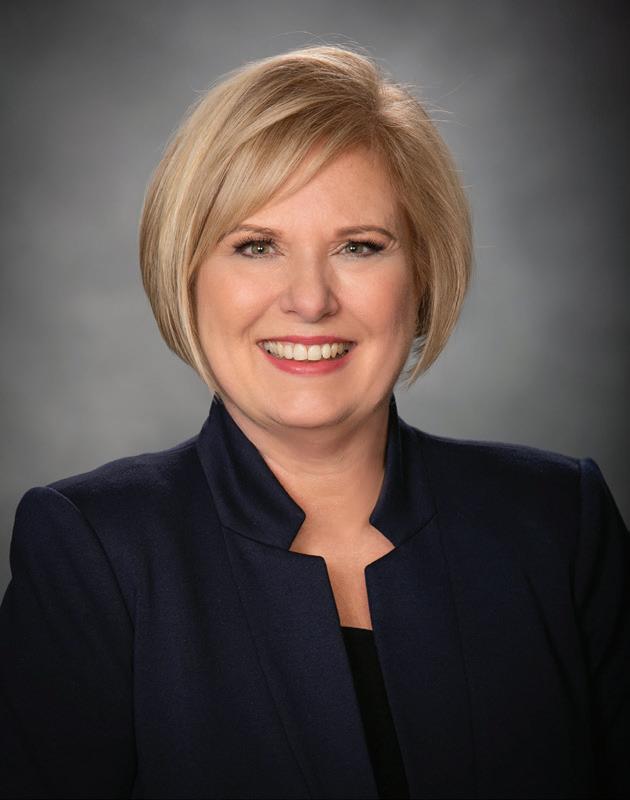
only did I help her business grow, but she also now refers others my way.
“That’s what keeps me going — mentoring women, guiding small business owners, and helping people find answers and confidence in their business journeys,” she says. “I believe giving back isn’t just charity; it’s using your experience to create opportunities for others. At this stage of my life, I feel I have more to give than ever before.”
In addition to those efforts, she’s given back in other ways, by supporting the Leukemia and Lymphoma Society as well as serving as a planning commissioner for the City of Troy.
— Michael Strong
VTECH, REDICO Soccer Stadium, Detroit City FC
Little Caesars Arena Hotel, Olympia Development
The relationship between Detroit City FC and southwest Detroit comes together with the rise of AlumniFi Field, a 15,000-seat stadium that will host the United Soccer League franchise starting with the 2027 season.
But the vision for the project’s impact is broader than that.
With the project going up on the site of the long-abandoned Southwest Detroit Hospital, both the team and people in the surrounding neighborhoods hope for real community revitalization stemming from the completion of the stadium.
Detroit City FC acquired the land in May 2024 for an undisclosed price. The team’s new home, which is expected to cost $150 million, will be located at the southwest corner of Michigan Avenue and 20th Street.
The designer on the project is St. Louis-based design, architecture, engineering, and planning firm HOK, whose vision for the project has been described as a welcoming hub bridging downtown with Corktown, Mexicantown, and other southwest Detroit neighborhoods.
Even when a match isn’t going on at the stadium, team officials believe the venue can serve to boost economic development and overall neighborhood vitality.
“We’re honored to collaborate with Detroit City FC on a project that will celebrate the club’s passionate supporters while energizing the city,” says Chris DeVolder, director of sports and recreation and entertainment at HOK. “The stadium will be a vibrant example of urban placemaking. Our design will embrace the unique site and offer fans an exceptional, hospitality-driven gameday experience.”

“This partnership with HOK marks an exciting new chapter for our stadium project and DCFC,” Mann says. “This stadium represents more than a home for our club. It’s a testament to the passion and resilience of our supporters and the spirit of our city.
Sean Mann, CEO of Detroit City FC, noted the significance of the project being driven by a new generation of community leaders.
600 Renaissance Center, Friedman Real Estate
Stellantis in Center Line, Ashley Capital Bueche Portfolio, SPERRY — Property Investment Counselors
One of metro Detroit’s most venerable industrial complexes, designed by legendary Detroit architect Albert Kahn and occupied by Chrysler/Stellantis since 1953, was sold in December 2024 to a partnership made up of Ashley Capital and CSC Capital Group.
The purchase price was not disclosed.
The complex, located in Center Line, was originally the world headquarters of Mopar, which produces original equipment parts, accessories, and customer care for Stellantis brands including Chrysler, Dodge, Jeep, Ram, and Fiat.
At its peak, the facility employed more than 1,000 people, most of whom were engaged in warehouse and packaging operations. Over time, the majority of the administrative employees moved to the Chrysler Technology Center in Auburn Hills.
The entire 1.4-million-square-foot, four-building industrial complex, which sits on 78.8 acres at the northwest corner of 12 Mile and Van Dyke roads, is set to be demolished in 2027 to make way for two new state-of-the-art distribution centers totaling 1.2 million square feet.
Until that time, however, Stellantis will continue to occupy the land on a lease basis for the operation of its Center Line Parts Distribution Center. Eventually, Stellantis will move that operation to Van Buren Township, which will be the home of a new parts distribution facility on Ecorse Road south of Willow Run Airport.
In addition to the 978,000-square-foot warehouse that serves as the parts distribution center, the Center Line campus also consists of a 135,000-square-foot office building, an 87,000-square-foot ancillary building, and a 207,000-square-foot smaller warehouse.
According to Ashley Capital, brownfield incentives will be factored into the broader development project, which will be led by Hillco/Sterling Group. Future plans for the site are expected to be announced next year.
— Dan Calabrese
“As one of the first major projects led by a new generation of Detroiters, we take immense pride in creating a place where our community can gather and celebrate for years.”
— Dan Calabrese
Fairway Packing, Fraser Dykema, Detroit Gensler, Detroit
he burgers Detroit Tigers fans enjoy at Comerica Park are produced by Fairway Packing, a longtime Eastern Market-based business whose recent growth required the company to develop a 35,000-square-foot facility in Fraser and move from its 6,000-square-foot facility in Detroit.
Grosse Pointe-based Allegra Development, owned by John Secco, was the builder. The company completed its move into the new facility last November.
“We needed a much larger facility,” says Emmet Baratta, owner of Fairway Packing. “It allowed us to equip the facility in the way we did, with the latest and greatest state-of-theart equipment.”
That equipment includes a massive burger grind operation and a laser-cutter for steaks.
The new facility, located along 15 Mile Road, has enabled the company to expand its employee base to 106 workers from the 46 people it had in Eastern Market.
“The past year has opened up a tremendous amount of opportunity for us,” Baratta says. “We’ve been able to take on stadium business such as Little Caesars Arena and
Comerica Park, and we’ve been able to open up our distribution partners to get regional chain business.”
Fairway is the supplier for burgers at two locations in Comerica Park — the 313 Grill and the Marketplace area behind the scoreboard in left field.
The opportunities have allowed Fairway to expand not only throughout the state of Michigan, but into Ohio and other parts of the country.
“It’s allowed us to ramp up our burger production,” Baratta says. “We’ve always had a really good burger, and we’ve had some of the best grinds in the business.”
Fairway has recently tripled its burger production to more than 100,000 pounds of hamburger a week. It also offers a wide range of steaks, chops, pork, lamb, veal, and both Wagyu and Piedmontese beef, among other selections.
The company had been in Eastern Market since 1986, although its family roots in the meat industry date back to 1956, when Baratta’s grandfather opened his first meat processing business in the city.
— Dan Calabrese
Eastland Commerce Center, NorthPoint Development
Fort Street Industrial Campus, Bedrock
FANUC North America, General Development
Robotics technology developer FANUC America announced in 2022 that it would be expanding its Auburn Hillsbased West Campus to span nearly 2 million square feet, including a 655,000-square-foot facility for manufacturing, engineering, and research and development.
The $110 million project was completed in June 2024 and is now operating at 2600 Featherstone Rd. in Auburn Hills, just south of Stellantis’ North American headquarters.
The project required the acquisition of 67 acres of land, plus the repurposing of the former Thomas M. Cooley Law School campus. The latter will be used to educate future employees in robotics and automation under the name FANUC Academy.
All told, the expansion added 788,000 square feet of additional operational floor space.
The contractor for the project was General Development, while GAV & Associates served as the architect.
The new West Campus facility, which provides advanced product manufacturing and customized automation systems, made its official debut in July
2024. The campus also includes warehouse space for more than 6,000 quick-delivery robots and tens of thousands of parts.
According to GlobalData, the robotics industry is expected to grow to a value of $218 billion in 2030 from $76 billion in 2023, with cloud computing and artificial intelligence the two most significant drivers of the growth.
When the facility opened, Mike Cicco, president and CEO of FANUC America, which has its headquarters in Rochester Hills, said the investment was in response to the changing demands of the marketplace.
“This major expansion represents our growth strategy in the U.S. and our steadfast commitment to the future of the automation and robotics industry,” Cicco says.
“While manufacturers continue to adapt to changing market demands, our ongoing upward trajectory allows us to better support our customers with cutting-edge robotic and automation solutions, helping to drive more efficiency across all industries.”
— Dan Calabrese

DETROIT, DETROIT
Woodlands Officentre in Farmington Hills, REDICO
New Center One in Detroit, Axis Advisors
Ven Johnson Law, Bedrock
REDICO’s redevelopment of the Woodlands Officentre in Farmington Hills was designed to give new life to an existing office building that offered good highway access and a setting characterized by natural beauty.
The 235,000-square-foot facility at 31440 Northwestern Highway presented those attributes effectively enough to achieve 100 percent occupancy; major tenants include the Sam Bernstein Law Firm, the Kirk Gibson Center for Parkinson’s Wellness, Amentum Technology, and Fishbeck, Thompson Carr & Huber. The newer tenants join longtime tenant Attorney’s Title.
“These companies collectively leased over 132,000 square feet, bringing the building up to 100 percent occupancy this year,” says David Haboian, REDICO’s senior vice president of operations. “This was an incredible achievement and collective effort (between) the landlord and tenant(s), (who collaborated) with the architects, contractors, and city officials to bring everything together seamlessly.”
Dale Watchowski, REDICO’s president and CEO, took a leadership role in conceiving and completing
the redevelopment project, along with Haboian and a larger team.
The accommodations made for the Kirk Gibson Center were especially noteworthy, as the organization renovated 40,692 square feet to offer programming for individuals living with Parkinson’s disease. The effort involved the removal of walls and the development of a fitness room, a spin studio, second-level walking track, locker rooms, a boxing room, training rooms, and offices.
The newly refurbished Woodlands Officentre is characterized by a park-like environment that includes award-winning landscaping and natural space, with walking trails winding through 8 acres of undeveloped woodlands. The facility also includes a full-service fitness center available to all tenants, and on-site dining facilities that bring in local guest restaurants to offer daily meals.
It also offers secure underground parking with EV charging stations. “(This has) been a home run for our tenants and REDICO,” Watchowski says.
— Dan Calabrese
Hudson’s Detroit, Bedrock
Newlab, Ford Land
Fisher Building, Michigan State University
Rising above downtown Detroit on the site of the old Hudson’s Department Store on Woodward Avenue, Bedrock’s new Hudson’s Detroit development establishes a new level of Class A amenities for office facilities in the metro area.
The tower structure is 685 feet — short of the distinction of the Detroit Marriott at the Renaissance Center — while a neighboring midrise building spans 12 stories and features more than 400,000 square feet of Class A office space, with General Motors as the primary tenant. Ven Johnson Law and Accenture also have committed to lease office space in Hudson’s Detroit, along with Rock (Dan Gilbert's family office) and the Gilbert Family Foundation.
Among the midrise facility’s other amenities are 13,000 square feet of private terraces on its fourth through 11th levels, surrounding a 9,000-square-foot central atrium with work spaces. Hudson’s Detroit was designed to offer flexibility in office floor plans, with 46-by-30-foot column spacing being adaptable for a variety of sizes and uses. A restaurant is planned on the top floor.
“The development is redefining the modern office building, with on-site meeting and event space, a seven-story atrium, a fitness center, a tenant lounge, and underground parking,” says Naumann Idrees, senior vice president of leasing at Bedrock.
Office tenants will enjoy a 360-degree city view, along with 24/7 security, and a wide variety of on-site and neighboring retailers including 6 Salon, Gucci, Shinola, Lululemon, Citizen Yoga, Nike, Apple, Alo, Tecovas, and several more that have yet to be announced.
Other features include concierge services, private fitness training rooms exclusive to office tenants, bicycle storage, and three floors of meeting and event space for large-scale conferences as well as smaller gatherings.
Architects on the project, which got its start in 2017, were SHoP Architects and Hamilton Anderson Associates. The office building will open early next year, followed by the residential and hotel tower in 2027.
—
Millennium, Friedman Real Estate
LuxWall, Bedrock
Livonia Commerce Center, Livonia
Detroit’s Delray neighborhood is getting a major boost from the decision by LuxWall to lease a new, 276,000-square-foot facility along Fort Street that has been developed by Bedrock. Construction began late in 2024 and the facility is expected to be completed and ready for operation next year.
It's Ypsilanti-based LuxWall’s second production facility, and is expected to employ 277 people when it’s fully operational.
LuxWall manufactures vacuum-insulating glass that’s designed to produce the same energy-efficiency as a conventional wall. Using a material known as LuxWall Enthermal VIG, the company says the product is five times more insulating than double-paned glass and reduces energy loss by 45 percent.
According to LuxWall, Enthermal VIG is ideal for retrofitting buildings, due its thin profile — which makes it easy to install in existing window frames. The company states the product can produce a
payback three times faster than other glass products.
“LuxWall’s decision to expand in Detroit represents the perfect intersection of innovation, sustainability, and inclusive economic development,” says Jared Fleisher, president of Bedrock. “It’s a testament to what’s possible when mission-aligned partners come together with a shared commitment to revitalizing our neighborhoods. We’re proud to welcome LuxWall to the historic Delray District and we look forward to seeing the impact their technology will have not just in Detroit, but across the globe.”

The project got a boost from a $31.7 million grant from the U.S. Department of Energy, along with a successful round of Series B funding led by Climate Investment and Barclays Sustainable Impact Capital.
Cosm, Bedrock
Kirk Gibson Center for Parkinson’s Wellness, REDICO
Maxx Sports Arena, Friedman Real Estate
Bedrock’s Development at Cadillac Square in downtown Detroit looks to take immersive technology and media to another level by offering Cosm’s Shared Reality sports and entertainment concept at its nucleus.
Cosm’s technology provides “sensorial experiences” for sports and entertainment fans, bridging the virtual and physical worlds to make those who are present feel as if they’re part of the experience. It’s as if every guest has a front-row seat.
Detroit-based architectural firm Rosetti is designing the Cosm Detroit project, which will feature a 26.6-meter, 12K-plus LED dome, and Shared Reality technology. It will feature sports and entertainment programming from NBC, UFC, TNT Sports, ESPN, Fox Sports, and the National Football League.
Other experiential content will include a production of Cirque du Soleil’s “O” and immersive art experiences from creators such as new media artist Nancy Baker Cahill, Planetary Collective co-founder Guy
Reid, and composer/new media artist Ricardo Romaneiro.
Cosm also will present a film titled “Inside Pop Art,” which will include works from guests including Roy Lichtenstein, Jean-Michel Basquiat, and Keith Haring.
Bedrock officials say the project is designed, in part, to bring a revival to Detroit’s historic Paradise Valley entertainment district. The Cosm feature is part of a broader 1.5-million-square-foot Development at Cadillac Square project.
“Cosm Detroit is a game-changer, not just for downtown but for how we think about sports, entertainment, and placemaking in urban centers,” says Jared Fleisher, president of Bedrock.
“Being recognized underscores the power of visionary partnerships and the role bold ideas play in reimagining our city’s future. Cosm will be more than an experience; it will be a destination that brings people together to cheer for their teams, and it celebrates the spirit of the city of Detroit.”
— Dan Calabrese
— Dan Calabrese
Finalists
Hudson’s Detroit, Bedrock
Sakura Novi, Sakura Novi LLC/Robert B. Aikens & Associates/Robertson Brothers Homes
JW Marriott Detroit at Water Square, Sterling Group
With the Asian community’s impact on metro Detroit’s economy continuing to grow, especially in western Oakland County, the concept of an Asian-themed retail and mixed-use development fits the region more than ever.
The vision drove Robert B. Aikens & Associates in Birmingham, and parytners, to form Sakura Novi and pursue a new mixed-use development of the same name.
Sakura Novi includes three elements. The first is an apartment complex featuring 132 town homes built by Robertson Brothers Homes in Bloomfield Hills. Next is a 43,000-square-foot retail development offering a wide selection of stores and restaurants that will make their individual debuts in the coming weeks.
The third element is a Japanese-themed garden path, which includes a playground and a sensory garden.
The entire development sits on 16 acres at Grand River Avenue and Town Center Drive in Novi.
Scott Aikens and Phil Kim are the partners at Sakura Novi, while Darian Neubecker headed up the residential building
portion for Robertson Brothers Homes.
The project has had a long development time.
“It was begun before COVID-19, around 2018,” Scott Aikens, vice chairman of Robert B. Aikens & Associates, said during a mid-September interview. “We’re completing it right now. The first 50 people live there and the first store opened a couple weeks ago.”
The initial store is a family arcade called Klawsome! It will soon be joined by Paris Baguette, Chubby Cattle Wagyu House, a Korean steakhouse called Dancing Pine, and a Japanese bookstore known as BookOff. The retail portion will also feature an Asian-themed department store called Tessa Life.
“The Asian-themed restaurant and retail collection were designed to be a cultural contribution to the region,” Aikens said.
According to Aikens, a small second phase is planned for an unspecified point in the future, and will include 14 additional town homes. A larger subsequent phase is expected to add another 45 apartments, but, he noted, “that’s a little ways away.”
— Dan Calabrese
City Modern, Bedrock
Birmingham Pointe, FHS Birmingham
Mystic Cove, Moceri Cos.
Where luxury meets technology — and adds a generous helping of amenities — is where you’ll find the innovative development known as Birmingham Pointe.
The 358,000-square-foot mixed-use community, located at 707 S. Worth St. in Birmingham’s Triangle District, is the product of a three-way partnership between The Forbes Co., Hunter Pasteur, and Soave Real Estate. Collectively the group is known as FHS Birmingham.
The project offers 152 residences including one-, two-, and three-bedroom apartments, along with 10 penthouses that range from 1,850 to 2,175 square feet and boast expansive layouts and panoramic views. The homes are augmented by 4,400 square feet of retail, an integrated parking garage, and 35,000 square feet of resident amenities.
The latest technology includes eight-gigabit internet speeds for each home, roaming Wi-Fi coverage throughout the property, and access control technology for keyless building, garage, common area, and home entry. In addition, residents are provided with advanced communication, building, and community services via the Livly app.
Neumann/Smith Architecture served as the architect of record, with Christopher J. Longe AIA as the designer. M. Shapiro Real Estate Group manages the property.
“Birmingham Pointe’s finishes, design, and amenities are like no other project in the state,” says Nico Schultz, senior vice president of Soave Real Estate. “The amenity-rich living with technology is one of the concepts that drove Birmingham Pointe’s design and development.”
Other features include a 3,000-square-foot, hotel-styled lobby; a 12,000-square-foot landscaped rooftop with a pool, a spa, cabanas, gathering areas, and fire pits; and a 5,000-square-foot indoor entertainment venue knows as “The Club” — including a kitchen, a game lounge, club rooms, and private dining.
The European-style landscaped courtyard spans 8,000 square feet. There’s also a 5,000-square-foot fitness center and 1,500 square feet of workshare space, a curated art collection with more than 200 works, and a luxury pet spa with an indoor dog park.
— Dan Calabrese
Big Rock Italian Chophouse, Luna Entertainment/Cameron Mitchell Piquette Flats, REDICO/The Platform Red Arrow Lofts, Hunter Pasteur/ Oxford Capital Group/The Forbes Co.
The iconic Big Rock Italian Chophouse in Birmingham almost didn’t make it to the list of renovation projects embraced by Columbus-based Cameron Mitchell Restaurants.
“It’s such a beautiful building,” says Steve Weis, vice president of development for Cameron Mitchell. “The first time we actually looked at it, it was still operating as the former incarnation of Big Rock, with Norm and Bonnie LaPage (as owners), but they were near the end of their run.
“At first we thought it was a really big project and we weren’t sure we wanted to take it on,” he adds. “So initially, we decided not to do it.”
Enter Tom Celani, CEO of Luna Entertainment in Novi, and Dario Bergamo, CEO of The Globale Group in Warren and a former cigar bar proprietor.
“Dario and I brought the idea of adding an expanded cigar lounge on the second floor of the



building to Cameron Mitchell, along with other components, and he liked the new concept,” says Celani, an investor in the project with the restaurant group. “Now, Dario is there almost every night helping to oversee the cigar bar.”
From there, Mitchell brought in Buckeye Hospitality Construction, which subsequently connected with a variety of Detroit-area subcontractors. The design was handled by Chicago-based Mark Knauer. Work began in early 2024.
“It’s so iconic,” Weis says. “You don’t build buildings like this anymore, (with) the beautiful slate roof and the barrel vault ceiling in the main dining room. There were pieces of it that were just spectacular.”
While the outside remains primarily the same, apart from a mostly new roof, the interior was completely redone. New features include a four-season

room that opens to a patio, a new kitchen, and an expanded dining room as well as a relocated bar.
The new Big Rock Italian Chophouse opened July 15, 2025.
“Obviously it was such a beautiful building that we wanted to honor that,” Weis says. “We probably spent more money than we originally planned to rehab it, but we think it’s a community icon.”
— Dan Calabrese


Kirk Gibson, Kirk Gibson Center for Parkinson’s Wellness
Frank Venegas Jr., Cadillac Urban Gardens Anthony and J.J. Curis, Little Village (Detroit)
When iconic Detroit Tigers outfielder Kirk Gibson announced in 2015 that he had been diagnosed with Parkinson’s disease, it proved to be far from the end of the story.
In true Gibson fashion, it was the start of a fight that was destined for victory not only for Gibson himself, but for many others who found themselves struggling with Parkinson’s.
One of that fight’s most prominent wins has been the establishment of the Kirk Gibson Center for Parkinson’s Wellness, which opened in August at REDICO’s Woodlands Officentre in Farmington Hills after eight years of fundraising. The grand opening took place exactly 30 years to the day Gibson retired from the Tigers to end his career as a major league player.
The 40,692-square-foot facility provides myriad amenities and services for those dealing with Parkinson’s. Offerings include a fitness room, a spin studio, a walking track, locker rooms, a boxing room, and training rooms, along with cognitive improvement programs including
speech therapy, art and music therapy, and a variety of educational sessions on issues like safety and nutrition.
Other features include a cafeteria, music rooms, quiet spaces, and social lounges to bring together patients, visitors, and caregivers.
“Opening this Parkinson’s Center means providing a center of hope for anyone fighting the battle with Parkinson’s,” Gibson says. “Every step forward, every breakthrough we make together, reflects the strength we find in each other. This journey is personal, but it’s also for all those who need to know they’re not alone.”
Steve Annear, CEO of the Kirk Gibson Foundation for Parkinson’s, says the Woodlands facility provides the organization with a unique combination of an easy-to-access location and state-of-the-art spaces.
“The design of the building itself is a great fit for the programming we’ll provide and the community we aim to build,” Annear says. “Our partnership with REDICO has been important to making this happen.”
— Dan Calabrese
Dearborn Inn, Ford Land
Vanguard Hotel, Robert Finvarb Cos./Milford
Singer & Co.
AC Hotel Detroit at the Bonstelle, Roxbury Group
Originally built in 1931 by Henry Ford and designed by legendary architect Albert Kahn, the 135room Dearborn Inn reopened on March 19, 2025, after a sweeping renovation that began in 2023.
With Ford Land leading the effort, design partners included AvroKO, Dash Design, Kraemer Design Group, and restoration architect Quinn Evans.
While the renovation preserved much of the Dearborn Inn’s historical characteristics, including checkerboard marble flooring and the green marble fireplace in the lobby, it added several new concepts.
One is Clara’s Table, a farm-to-table restaurant inspired by Ford’s wife, Clara, who loved gardening. There’s also a craft cocktail bar known as Four Vagabonds, inspired by the legendary road trips taken by Henry Ford, Thomas Edison, John Burroughs, and Harvey Firestone.
Interior features include original Platner chairs, Eames furniture, and a variety of bespoke pieces from local artisans. Each guest room has a fourposter walnut bed.
INN,
In total, the Dearborn Inn has 95 standard guest rooms, 20 deluxe rooms, 16 junior suites, three vice presidential suites, and one presidential suite.
Before the end of the year, Ford Land is expected to complete the restoration of five Colonial-style historic homes on the property that offer a total of 18 rooms, including three standard guest rooms, 12 suites, the Edgar Allan Poe suite, and two hospitality suites.
Other amenities include a 24/7 fitness center, an expansive patio, and an outdoor fire pit.
“From the moment guests step through our doors, we want them to feel inspired by the history that surrounds them and by the trailblazers who once walked these halls,” says Joleisha Bradley, general manager of the Dearborn Inn, part of Marriott Bonvoy’s Autograph Collection.
“The hotel is both a welcoming retreat and a living museum, with historic artifacts woven throughout the property,” she adds. “We look forward to continuing the tradition of hospitality that has made Dearborn Inn so beloved.”
— Dan Calabrese



















































LYNN DRAKE Founder of Compass
Commercial
ld@compass-commercial.com www.compass-commercial.com
Lynn Drake, owner of Compass Commercial, began her career in 1985 as one of only 14 women in industrial real estate at Central Transport. She spent 15 years in corporate real estate before founding Compass Commercial, a tenant-focused brokerage now celebrating 15 years of service. Lynn has dedicated her expertise to supporting nonprofits, saving organizations millions of dollars, including more than $1 million in rent for the Girl Scouts on a major relocation. She has also assisted Gifts for All God’s Children, The Troy Chamber and other community groups. With over 1,700 transactions, she pairs industry knowledge with community service.



Ever-shifting tari and immigration policies make it di cult for companies to set growth plans in the United States, Michigan, and metro Detroit.







Economic forecasts are di cult enough under normal circumstances.
Global events, natural disasters, pandemics, and consumer whims can turn the most scienti cally based prediction on its head at a moment’s notice.
But President Donald Trump’s unconventional tari policies are making corporate planners and economists’ jobs even more challenging.
Although economic prognosticators are cautiously optimistic about the fortunes of the national, state, and local economies, every forecast begins with the words “depending on what happens with tari s.”
“Clearly the Trump administration strategy is different and a dramatic economic change from the coalition that was built around free trade principles starting from the Eisenhower administration,” says Sandy K. Baruah, president and CEO of the Detroit Regional Chamber. “We don’t know what the results of that are going to be, but certainly the short- and medium-term e ects for manufacturing states like Michigan are clearly going to be challenged.
He adds that the tari policy has been uncertain.
“ e tari s come on and o . ey get increased. ey get decreased. ere are tentative deals that are announced, but details aren’t known. It’s a very dynamic strategy that makes it very hard for capital-intensive industries like manufacturing to plan and to invest.
“It’s also very hard to make cap ex decisions like building factories and moving production lines if you don’t know what the rules of the road are going to be,” he adds.
Shooshan Danagoulian, associate professor of economics at Wayne State University in Detroit, says she expects “cautious growth” in the next year, but the uncertainty about tari s could cause a slowdown.
“ e economy in the United States is facing quite a bit of uncertainty for next year,” Danagoulian says. “ ere’s a lot of business uncertainty around tari policy, as well as federal contracts and federal regulations around contracts. A lot of businesses are pausing major investments and certainly pausing hiring. In the employment market, there’s a lot of wait-and-see happening.
“If or when tari s become permanent, businesses will be able to decide whether to pass the increased costs on to consumers or to absorb the costs and decrease investment and employment.”
In August, The Conference Board predicted that higher tariffs are set to weigh on real GDP growth in the second half of 2025 and into 2026, as consumers are expected to bear the brunt of higher prices.
COST PERSPECTIVE
Businesses large and small are navigating new economic policies that encourage domestic production at a time when access to skilled and specialized trades is waning.

“Businesses will navigate the tariff landscape with more clarity than was the case earlier this year,” the prediction continued. “Even though tariffs could eat into their profit margins, accelerated depreciation, one of the key provisions in the latest fiscal legislation, could incentivize business investment in the coming months.”
The Conference Board estimates the bulk of tariffs will impact Q4 and early 2026.
Foreign trade remains the sector with the biggest question marks surrounding the economy, according to Michael Wolf of the Deloitte Global Economics Research Center.
“Tari details are being changed frequently,” Wolf recently wrote. “Two federal courts ruled against President Trump’s use of the International Emergency Economic Powers Act (IEEPA) to impose tari s on trading partners. On May 28, the Court of International Trade invalidated the tari s on a nationwide basis, while a separate court invalidated the application of tari s more narrowly on the two plainti s in the lawsuit.
“Both rulings have been temporarily stayed and the cases are in the process of appeal, which has made the future path of tari s and trade policy even more uncertain. Further, the rulings do not apply to tari s imposed under other statutes.”
e Trump administration insists the increased revenue from the tari s will lead to all sorts of positive outcomes — including paying down the national debt, for one.
O cial U.S. data shows that in June 2025, tari revenues were $28 billion — triple the monthly revenue seen in 2024. e U.S. Treasury reported August tari receipts of $29.5 billion after being at $27.7 billion in July.
e Congressional Budget O ce estimated in June that the increase in tari revenue, based on the new U.S. tari s imposed between January and May 2025, would reduce cumulative U.S. government borrowing costs over the next 10 years by $2.5 trillion.
O cials also say tari s will encourage foreign companies to manufacture more in the U.S., incentivize U.S. companies to reshore manufacturing, and ultimately grow the economy.
Apart from tari s, at the national level, in ation and a soft labor market caused the Federal Reserve Board to lower interest rates .25 percent, to 4.25 percent, in September after holding rm at 4.5 percent to ght in ation.
e Fed decided to cut the rate, under pressure from the White House to cut the interest rate even more. Its hesitancy and the .25 percent cut came with the Consumer Price Index nudging to 2.9 percent in August, above the Fed’s 2 percent target. It also came as the labor market began showing signs of weakness, taking back almost 1 million jobs from previous reports.
“Our tools can’t do two things at once,” Federal Reserve Chairman Jerome Powell said at the time. “What we do is we ask is how far is each (in ation and employment) from the goal, and how long is it expected to get to the goal?”
ose questions should be answered when the Fed makes the two additional interest rate cuts it signaled at the last meeting.
According to the Michigan Department of Treasury’s latest report, the U.S. can expect modest economic growth throughout the next three years. Real, or in ation-adjusted, Gross Domestic Product (GDP) is forecast to rise 1.1 percent in 2025, 1.3 percent in 2026, and 2.1 percent in 2027.
(Gray areas represent a recession.)






































































































































Source: U.S. Bureau of Labor Statistics



U.S. wage and employment gures are set to increase over the forecast horizon, rising by 1 percent in 2025, .3 percent in 2026, and .8 percent in 2027.
e U.S. unemployment rate is forecast to increase to 4.4 percent in 2025, 4.9 percent in 2026, and 4.8 percent in 2027, due in part to expected increases in the national labor force.
Housing starts, meanwhile, are expected to grow by .6 percent in 2025 and increase by 2.7 percent in both 2026 and 2027.
With tari s a ecting prices, light vehicle sales are forecast to decline slightly to 15.7 million in 2025 and 15.5 million in 2026, but then they are expected to increase to 15.7 million in 2027.
e pace of in ationary growth, according to the Michigan Treasury, is forecast to increase, and then fall back to its 2024 level. e Consumer Price Index, which rose by 2.9 percent in 2024, is predicted to rise by 2.9 percent in 2025, advance by 3.5 percent in 2026, then increase by 3 percent in 2027.
New data released in September by the U.S. Bureau of Labor Statistics con rms that the Trump administration’s across-the-board tari s are increasing in ation. e report shows in ation ticking up in August, with the Consumer Price Index rising by .4 percent month-over-month and 2.9 percent year-over-year.
Core in ation — which strips out food and energy — rose .3 percent in August and 3.1 percent annually, matching July’s pace. Rising costs for shelter, food, and gasoline all contributed to the increase.
Since April, Trump has imposed across-the-board tari s of 10 percent to 50 percent on nearly all imports, with higher rates for dozens of countries and industries. e average tari rate now tops 18.6 percent, the highest since 1933. While some businesses initially absorbed the cost, companies are starting to pass the increases on to consumers, according to the Bureau of Labor Statistics.
Tari s are upendeding global trade, but at the same time, have generated new revenue for the federal government.

What are the e ects of tari s and interest rate cuts on businesses in Michigan? Tari s are expected to hurt the auto industry, while the Fed’s interest rate cuts could bene t both automakers, who rely on loans to move their products, and the mortgage industry, which has a heavy presence in southeast Michigan with Rocket in Detroit and United Wholesale Mortgage in Pontiac.
“When you think about Michigan’s industrial mix, you have automotive and mortgage that are sensitive to interest rates,” says Gabriel Ehrlich, an economist at the University of Michigan in Ann Arbor. “We do expect the rates to keep coming down and that will help these industries. We expect slow economic growth and job growth to continue at a moderate pace. e uncertainty about tari s makes it really hard to plan, and that has e ects.”
Wayne State’s Danagoulian says, “Michigan is particularly vulnerable to tari s because of the auto industry’s production process. Even American cars are made with parts that are often made outside the United States. Any tari s that are implemented will be hitting these industries. And Michigan businesses, being so close to Canada, are impacted by the trade war between those countries.”
She notes that some small businesses may have to le bankruptcy to restructure their debts because of contracts that are no longer viable, depending on how the tari s shake out.
Despite the turmoil, the Michigan Treasury says it expects employment in the state to grow .6 percent by the end of 2025 and increase by .4 percent in 2026 and 2027. It expects the wages and salaries of Michiganders to grow 3 percent in 2025, 3.3 percent in 2026, and 3.4 percent in 2027.
In May, the Michigan House Fiscal Agency projected a moderately weaker employment picture than the national economy with slower employment growth, averaging about .4 percent annually, and the unemployment will peak at 5.9 percent in 2026 before falling to 5.7 percent in 2027.
e same report forecasts Michigan wage and salary employment to increase by .4 percent in 2025, .3 percent in 2026, and .4 percent in calendar year 2027. Michigan’s unemployment rate is expected to increase to 5.6 percent this year and 5.9 percent in 2026, before decreasing to 5.7 percent in 2027.
Ehrlich says U-M research projects that the state’s economy will continue to grow moderately over the next two years.
“We expect tari s to reduce employment in Michigan’s auto industry by a little over 5,000 jobs,” Ehrlich says, “but the reason we’re forecasting growth in Michigan is because of the growth in noncyclical industries like education, health, government, and leisure and hospitality.”











“We’re still way too dependent on the auto industry,” Huszczo says. ‘In Michigan, the biggest positive GDP percentage changes were in construction, information technology, and real estate. e agriculture segment is down and has taken the biggest step backward as a result of the tari situation.”

Michigan, however, faces employment headwinds more daunting than other states.

Unlike other states, Michigan “is actually dependent on international immigration and, with Trump’s policies, that’s kind of stalling,” Huszczo adds. “Because of the business dynamics, which don’t compare favorably to other states, we might not be able to rely on a large amount of international immigration, which might make it a tougher path for Michigan.”

Its unemployment rate increased faster than the national average over the past year, while many rural counties in the state are experiencing deepening economic distress, according to a Labor Day report released by the Michigan League for Public Policy.
e report, “A Snapshot of Michigan’s Workforce,” determined that Michigan had the fourth-highest unemployment rate in the nation, at 5.3 percent as of June 2025, compared to the national average of 4.1 percent.
Meanwhile, more than half of Michigan’s counties — 54 out of 83 — reported unemployment rates of 6 percent or higher, with rural communities hit the hardest.
e report also found that workers’ real earnings are being eroded as wage growth in Michigan is being outpaced by rising costs, with 27 percent of Michiganders reported to be employed, but under the classi cation of “asset-limited and income-constrained.”
In 2024, only two major Michigan industries surpassed the job growth rates of their national sector counterparts, according to the Michigan Center for Data and Analytics: Financial Activities and Construction. e government sector in Michigan and the U.S. noted the same change rate between 2023 and 2024 (2.5 percent), while information technology saw the greatest reduction in average payroll employment (-2.6 and -2.1 percent, respectively) across the state and nation.
One area of Michigan’s economy that experts are pointing to is Detroit’s modest increase in population.
“What cuts through everything is population growth,” says Sam Huszczo, founder and chief investment o cer at SGH Wealth Management in Lathrup Village. “Without population growth it’s difcult for an economy to kick into gear. With 1.1 percent population growth, Detroit ranks better than the state and nation.
“ e population growth has been encouraging. Also encouraging, payrolls are up modestly. All of that is encouraging and a bedrock to continue the growth. I anticipate more good things to happen from that standpoint.”
Like U-M’s Ehrlich, Huszczo looks for growth in areas apart from the auto industry.
INFLECTION POINT
As
Ehrlich says, “ ere’s no question that the population growth we’ve seen is a positive sign. As we look forward, we see immigration slowing down — and what does that mean for the positive trends? ere are real questions as to what that’s going to look like.”
To combat the negative outlook and spark positive changes, the state of Michigan has been investing in talent retention and population growth initiatives, which o cials say are paying o .
“We’re cognizant that there’s economic uncertainty, but the good thing for Michigan is there’s a good wind at our back because of the strategic investments that we’ve made that are really starting to pay o (talent retention, housing, child care, community college scholarships, and support for entrepreneurship and innovation, for example),” says Hilary Doe, chief growth o cer for the state of Michigan.
“Detroit’s population grew, but so did Flint’s. Most importantly, (included) in those trends are young adults, (and that) number is growing faster than in 45 other states. It implies that things are going in the right direction.”
Another plus in Michigan’s favor is its emergence as a leader in forward-looking technologies to boost economic opportunities.
“Michigan has been a leader in energy jobs, with one of the fastest energy sectors in the country and some of those in clean energy manufacturing,” Doe says. “ at’s a positive sign of our economic diversi cation, along with the fast-growing entrepreneurship and innovation ecosystems. We also have a fast-growing defense and aviation industry.”
An area of concern to the auto industry, and in turn the southeast Michigan economy, is the Trump administration’s de-emphasis on clean energy and, in particular, electric cars.

“Electri cation of vehicles has become political, which is unfortunate,” says the Detroit Regional Chamber’s Baruah. “Electri ed vehicles certainly aren’t for everyone today. ey’re right for some people and very wrong for other people. It’s very clear that the mobile industrialized world is moving to a more electri ed vehicle eet.
“ e fact that our industries, our OEMs, our Tier 1s and our Tier 2s have invested so heavily in electri cation and now have had the rug pulled out from under them means they’ve wasted a lot of their hard-earned shareholder money in a strategy that the U.S. government will no longer support and/or we’re about to cede 25-35 percent of the global vehicle market to other countries, namely China, that have a leadership position in electri cation.”
U.S. economic and immigration policies and their in uence on Michigan naturally have a trickle-down e ect to southeast Michigan and the city of Detroit.
Despite the headwinds, U-M economists say Detroit is expected to see an increase in jobs, wages, and resident employment in the next ve years.
Among the highlights of the U-M August report:
• Wage growth at jobs located in the city will average 3.2 percent annually from 2025 through 2030, faster than the state of Michigan overall. After adjusting for local in ation, Detroit residents’ average real wages are expected to climb to 4.9 percent higher in 2030 than in 2019. Although that may seem modest, it outpaces the growth in average real wages at Michigan and Detroit establishments.
• Detroit is expected to add an average of 1,500 payroll jobs per year during the forecast period, an annual growth rate of .6 percent. Economists forecast resident employment to rise by an average of .4 percent annually. e slightly slower average growth of resident employment re ects its stronger recovery since the pandemic, which leaves less room for catch-up growth.
• Detroit’s unemployment rate is expected to continue rising through the rst half of 2026, reaching 10.2 percent in the second quarter. Michigan’s unemployment rate is projected to peak at 6 percent in the same period. e forecast calls for the city and state unemployment rates to decline in the following years, as lower interest rates work their way through the economy. By 2030, Detroit’s jobless rate should decline to 8.9 percent, while Michigan’s rate falls to 5.6 percent.

BY DAVID L. LITTMANN
Areview of my forecasts for calendar years 2024 and 2025 was eye-opening, as they proved accurate. But in two especially fateful ways, they referenced the twin evils that plague our economy and financial outlook for 2026 and beyond.
Careless, unprofessional federal data-collection and reporting practices, along with the politization of the Federal Reserve, constitute a third-stage cancer throughout the economy.

These cancers must be removed permanently if the nation is to succeed.
Fortunately for the 2026 outlook, it appears real GDP growth and the average inflation rates will both average 3 percent. Interest rates will be lower, in recognition of recent policies by Washington to reduce crime and to expand net exports and stable prices via mutually agreed-upon tari rates with our trading partners.
These initiatives are bolstered by lower tax rates and new incentives aimed at raising overseas investments in the U.S., together with lowering cost-curves for both large and small firms. Real wealth, purchasing power, savings, and investments are the classical keys to higher productivity and innovation for our future.
accelerated an already burgeoning cost of U.S. debt, now approaching $38 trillion.
Massive errors and data revisions compel forecasters to revise the basepoints from which 2026 activity can be confidently estimated.
Poor data-collection, like defective products, wastes time and money by deceiving data users, consumers, businesses, and policymakers. Damage also is done to both the private and government sectors of our economic system.
Persistently large misreadings of our vital data bases further erode confidence in what government says and does.
Even more diabolic is the out-of-control federal spending. If we plan to survive as a nation beyond our 250th anniversary, the Federal Reserve must refuse to monetize debt by saying “no more” to the U.S. Treasury.

• e number of jobs at Detroit establishments will recover to the pre-pandemic level by the second quarter of 2026, and researchers project it to rise to 3.1 percent above that level by the end of 2030. Resident employment is projected to surpass its pre-pandemic level by 4.5 percent at the end of 2030 and exceed its 2023 peak by 1.4 percent.
• Higher tari s will weigh on employment in Michigan’s transportation equipment manufacturing sector over the next several years. Subdued expectations for statewide growth in the auto sector feed into the forecast for Detroit’s economy. Industries expected to see job gains over the forecast years include nance, leisure and hospitality, and public administration.
“We believe Detroit’s rmer footing augurs well for its economic performance over the next several years,” the economists, including Ehrlich, say in their report, “but the outlook is clouded by a high degree of uncertainty over the course of economic policy.”
Huszczo, of SGH Wealth Management, also is bullish on Detroit’s economic future yet cautions against “irrational exuberence.”

“Detroit is on a growth path, but it’s more vulnerable to unexpected events than an average U.S. city,” he says. “What we learned from the COVID-19 experience is that even though Detroit is on a growth path, any derailment from that path results in the economy being hit hard. Detroit doesn’t have the kind of wealth and assets to easily weather that storm.”
Ultimately, “the way the auto industry goes might be putting a damper on Detroit, as well,” he adds.
e uncertainties caused by national policy could at least be holding Detroit’s growth back, if not hurting it directly, according to Maureen Donohue Krauss, president and CEO of the Detroit Regional Partnership.
In September, we learned that data released from 2024 through mid-year 2025 was grossly overstated when reporting growth in U.S. employment and GDP.
Revisions revealed that the U.S. economy slid into a mini recession entering 2025. In addition, the Bureau of Labor Statistics overstated U.S. inflation rates between April 2024 and March 2025.
This overstatement slowed real GDP growth, largely because Federal Reserve monetary policies during 2024 and early 2025 made borrowing costs more expensive, which a ected prospective home buyers, builders, and other private sector industries. It also


Careless spending is the most treacherous economic threat we face. It might re-elect politicians, but it inevitably destroys the economic system. True independent status, granted by Legislative statute to the Fed in 1913, buttresses its stand against purchasing escalating mountains of new debt, now nearly double the value of GDP.
At the same time, the dollar continues to wither on the vine.
Interest costs on current federal debt alone exceeds $1 trillion annually. This cost is demonic, and crowds out private enterprise while supporting a bankrupt and bloated public sector, including the Central Bank and much of the welfare state.
Economic suicide is an inevitable outcome of such trends — a conclusion justified by reasoned logic, unequivocal empirical evidence, and fundamental economic texts written by the finest monetary and economic thinkers and practitioners since 1776.

A frequent contributor to DBusiness magazine, David L. Littmann is a senior economist with the Mackinac Center for Public Policy in Midland. Previously, Littmann served for 35 years as senior vice president and chief economist at Comerica Bank in Detroit.

It’s often said the only certainties in life are death and taxes, but business leaders frequently cite Michigan’s flat 6 percent corporate income tax rate and other levies as impediments to attracting new companies to the Great Lakes State.
The state’s corporate tax rate is 0.5 percent lower than the national average of 6.5 percent and ranks 26th in the country, according to the Tax Foundation.
Neighboring Wisconsin has a 7.9 percent corporate income tax rate, while Illinois and Indiana charge 9.5 percent. Ohio has a commercial activity tax, which is a tax on a company’s gross receipts.

But Michigan does carry one of the highest gas tax rates in the nation, with a base rate of 48 cents per gallon — and that could make a company think twice about moving here, especially if it’s a business that relies on transportation.
“There are a lot of elements in the state, particularly taxes, that aren’t very business-friendly,” says Sam Huszczo, chief investment o cer at SGH Wealth Management in Lathrup Village.
Michigan’s tax rates are generally middle of the road compared to other states, but the tax burden for residents can vary depending on individual and city-specific income taxes. For 2025, the Tax Foundation ranks Michigan’s overall tax system 14th nationally for its competitiveness.
Michigan uses a flat 4.25 percent individual income tax rate, which is relatively low compared to the top tax brackets of states with a progressive tax system.
The state started collecting income tax in 1967, when it set a 2.6 percent rate. It jumped to 3.9 percent in 1971 and 4.6 percent in 1975. The tax rate reached its apex for a few months in 1982 before settling at 4.25 percent in 2015.
Michigan’s income tax is high compared to its neighbors. Indiana collects 3 percent from its workers and Ohio reportedly is working toward a lower flat tax.

Yet, Michigan’s 6 percent (since 1994) sales tax rate is lower than Indiana’s 7 percent and Ohio’s 7.2 percent combined state and local sales taxes. Michigan is one of only 13 states that doesn’t permit local sales taxes, which helps its ranking as the 38th lowest sales tax in the nation.
According to SmartAsset, Michigan’s average e ective property tax rate is 1.34 percent of a home’s market value, which is higher than average compared to many other states. Michigan, however, doesn’t impose an inheritance or an estate tax, which can make it attractive for high-net-worth individuals.
David L. Littmann, a senior economist with the Mackinac Center for Public Policy in Midland, recommends Michigan adopt a zero-income tax-policy.

“With this suggestion comes the equally urgent and powerful recommendation that Michigan gather its best private and public sector brainiacs to present a MOGE counterpart to DOGE (Department of Government E ciency),” Littmann says. “DOGE was a starting point for the national e ort to reduce waste, fraud, subsidies, and abuse in government budgets.

“Fifty years ago, Michigan sparked the Michigan E ciency Task Force to do much the same thing. For Michigan, nothing would be more fitting than to inaugurate a Michigan equivalent with a serious deadline. It would blend in with the spirit of what made Michigan great and honor the state’s contribution to 250 years of America’s economic pre-eminence.”
— Tim Keenan

Michigan doesn’t have a tax problem; rather, the state itself fails to deliver services that allow companies to expand unencumbered by multiple regulations and delays.

“ ere’s pent-up demand from companies that have been waiting for more certainty to announce new locations or start to build a facility,” Krauss says. “ e pipeline is still strong, but eventually these companies have to pull the trigger on projects. Still, location choices are being broadened to other countries (like Canada) because of uncertainties about things like tari s.”
Planning also is made more di cult by uncertain national policy.
“Companies are used to doing two- or three-year strategic plans,” Krauss says. “ ey say they can’t do that anymore. It impacts nancing, sta ng allocations, and all of the basics that companies have to put together to charge ahead with taking on new projects or building new space.”
In general, economists tend to be cautiously optimistic about the economic prospects of the U.S., Michigan, and metro Detroit. ey predict moderate growth in GDP and employment, with in ation having less of a grip on consumer budgets. Changing tari s and immigration are holding the economy back.
“When you have a ton of uncertainty, predictions become a lot of junk science,” Huszczo says. “ e certainty that comes with permanent tax law ghting against the uncertainty of tari s is a situation we’re all going to (have to wait and) see who wins. I’m excited about Detroit, mildly excited about the United States, and neutral on the state of Michigan.”
Baruah says, “ e best-case scenario is that in the next three months or so, the United States is able to (sign) solid agreements with our key trading partners — the European Union, Mexico, Canada, and Japan — especially around manufacturing, automotive, and mobility. If we’re able to do those things, and have a concerted Western industrialized world strategy with China between now and the end of the year, 2026 could be a fabulous year.
“If we don’t do those things, I think 2026 will be a tough year for Michigan.”














































































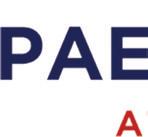





Brian Akkashian founded Paesano Akkashian, PC in 2011 with his partner, Anthony Paesano. Paesano Akkashian is a full-service business litigation, corporate transactional, real estate and securities boutique.
Prior to founding Paesano Akkashian, Brian was a partner at Dickinson Wright PLLC from 1999-2011 in the Firm’s commercial litigation group and an associate attorney at Howard & Howard Attorneys, PLLC from 1996-1999. Brian has nearly 30 years of experience in commercial and business litigation, alternative dispute resolution, mediation, and arbitration. His practice in these areas has provided extensive experience in customersupplier disputes, automotive, manufacturing and supply chain litigation, shareholder disputes, fraud, insurance defense and employment litigation. Brian also counsels clients on all aspects of their business operations, including contract negotiation and formation, employment, compliance, and many other issues.
Brian has been a Michigan Super Lawyer in Business Litigation for the last ten years and was named a 2024 Michigan Lawyer’s Weekly Leader in the Law and 2024 DBusiness Top Lawyer. Brian has previously served as a member of the Executive Board of the Federal Bar Association for the Eastern District of Michigan and as co-chair of its Complex Commercial Litigation Committee. He has published articles and presented seminars on various topics in commercial and business litigation and is a current member of the Litigation and Alternative Dispute Resolution Sections of the Michigan State Bar.
In addition to his litigation practice, Brian has an active alternative dispute resolution practice having participated in hundreds of mediations and numerous arbitrations. His decades of experience as a trial lawyer, counselor, and advocate have made him uniquely qualified to work with attorneys and their clients in all aspects of dispute resolution. As litigation has become more time-consuming and expensive than ever before, with fewer trials and more emphasis by courts, attorneys, and clients on settlement, mediation has become an indispensable part of virtually every litigation matter. Brian has reacted by expanding his practice to include more work as a mediator. He uses his deep knowledge and broad legal experience, his pragmatic business approach and his ability to manage the personal and emotional aspects of litigation to find creative solutions and resolve even the most difficult cases.

Q: What does the typical mediation process look like when working with Paesano Akkashian PC.
A: In general, mediation is a facilitative process involving consultation with attorneys and their clients to reach a compromised resolution of a dispute. Every mediation is different and it’s my job to tailor the process in each case to maximize the chances that the parties can resolve their case. This may involve a collaborative session with both sides and their counsel working together in the same room, private sessions with each side to allow open communication in a confidential setting and/or shuttle diplomacy between the parties to convey information and facilitate compromise.
Q: How does mediation reduce stress for both attorneys and clients?
A: The mediation process itself can be stressful. A good mediator may be able to reduce the parties’ stress by listening and demonstrating to the parties that their key issues and concerns are being heard and given serious consideration. In addition, while a negotiated resolution seldom produces an ideal outcome for either party, it resolves the dispute and eliminates the greater stress inherent in protracted litigation.
Q: How do you see the role of mediation evolving in the legal field?
A: Clients are rightfully concerned about the time, cost, stress and uncertainty involved in litigation. As a result, mediation has become an invaluable tool to resolve cases before clients spend time and incur substantial costs in litigation. Mediation also allows parties a greater say in the outcome of their dispute. In business court cases, mediation has become nearly mandatory at some point during the case. The trend towards mediation and other forms of alternative dispute resolution is unlikely to end any time soon. If anything, it’s likely that parties, attorneys and judges will continue to rely on mediation to resolve many, if not most, legal disputes.
Q: What’s the best way for attorneys to collaborate with you on their next dispute?
A: Pre-suit mediation is becoming more prevalent. It’s also not uncommon for a single case to include multiple mediation sessions or early mediation with continued involvement by the mediator as the parties proceed with litigation. My best advice is for counsel to identify and retain a mediator early (maybe even before litigation is filed) so the mediator has a firm grasp of the issues at every stage of the case and can provide maximum assistance in resolving the dispute.






The research for the 2026 Top Lawyers list was created by PRS (Professional Research Services) and is based on an online peerreview survey sent out to the certi ed lawyers within the metro Detroit area. Many votes were cast honoring excellence in the legal eld. Inclusion in DBusiness magazine’s Top Lawyers list is based solely upon one’s standing within their peer group. Listings in Top Lawyers cannot be purchased.
e 2026 Top Lawyers list will be posted at DBusiness.com on Nov. 17, 2025.
Gregory L. Curtner
Riley Safer Holmes & Cancila
Howard B. Iwrey
Dykema Gossett
Sheldon H. Klein
Butzel Long
Robert E. Murkowski
Miller, Canfield, Paddock and Stone
Paul F. Novak
Weitz & Luxenberg
Thomas C. O'Brien
Miller, Canfield, Paddock and Stone
L. Pahl Zinn
Dickinson Wright
Stephanie Arndt
Appellate Partners
LeRoy L. Asher Jr.
Miller, Canfield, Paddock and Stone
Keith Banka
Mike Morse Law Firm
Trent B. Collier
Collins Einhorn Farrell
Michael J. Cook
Collins Einhorn Farrell
Phillip J. DeRosier
Dickinson Wright
Timothy A. Diemer
Jacobs and Diemer
Stephanie A. Douglas BSP Law
Don Fulkerson
Fabian, Sklar, King & Liss
Jeffrey C. Gerish
Plunkett Cooney
Christina A. Ginter
Kitch Attorneys & Counselors
Caroline B. Giordano
Miller, Canfield, Paddock and Stone
Mark Granzotto
Granzotto & Wittmann
Gregory P. LaVoy
Harvey Kruse
Derek J. Linkous BSP Law
Daniel J. McCarthy
Butzel Long
Susan M. McKeever
BSP Law
Edward M. Nahhat
Kemp Klein Law Firm
Matthew T. Nicols
Secrest Wardle
Ronald S. Nixon
Kemp Klein Law Firm
Brian J. Richtarcik
Foley, Baron, Metzger & Juip
Robert M. Riley Honigman
Madeline Sinkovich
Mike Morse Law Firm
Beth A. Wittmann
Granzotto & Wittmann
Frederick A. Acomb
Miller, Canfield, Paddock and Stone
Joel C. Bryant
Miller, Canfield, Paddock and Stone
Gene J. Esshaki
Merry, Farnen and Ryan
Patrick F. Hickey
Hickey Hauck Bishoff Jeffers & Seabolt
Samantha S. Galecki Sager
Miller, Canfield, Paddock and Stone
Kimberly L. Scott
Miller, Canfield, Paddock and Stone
Kurtis T. Wilder
Butzel Long
I. W. Winsten Honigman
James L. Woolard Jr.
Miller, Canfield, Paddock and Stone
Kasturi Bagchi
Miller, Canfield, Paddock and Stone
Megan R.I. Baxter-Labut
Miller, Canfield, Paddock and Stone
Douglas C. Bernstein Plunkett Cooney
Matthew K. Casey
Warner Norcross + Judd
Michelle "Cheli" Bleda Drew Honigman
Kimberly A. Dudek Honigman
Joseph N. Ejbeh Aloia Law
Robert B. Goldi
Kotz Sangster Wysocki
Shawn N. Hopper
Miller, Canfield, Paddock and Stone
Joseph C. Huntzicker
Miller, Canfield, Paddock and Stone
Barbara A. Kaye Honigman
Steven A. Roach
Miller, Canfield, Paddock and Stone
Michael J. Romaya Varnum
James J. Sarconi
Smith & Sarconi
Wayne S. Segal Dawda
Clara L. Seymour Honigman








William P. Shield Jr. Dickinson Wright
Joshua Gadharf McDonald Hopkins







LAWYER POPULATION IN MICHIGAN 2015–2024











Source: Michigan Bar Association

Larry R. Shulman Bodman
Frank R. Simon Simon
Theodore B. Sylwestrzak Dickinson Wright
Kristen M. Veresh Varnum
Robert A. Wright III Dawda
Melvin J. Babi Babi Legal Group
Marc M. Bakst Bodman
Jason W. Bank Kerr Russell & Weber
Stanley M. Bershad Goldstein Bershad & Fried
Brendan G. Best Varnum
Je rey H. Bigelman Osipov Bigelman
Lynn M. Brimer Strobl
Charles "Chuck" D. Bullock Stevenson & Bullock
Tracy M. Clark Steinberg Shapiro & Clark
Steven J. Cohen The Smart Law Group
Elliot G. Crowder Stevenson & Bullock
Robert J. Diehl Jr. Bodman
Jonathan S. Green
Miller, Canfield, Paddock and Stone
Steven G. Howell Dickinson Wright
Scott B. Kitei Honigman
Anthony J. Kochis Wolfson Bolton Kochis
Richard Kruger Taft, Stettinius & Hollister
Scott M. Kwiatkowski Goldstein Bershad & Fried
Stephen S. LaPlante Miller, Canfield, Paddock and Stone
Dennis W. Loughlin Warner Norcross + Judd
Ralph E. McDowell Bodman
Shantelle N. Ne Law O ces of Joshua B. Sanfield
Dean R. Nelson Jr. Taunt Law
Norman D. Orr Kemp Klein Law Firm
Yuliy Osipov Osipov Bigelman
James A. Plemmons Dickinson Wright
E. Todd Sable Honigman
Ronald A. Spinner
Miller, Canfield, Paddock and Stone
Marc N. Swanson
Miller, Canfield, Paddock and Stone
Julie B. Teicher Maddin Hauser Roth & Heller
Glenn S. Walter Honigman
Scott A. Wolfson
Wolfson Bolton Kochis
Craig E. Zucker
Maddin Hauser Roth & Heller
Karl A. Hochkammer Honigman
Chauncey C. Mayfield II Honigman
R. Edward Boucher
Kotz Sangster Wysocki
Tim P. Brady
The Tim Brady Law Firm
Michael D. Carroll
Kerr Russell & Weber
James R. Case
Dykema Gossett
Peter J. Cavanaugh Cavanaugh & Quesada
Timothy P. Dugan
Kotz Sangster Wysocki
Douglas W. Eyre
Kotz Sangster Wysocki
Patrick A. Facca
Facca, Richter & Pregler
Eric J. Flessland
Butzel Long
Scott D. Garbo
Clark Hill
J. Christian Hauser
Frasco Caponigro Wineman Scheible Hauser & Luttmann
Kevin S. Hendrick
Clark Hill
Ronald E. Hodess
Miller, Canfield, Paddock and Stone
John R. Prew
Harvey Kruse
Corinne S. Rockoff
Miller, Canfield, Paddock and Stone
Mark D. Sassak
Deneweth, Vittiglio & Sassak
Anthony Vittiglio II
Deneweth, Vittiglio & Sassak
Joseph A. Bellanca
Hertz Schram
J. Michael Huget Honigman
Susan M. Kornfield Bodman
Julie E. Reitz Honigman
Thomas G. Appleman
Miller, Canfield, Paddock and Stone
Richard C. Buslepp
Kerr Russell & Weber
Alfredo Casab Dawda
Ralph A. Castelli
Kemp Klein Law Firm
Forrest O. Dillon Bodman
Michael D. DuBay Honigman
Steven J. Enwright
Taft, Stettinius & Hollister
Laura E. Johnson
Butzel Long
Loukas Panayiotis Kalliantasis
Clark Hill
John P. Kanan Honigman
Justin G. Klimko
Butzel Long
K. Dino Kostopoulos Kostopoulos & Rodriguez
Donald J. Kunz Honigman
Jeffrey L. LaBine
Miller, Canfield, Paddock and Stone
Daniel H. Minkus
Clark Hill
Matthew J. Moussiaux Honigman
Joshua F. Opperer Honigman
Alex L. Parrish Honigman
Linda Paullin-Hebden
Warner Norcross + Judd
Marc K. Salach Dawda
Kathryn R.S. Spray Aloia Law
Cynthia L. Umphrey
Kemp Klein Law Firm
Shusheng Wang
Miller, Canfield, Paddock and Stone
Sherman Abdo La Grasso, Abdo, & Silveri
Raymond A. Cassar Law Offices of Raymond A. Cassar
David R. Cripps Cripps & Silver Law
Loren M. Dickstein
Lewis & Dickstein
Gerald K. Evelyn
Gerald K. Evelyn Attorney & Counselor
Steven Fishman Attorney at Law

Marc E. Hart
The Law Offices of Marc E. Hart
Joshua A. Kaplan Dizik | Faber | Kaplan
Joseph A. Lavigne
Law Offices of Joseph A. Lavigne
Mariell R. Lehman Lehman Law Firm
Robert W. Palmer
Pitt McGehee Plamer Bonanni & Rivers
Mitchell Ribitwer
Ribitwer & Sabbota
Neil S. Rockind
Neil Rockind | Rockind Law
Jerome Sabbota
Ribitwer & Sabbota
Gabi D. Silver
Cripps & Silver Law
Kimberly W. Stout
Kimberly W. Stout Attorney at Law
Jewel Haji Boelstler Honigman
James W. Burdick Burdick Law
Kenneth R. Chadwell Plunkett Cooney
Ronald W. Chapman Chapman Law Group
Thomas W. Cranmer Miller, Canfield, Paddock and Stone
Colin A. Daniels
Neil Rockind | Rockind Law
George B. Donnini Butzel Long
David F. DuMouchel Butzel Long
Gerald J. Gleeson II
Miller, Canfield, Paddock and Stone
Patrick John Hurford
Patrick Hurford
Mark J. Kriger LaRene & Kriger
Walter J. Piszczatowski Hertz Schram
Matthew Schneider Honigman
James C. Thomas O'Reilly Rancilio
William E. Altman Fisher & Phillips
Michelle "Mickey" Bartlett Miller, Canfield, Paddock and Stone
Alexander J. Burridge Honigman
Amy M. Christen Dykema Gossett
Jaclyn Culler
Dickinson Wright
Katina K. Gorman
Miller, Canfield, Paddock and Stone
Deborah L. Grace
Dickinson Wright
Roberta P. Granadier
Dickinson Wright
Frederick W. Gregory Dickinson Wright
Edward C. Hammond
Clark Hill
Mark W. Jane Butzel Long
Samantha A. Kopacz Honigman
Brian A. Kreucher
Howard & Howard Attorneys
Lynn McGuire Butzel Long
Cynthia A. Moore Dickinson Wright
Jessica S. Rowley AsherKelly
Charles M. Russman Varnum
Kenneth J. Sachs Bodman
Jordan Schreier Dickinson Wright
David B. Walters Bodman
Karen L. Boore
Miller, Canfield, Paddock and Stone
Richard A. Barr Honigman
Kurt M. Brauer
Warner Norcross + Judd
Russell J. Bucher
Miller, Canfield, Paddock and Stone
Michael L. Caldwell Zausmer
Brian J. Considine Dawda
Fredrick J. Dindo er Bodman
Nathan D. Dupes Bodman
Stephen R. Estey Zausmer
Grant P. Gilezan
Dykema Gossett
Beth S. Gotthelf
Butzel Long
Mohamad Hussein Houjaij Foley, Baron, Metzger & Juip
Mark D. Jacobs
Dykema Gossett
S. Lee Johnson Honigman
Susan L. Johnson
Butzel Long
Kurt A. Kissling
Warner Norcross + Judd
Matthew C. McCann Foley, Baron, Metzger & Juip
Steven C. Nadeau
Susan J. Sadler Dawda
AnnMarie Sanford
Dickinson Wright
Erica J. Sarver Bodman
Arthur H. Siegal Taft, Stettinius & Hollister
Nicholas J. Tatro
Foley, Baron, Metzger & Juip
Tyler D. Tennent Dawda
Je rey Lance Abood The Abood Law Firm
Mark A. Bank Bank Ri in
Carol F. Breitmeyer Breitmeyer Cushman
Kyle Bristow Bristow Law
Erica Grand Brown
Erica Brown Law
Cristina Crescentini Hertz Schram
Kathryn M. Cushman Breitmeyer Cushman
Jordan S. Dizik Dizik | Faber | Kaplan
Roquia K. Draper Warner Norcross + Judd
Laura E. Eisenberg Eisenberg & Spilman
Erin Flynn Flynn Law
Amy B. Folbe Honigman
Staci D. Giske Giske Law Center
Lorne B. Gold
The Gold Law Firm
Ruth Goldner Goldner Deeg
Marcy Hahn
Lotus Legal Solutions
Elizabeth A. Hohauser
Elizabeth A. Hohauser













Keela P. Johnson Giarmarco, Mullins & Horton
Ryan Kelly Kelly & Kelly
Channelle Kizy-White Kizy Law
Rebecca S. Klein
Rubin Frampton
Jennifer Lindquist
Sarty Lindquist and Robl
Angela Medley
The Medley Law Firm
David S. Mendelson
The Mendelson Law Firm
Nina M. Paolini-Lotarski
Aloia Law
Julia A. Perkins
Varnum
Kristyn P. Recchia
Dickinson Wright
B. Andrew Rifkin
Bank Rifkin
Chase S. Robl
Sarty Lindquist and Robl
Kurt E. Schnelz
Schnelz Wells
Lynn Capp Sirich
Dickinson Wright
Amy A. Stawski
Kemp Klein Law Firm
Lisa D. Stern Hertz Schram
Jessica R. Woll Woll & Woll
J. Patrick Howe Honigman
Courtland W. Anderson Bodman
Bernard J. Fuhs
Butzel Long
Gary M. Remer
Maddin Hauser Roth & Heller
David Steinberg
Elia Law
Jennifer L. Benedict Honigman
Reesa Benkoff
Benkoff Health Law
Liza Roe Brooks Dykema Gossett
Elizabeth Callahan
Hall, Render, Killian, Heath & Lyman
Brandon M. Dalziel Bodman
Jovan Dragovic
Dykema Gossett
Gregory G. Drutchas
Kitch Attorneys & Counselors
Debra A. Geroux
Butzel Long
John Paul Hessburg
Kitch Attorneys & Counselors
Michael R. Janes
Miller, Canfield, Paddock and Stone
Matthew Keuten Honigman
Peter B. Kupelian
Clark Hill
Mark R. Lezotte
Butzel Long
Silvia Alexandria Mansoor
Foley, Baron, Metzger & Juip
Lori-Ann Rickard
Rickard & Associates
Alan "Al" T. Rogalski
Warner Norcross + Judd
David L. Rogers
Rogers & Associates
Daniel J. Schulte
Kerr Russell & Weber
Robert H. Schwartz
Butzel Long
Keith J. Soltis
Kotz Sangster Wysocki
Andrew B. Wachler
Wachler & Associates
Mark E. Wilson
Dickinson Wright
James G. Aldrich
Dykema Gossett
N. Peter Antone
Antone, Casagrande & Adwers
Edward A. Bajoka
Bajoka Law Group
Elizabeth B. Baker
Miller, Canfield, Paddock and Stone
Dorothy H. Basmaji
Antone, Casagrande & Adwers
Sarah R. Bileti
Warner Norcross + Judd
Robert M. Birach
Law Office of Robert M. Birach
Meghan N. Covino Honigman
Jalal J. Dallo
Dallo Law
Christopher M. Dutot
Miller, Canfield, Paddock and Stone
Rami Fakhoury
Fakhoury Global Immigration
Afaf Vicky Farah
Law Offices of Afaf Vicky Farah
Suzan Gabbara
Eaman & Gabbara
Marshal E. Hyman
Marshal E. Hyman & Associates
Elise S. Levasseur
Dickinson Wright
Clara DeMatteis Mager
Butzel Long
George P. Mann
George P. Mann & Associates
Eli Maroko
Taft, Stettinius & Hollister
Kathleen M. McCarroll
Kerr Russell & Weber
Elisheva G. Mosko Mosko Law
Reginald A. Pacis
Butzel Long
Meghan Kennedy Riordan
Kitch Attorneys & Counselors
Julianne Cassin Sharp
Miller, Canfield, Paddock and Stone
Suzanne K. Sukkar
Dickinson Wright
Megan C. McKnight Tealstone Law
Angela Emmerling Shapiro Butzel Long
Danielle F. Bass Honigman
Rick A. Decker Miller Law
Emily E. Hughes Miller Law
Michael S. Khoury FisherBroyles
Gregory Mitchell Miller Law
Claudia Rast
Butzel Long
Mohammad G. Beydoun
Secrest Wardle
Charles W. Browning Plunkett Cooney
Jeffrey A. Bussell
Michigan Auto Law
Michael G. Costello Bodman
George F. Curran III Kotz Sangster Wysocki
Nancy V. Dembinski
Landry, Mazzeo & Dembinski
Michael H. Fabian
Fabian, Sklar, King & Liss
Lawrence E. Gursten
Michigan Auto Law
Aaron Herskovic
Fabian, Sklar, King & Liss
Kimberly A. Kardasz
Harvey Kruse
Stacey L. King
Garan Lucow Miller
Adam B. Kutinsky Kutinsky
Jason J. Liss
Fabian, Sklar, King & Liss
Fadee A. Nakkash
Secrest Wardle
Travis J. Peterson
Harvey Kruse
Daniel S. Saylor
Garan Lucow Miller
Michael F. Schmidt
Harvey Kruse
Stuart A. Sklar
Fabian, Sklar, King & Liss
Robert M. Unatin
Plunkett Cooney
Daniel P. Aleksynas
Young Basile Hanlon & MacFarlane
Thomas J. Appledorn Honigman
John S. Artz
Dickinson Wright
Robin W. Asher
Miller, Canfield, Paddock and Stone
Kimberly A. Berger
Miller, Canfield, Paddock and Stone
Daniel H. Bliss
Howard & Howard Attorneys
Andrew J. Boes
Honigman









Bruce C. Thelen

Kelly K. Burris Burris Law
Dickinson Wright




Eric M. Dobrusin




The Dobrusin Law Firm
Glenn E. Forbis Harness IP
Eric S. Hydorn The Dobrusin Law Firm
Erin Klug The Dobrusin Law Firm
Anessa Owen Kramer Honigman
Anita C. Marinelli
Miller, Canfield, Paddock and Stone
Mary Margaret L. O'Donnell Blue Filament Law
Paul J. Palinski
The Dobrusin Law Firm
Kristen L. Pursley
The Dobrusin Law Firm
Philip E. Rettig Dickinson Wright
Randolph M. Wright
Berry Moorman
LABOR & EMPLOYMENT LAW
Margaret Carroll Alli Ogletree Deakins
D. Kyle Bierlein
Miller, Canfield, Paddock and Stone
Terry W. Bonnette
Nemeth Bonnette Brouwer
Deborah L. Brouwer
Nemeth Bonnette Brouwer
Aaron V. Burrell
Dickinson Wright
Ahmad Chehab
Miller, Canfield, Paddock and Stone
Randal R. Cole Dawda
Michelle P. Crockett Honigman





Mark D. Schneider Dinsmore & Shohl
Sean F. Crotty Honigman




Eric J. Sosenko Honigman
Rebecca S. Davies Butzel Long





Steven Susser Evia Law
Matthew H. Szalach Honigman
Daniela M. Walters
The Dobrusin Law Firm
Rebecca L. Wilson
The Dobrusin Law Firm

Joseph D. Gustavus
Miller, Canfield, Paddock and Stone
Je rey G. Richardson
Miller, Canfield, Paddock and Stone
David R. Deromedi Dickinson Wright
Matthew S. Disbrow Honigman
Sue Ellen Eisenberg
Sue Ellen Eisenberg & Associates
Barry S. Fagan Fagan McManus
Gary S. Fealk Bodman
Mark R. Filipp
Kemp Klein Law Firm
Lawrence T. Garcia
Miller, Canfield, Paddock and Stone
Joseph A. Golden Kostopoulos & Rodriguez
Aaron D. Graves Bodman
Elizabeth P. Hardy Kienbaum Hardy Viviano Pelton Forrest
Timothy H. Howlett Dickinson Wright
Mark C. Knoth
Kerr Russell & Weber
Frank T. Mamat Plunkett Cooney
Debra M. McCulloch McCulloch Law
Jennifer Lossia McManus Fagan McManus
Brett J. Miller
Butzel Long
Megan P. Norris
Miller, Canfield, Paddock and Stone
Heather G. Ptasznik Ogletree Deakins
Matthew E. Radler Honigman
James M. Reid IV Honigman
Miriam L. Rosen
McDonald Hopkins
James S. Rosenfeld
Butzel Long
Tad T. Roumayah Sommers Schwartz
Erika L. Ruskin
Kotz Sangster Wysocki
Jennifer L. Sabourin
Miller, Canfield, Paddock and Stone
Brian Schwartz
Miller, Canfield, Paddock and Stone
Rebecca C. Seguin-Skrabucha Bodman
Heidi T. Sharp
The Sharp Firm
LeRoy L. Asher Jr.
Miller, Canfield, Paddock and Stone
Daniel P. Dalton
Dalton & Tomich
David B. Landry
Landry, Mazzeo & Dembinski
Richard D. Rattner
Williams, Williams, Rattner & Plunkett
Michael Vogt
Dickinson Wright
David C. Anderson
Collins Einhorn Farrell
Theresa M. Asoklis
Collins Einhorn Farrell
Donald D. Campbell
Collins Einhorn Farrell
Harvey R. Heller
Maddin Hauser Roth & Heller
Jeffrey S. Hengeveld Plunkett Cooney
Jeffrey R. Hicks
Collins Einhorn Farrell
Tom Howlett
The Googasian Firm
James J. Hunter
Collins Einhorn Farrell
Kathleen H. Klaus
Maddin Hauser Roth & Heller
Edward G. Lennon
Lennon Law
David M. Saperstein
Maddin Hauser Roth & Heller
Michael J. Sullivan
Collins Einhorn Farrell
Matthew L. Turner
Sommers Schwartz
Darice E. Weber
Secrest Wardle
David A. Ettinger
Honigman
Larry J. Saylor
Miller, Canfield, Paddock and Stone
Kasturi Bagchi
Miller, Canfield, Paddock and Stone
Rian C. Dawson Honigman
Raymond W. Henney Honigman
Scott R. Lesser
Miller, Canfield, Paddock and Stone
Devon P. Allard
Miller Law
Benjamin J. Aloia Aloia Law
Alexander A. Ayar
Williams, Williams, Rattner & Plunkett
Angela L. Baldwin
Miller Law
J. Adam Behrendt Bodman
John E. Benko
McDonald Hopkins
Mark D. Chutkow
Dykema Gossett
Dennis K. Egan
Kotz Sangster Wysocki
Erika L. Giroux
Miller, Canfield, Paddock and Stone
Jennifer Grieco Altior Law
Rebecca McLaughlin Haines
Head Murphy Law
Shawn H. Head
Head Murphy Law
Michael P. Hindelang Honigman
Ethan R. Holtz
Taft, Stettinius & Hollister
Benjamin W. Jeffers
Hickey Hauck Bishoff Jeffers & Seabolt
Christopher D. Kaye
Miller Law
Aaron M. Keyes
Aloia Law
Mark L. Kowalsky
Taft, Stettinius & Hollister
Eric A. Ladasz
Dawda
Jeffrey K. Lamb Honigman
Timothy J. Lowe
McDonald Hopkins
Gerard V. Mantese
Mantese Honigman
James A. Martone
Dickinson Wright
Stephen McKenney Altior Law
Roger P. Meyers
BSP Law
E. Powell Miller
Miller Law
Sonal Hope Mithani
Miller, Canfield, Paddock and Stone
John Mucha III
Dawda
Sean P. Murphy
Head Murphy Law
Moheeb H. Murray
BSP Law
Kenneth Neuman
Altior Law
Timothy G. Orlando
Aloia Law
Eric A. Parzianello
Hubbard Snitchler & Parzianello
Michael Petrus
Williams, Williams, Rattner & Plunkett
Daniel D. Quick
Dickinson Wright
Daniel L. Ravitz
Miller Law
Steven M. Ribiat
Brooks Wilkins Sharkey & Turco
Brian H. Rolfe
Kemp Klein Law Firm
Mark C. Rossman
Rossman
Brian M. Saxe
Miller Law
Scott T. Seabolt
Hickey Hauck Bishoff Jeffers & Seabolt
Bruce L. Sendek
Butzel Long
Daniel N. Sharkey
Brooks Wilkins Sharkey & Turco
Mark Steiner
McDonald Hopkins
Kevin J. Watts
Miller Law
Frances Belzer Wilson
Dawda
R. Edward Boucher
Kotz Sangster Wysocki
James P. Davey
Kemp Klein Law Firm
Michael C. Decker
Butzel Long
Ronald A. Deneweth
Deneweth, Vittiglio & Sassak
Lawrence M. Dudek
Miller, Canfield, Paddock and Stone
Eric J. Flessland
Butzel Long
Faith M. Gaudaen
Kemp Klein Law Firm
Richard T. Hewlett
Varnum
Raymond L. Morrow
Kemp Klein Law Firm
Emily C. Palacios
Miller, Johnson, Snell & Cummiskey
Jeffrey M. Sangster
Kotz Sangster Wysocki
John M. Sier
Kitch Attorneys & Counselors
Brandon J. Wilson Honigman
Derek J. Brackon
Michigan Auto Law
Matthew J. Consolo
Secrest Wardle
Michelle Thurber Czapski Bodman
Justin A. Grimske
Secrest Wardle
Rabih Hamawi
Law Office of Rabih Hamawi
Alexander P. Kemp
Michigan Auto Law
Mark F. Masters
Secrest Wardle
Richard A. Moore
Michigan Auto Law
Anthony A. Randazzo
Secrest Wardle
Mark E. Servais
Michigan Auto Law
Frank A. Angileri
Brooks Kushman
David Louis Atallah
Carlson, Gaskey & Olds
Marjory G. Basile
Miller, Canfield, Paddock and Stone
Michael P. Coakley
Miller, Canfield, Paddock and Stone
Richard W. Hoffmann
Reising Ethington
Marc Lorelli
Brooks Kushman
Patrick M. McCarthy
Howard & Howard Attorneys
A. Michael Palizzi
Miller, Canfield, Paddock and Stone
Wendolyn Wrosch Richards
Miller, Canfield, Paddock and Stone
Steven Susser
Evia Law
Deborah "Bea" Swedlow Honigman
Leigh C. Taggart Honigman
Emily J. Tait
Jones Day
Brian D. Wassom
Warner Norcross + Judd
Scott P. Batey
Batey Law Firm
D. Kyle Bierlein
Miller, Canfield, Paddock and Stone
John F. Birmingham Jr.
Foley & Lardner
Sheryl Laughren
Berry Moorman
Robert C. Tice
Littler Mendelson
Jerome R. Watson
Miller, Canfield, Paddock and Stone
Scott D. Barnett Honigman
Sarah E. Waidelich Honigman
Benjamin J. Aloia Aloia Law
Joseph Doerr Doerr MacWilliams Howard
Brandan A. Hallaq Hirzel Law
Livia Khemmoro Hirzel Lawt
Kathleen L. Bogas Bogas & Koncius
Nicholas A. Huguelet
Miller, Canfield, Paddock and Stone
Daniel P. Makarski
Secrest Wardle
Thomas G. McNeill
Tom McNeill
James J. Rashid Judicial Resource Services
Muskan B. Ali Sommers Schwartz
Matthew G. Curtis Sommers Schwartz
Albert J. Dib Jefferson Law Center
Andy Dragovic Sommers Schwartz
Paul J. Dwaihy
Nauts, McKinney, Dwaihy & Beach
Chad D. Engelhardt Goethel Engelhardt
Lisa Esser-Weidenfeller Sommers Schwartz
Richard L. Groffsky Sommers Schwartz
Randall A. Juip Foley, Baron, Metzger & Juip
Marc E. Lipton Lipton Law
Donna M. MacKenzie Olsman MacKenzie Peacock & Wallace
James R. McCullen
Reiter & Walsh — American Baby & Child Law Centers
Brian J. McKeen McKeen & Associates
David R. Nauts
Nauts, McKinney, Dwaihy & Beach
Emily M. Peacock Olsman MacKenzie Peacock & Wallace
Anne Randall
Reiter & Walsh — American Baby & Child Law Centers
Jesse M. Reiter
Reiter & Walsh — American Baby & Child Law Centers
Lauren T. Rhoads
Foley, Baron, Metzger & Juip
Jennifer Secorski
Reiter & Walsh — American Baby & Child Law Centers
Laura H. Selzer
Miller, Canfield, Paddock and Stone
Judith A. Susskind
Sommers Schwartz
Matthew Turner
Sommers Schwartz
Rebecca S. Walsh
Reiter & Walsh — American Baby & Child Law Centers
Dina M. Zalewski
Sommers Schwartz
Brad B. Arbuckle
Miller, Canfield, Paddock and Stone
Robert S. Bick
Williams, Williams, Rattner & Plunkett
Richard C. Bruder
Kemp Klein Law Firm
Timothy R. Damschroder Bodman
Jacob D. Drouillard Honigman
Zhiguo Du
Miller, Canfield, Paddock and Stone
Matthew W. Frank
Kemp Klein Law Firm
Arthur L. Griem
Miller, Canfield, Paddock and Stone
Stephen M. Gross
McDonald Hopkins
Eric M. Jones Honigman
David D. Joswick
Miller, Canfield, Paddock and Stone
Lee Kellert
Taft, Stettinius & Hollister
Evan J. Leibhan Honigman
Steven J. Migliore Honigman
Michael T. Raymond
Dickinson Wright
John P. Ulrich Jr. Kotz Sangster Wysocki
Matthew R. VanWasshnova Honigman
Richard A. Walawender
Miller, Canfield, Paddock and Stone
Sarah J. Williams Bodman
Gregory L. Wysocki
Kotz Sangster Wysocki
Lisa J. Hamameh
Rosati Schultz Joppich & Amtsbuechler
Melvin Butch Hollowell Miller Law
Steven P. Joppich
Rosati Schultz Joppich & Amtsbuechler
Steven D. Mann
Miller, Canfield, Paddock and Stone
Michael P. McGee
Miller, Canfield, Paddock and Stone
Daniela Peric
Wayne County Prosecutor's O ce
Thomas R. Schultz
Rosati Schultz Joppich & Amtsbuechler
Amanda Van Dusen
Miller, Canfield, Paddock and Stone



Celeste E. Arduino Bodman
Robin D. Ferriby
Clark Hill
Je rey D. Moss Dawda
Jennifer M. Oertel Bodman
Matthew Bates
Mike Morse Law Firm
Donald J. Cummings
Mike Morse Law Firm
John T. Eads III Marko Law
Jordan M. Ewald
Michigan Auto Law
Joshua Farr
Mike Morse Law Firm
David C. Femminineo Femminineo Attorneys
Christopher Filiatraut
Mike Morse Law Firm
Steven Gursten
Michigan Auto Law
Lauren Gwinn
Michigan Auto Law
Christopher C. Hunter
Michigan Auto Law
Thomas W. James Raitt Law
Ven Johnson
Ven Johnson Law
Jody B. Lipton
Lipton Law
Jonathan R. Marko
Marko Law
Jason R. Mathers
Harvey Kruse
Brian A. McKenna
Sinas Dramis Law Firm
Mike Morse
Mike Morse Law Firm
Kevin H. Seiferheld
Michigan Auto Law
Joshua R. Terebelo
Michigan Auto Law
Javon Williams
Mike Morse Law Firm
Sharon S. Almonrode
Miller Law
Bishop A. Bartoni
BSP Law
Dale R. Burmeister
Harvey Kruse
Michael D. Cummings
Harvey Kruse
Fred J. Fresard
Klein Thomas Lee & Fresard
Dennis M. Goebel
Harvey Kruse
Amy M. Johnston
Miller, Canfield, Paddock and Stone
Dennis A. Lienhardt Jr.
Miller Law
Christina J. Marshall
Miller, Canfield, Paddock and Stone
William E. McDonald III
BSP Law
Joseph Patrick McGill
Foley, Baron, Metzger & Juip
David C. Moll
Harvey Kruse
Stephen J. Ott
Miller, Canfield, Paddock and Stone
Patrick G. Seyferth
BSP Law
Matthew Warmbir
Miller, Canfield, Paddock and Stone
Justin B. Weiner
BSP Law
Michael D. Cummings
Harvey Kruse
Kari Melkonian
Fieger Law
Michael W. Hartmann
Miller, Canfield, Paddock and Stone
James J. Hunter
Collins Einhorn Farrell
Jeffrey S. Aronoff
Miller, Canfield, Paddock and Stone
John A. Carlson
Shifman & Carlson
Thomas D. Colis
Miller, Canfield, Paddock and Stone
Steven M. Frank
Miller, Canfield, Paddock and Stone
Craig W. Hammond
Dickinson Wright
Michael P. McGee
Miller, Canfield, Paddock and Stone
Patrick F. McGow
Miller, Canfield, Paddock and Stone
C. Leslie Banas
Kemp Klein Law Firm
David M. Barbour
Kotz Sangster Wysocki
Kylie E. Bergmann Dawda
Jonathan R. Borenstein Honigman
Alexander J. Clark
Miller, Canfield, Paddock and Stone
Erin R. Cobane
Dickinson Wright
Tracy Danner-Bond Hirzel Law
Edward C. Dawda Dawda
Joseph M. Fazio
Miller, Canfield, Paddock and Stone
Robert J. Gavin
Shifman & Carlson
Edward S. Gusky Varnum
Daniel M. Halprin Dawda
Matthew W. Heron
Hirzel Law
Kevin M. Hirzel
Hirzel Law
Ronald E. Hodess
Miller, Canfield, Paddock and Stone











Brian H. Holt
Miller, Canfield, Paddock and Stone
Erin Bowen Welch Dawda





ere are more than 1.3 M lawyers in the United States. To be precise, there were 1,322,649 active lawyers as of Jan. 1, 2024, according to the ABA National Lawyer Population Survey, a tally of lawyers in every U.S. state and territory.
Over the past decade, the number of lawyers nationwide has grown by more than 41,000, according to the survey — an increase of 3.2% from 2014 to 2024.
Source: American Bar Association

David J. Jacob Honigman
Joseph M. Judge Dawda
Thomas A. Kabel Butzel Long
Kayleigh B. Long Hirzel Law
Michael J. Lusardi Dickinson Wright
David D. Marsh Kemp Klein Law Firm
Christopher R. Martella Dawda
Maryam Karnib Parshall Honigman
Karen R. Pifer Honigman
J. Adam Rothstein Honigman
Lowell D. Salesin Honigman
Alan J. Salle Honigman
Steven D. Sallen Maddin Hauser Roth & Heller
Nicholas P. Scavone Jr. Bodman
Todd A. Schafer Dawda
C. Kim Shierk
Williams, Williams, Rattner & Plunkett
David S. Soble Soble Law
Andrew Z. Spilkin Bodman
Eric M. Stein
Miller, Canfield, Paddock and Stone
Grant W. Williams
Miller, Canfield, Paddock and Stone
Matthew P. Allen Miller, Canfield, Paddock and Stone
Michael S. Ben Honigman
Richard C. Bruder Kemp Klein Law Firm
Patrick J. Haddad Kerr Russell & Weber
Miles D. Hart Saretsky Hart Michaels + Gould
John A. Hubbard Hubbard Snitchler & Parzianello
Je rey H. Kuras Honigman
Peter C. Rageas Law O ces of Peter C. Rageas
Gary M. Saretsky Saretsky Hart Michaels + Gould
Brian Witus Saretsky Hart Michaels + Gould
William B. Acker Kemp Klein Law Firm
Marko J. Belej Taft, Stettinius & Hollister
Steven R. Cole Bodman
James H. Combs Honigman
Jackie J. Cook Honigman
Sean H. Cook
Warner Norcross + Judd
David R. de Reyna Kotz Sangster Wysocki
Katrina Piligian Desmond Miller, Canfield, Paddock and Stone
Scott D. Foess Honigman
Gary R. Glenn Miller, Canfield, Paddock and Stone
Rebecca L. Grove Varnum
Michael K. Hauser Honigman
Michael A. Indenbaum Honigman
Dennis Alan Kent
The Silver Tax Group
Stewart L. Mandell Honigman
Amanda Afton Martin
Kemp Klein Law Firm
Jeffrey M. McHugh Miller, Canfield, Paddock and Stone
Eric M. Nemeth Varnum
Gregory A. Nowak Miller, Canfield, Paddock and Stone
Neal Nusholtz Kemp Klein Law Firm
Chad C. Silver Silver Tax Group
Thomas H. Bergh Varnum
Kelly M. Burnell Bodman
Joseph P. Buttiglieri Kemp Klein Law Firm
Andrew H. Curoe Bodman
Hameed Jamal Dakroub Dakroub Group
David R. de Reyna Kotz Sangster Wysocki
Julius H. Giarmarco Giarmarco, Mullins & Horton
Kristen R. Gross
Law Offices of Kristen R. Gross
William Haines
Kemp Klein Law Firm
Brian R. Jenney
Kemp Klein Law Firm
Robert B. Labe Williams, Williams, Rattner & Plunkett
David P. Larsen Bodman
Elizabeth L. Luckenbach Dickinson Wright
Julia C. Massaro Bodman
Chiara F. Mattieson Couzens, Lansky, Fealk, Ellis, Roeder & Lazar
Alan A. May
Kemp Klein Law Firm
Andrew W. Mayoras Barron, Rosenberg, Mayoras & Mayoras
Monica D. Moons Couzens, Lansky, Fealk, Ellis, Roeder & Laza
Michael E. Morden Honigman
Marc Nakisher
The Nakisher Law Firm
Charles Nida Honigman
Robert P. Perry Butzel Long
Austin W. Probst
Kemp Klein Law Firm
Christopher Rambus Bodman
Katie Lynn Ringler Dawda
Stephen C. Rohr
Miller, Canfield, Paddock and Stone
Glenn G. Ross Dawda
Dawn M. Schluter Schluter & Hughes Law Firm
Mark M. Snitchler
Hubbard Snitchler & Parzianello
Jeffrey S. Sternberg
Kotz Sangster Wysocki
Grace K. Trueman Honigman
Michael J. Vomastek
Head Murphy Law
Linda A. Wasserman Honigman
Robert S. Zawideh
Kemp Klein Law Firm
Joel Alpert Alpert & Alpert
Todd Barry Michigan Workers Comp Lawyers
Alex Berman
Michigan Workers Comp Lawyers
John P. Charters Charters, Tyler, Zack & Shearer
William E. Gray
Michigan Workers Comp Lawyers
Andrea L. Hamm
Michigan Workers Comp Lawyers
Richard Hogg
Michigan Workers Comp Lawyers
Jeffrey E. Kaufman
Michigan Workers Comp Lawyers
Richard Warsh
Alpert & Alpert

Thirty-five years ago, newly installed Roman Catholic Archbishop of Detroit Adam J. Maida addressed 400 luncheon attendees at the Economic Club of Detroit, including Mayor Coleman A. Young. His speech,
“Partners in Building a New City,” received a standing ovation.
During his presentation, Maida challenged business leaders to “help create a private nonsectarian school in the inner city that would be a joint venture by the business, civic, and religious communities. Such a school would not be a threat to the public school system, but an alternative model.”
In what became a lasting comradery, Detroit-area business leaders and companies helped launch Cornerstone Schools in the city and continues to support the educational mission be it through philanthropy, the mentoring of students, internships, and, in some cases, providing educational experiences on campus or at company facilities.
Yet in recent years, Cornerstone Schools — like many K-12 educational institutions — have struggled with dynamic family trends including a rise in one-parent households; absenteeism, partly caused by families that move often due to the loss of a job or other challenging economic conditions; and low morale among students who trail their classmates.
“A child may be in the third grade but they don’t come back for the fourth grade, or we take students from other schools who have poor reading skills,” Clark Durant, president of the New Common School Foundation, and co-founder, current chair, and now retired CEO of Cornerstone’s charter management company, says. “If a student falls behind for whatever reason, it affects the student and his family.
“To turn that around, we’ve brought in new reading programs supported by our business community and others. What we hope to find and create is that the parents and their children are more engaged, and it leads to even more positive results and a better overall culture — but it wasn’t easy, due to social circumstance beyond our purview.”
At the time of Maida’s address, Durant, a 41-year-old attorney, was campaigning for statewide office and wasn’t in attendance. However, when The Detroit News’ editorial page editor Tom Bray told him about Maida’s speech, Durant drove to the archdiocese, obtained a copy, and read it right there in the lobby.
“When I read the paragraph about his vision for a new kind of school, my heart leapt and I knew I was born to help him create it,” Durant says. “I started my law practice representing people in Detroit who couldn’t afford a lawyer. I knew the other side of life for kids in the city.”
In February of 1991, Maida convened a meeting of 85 people who had responded to the call to start a school. Ultimately, the archbishop selected 13 people, including Durant, to meet every two weeks.
Two months later, Archbishop Maida (he was elevated to Cardinal in 1994) asked Durant to head the institution, now named Cornerstone Schools. Durant had previously served as a vice president at Hillsdale College in Hillsdale, and had been nominated by President Ronald Reagan, and confirmed by the U.S. Senate, to serve on the Legal Services Corp. board, a nonprofit that provides civic legal aid to the poor. Durant served as chairman for four years.
Within a few months, Durant and a friend, Mike Timmis, raised $1.2 million
Cornerstone Schools in Detroit has long achieved academic excellence by working closely with the region’s business community, but now the partnership is facing a new challenge as changing family dynamics impact basic reading skills, attendance, and classroom culture.
BY BILL DOW | TREVER LONG
in scholarship pledges from four families to start the school.
Later, Durant secured $1.6 million in scholarship pledges for the new school from companies, foundations, and individuals to offset the cost of private-school tuition.
By September 1991, in 10 months’ time from Maida’s original address, Cornerstone opened two “Christ-centered” schools in Detroit and enrolled 167 students. (Three years later, in 1994, Durant was elected to the Michigan State Board of Education and served as president of the board before stepping down after five years to focus more on Cornerstone Schools.)
Today, the schools continue to grow, thanks to the continuing philanthropy of businesses and multiple donors, large and small. However, in 2008, during the global economic crisis, Durant was forced to change direction.
“During the economic tsunami, Rick Wagoner (chairman and CEO of General Motors) told me that ‘GM can’t support you in the same way anymore, and neither can the suppliers. Cash is tight.’ ” Durant recalls. “I then asked Bill Pulte (founder of Pulte Homes) to chair a strategic planning group with Tony Earley, Walt Czarnecki, David Baker Lewis, and others. That plan recommended public-funded charter schools.”
Today, the six Cornerstone charter schools, all named after an American founding father and a civil rights leader, are tuition-free, and have a total typical enrollment of 3,000 students chosen on a “first-come, first-served lottery system.” Ninety percent of the students come from Detroit families living at or below the poverty line.
The K-5 school is Adams-Young Elementary; the K-8 schools are Madison-Carver Academy, Jefferson-Douglass Academy, and Washington-Parks Academy; the school for grades 6-8 is Adams-Young Middle School; and the high school is Lincoln-King.
According to Durant, although the charter schools aren’t religious, their mission is largely influenced by the teachings of the Rev. Dr. Martin Luther King Jr. and his call to live the three dimensions of “The Complete Life.”
“Such a life is of Length (to live for a purpose), of






— CLARK DURANT




WHAT WE HOPE TO FIND AND CREATE IS THAT THE PARENTS AND THEIR CHILDREN ARE MORE ENGAGED, AND IT LEADS TO EVEN MORE POSITIVE RESULTS AND A BETTER OVERALL CULTURE...”



Breadth (to be a person for others), and of Height (to know God),” Durant says.
He proudly recites the schools’ overall mission quickly: “We seek to prepare ourselves and our students, faculty, and families to live The Complete Life, a life of excellence and virtue in the unfolding of the American Promise.”
Over the years, Durant has adeptly worked closely with numerous business executives and companies to secure philanthropic and programming support for Cornerstone. For example, Livonia-based Roush Industries CEO Evan Lyall and his wife, Laurie, have been involved with Cornerstone for nearly 20 years.
“We were first impressed with the good work and positive impact that Cornerstone Schools were having on people’s lives, and then we got more involved with our personal philanthropy,” says Lyall, whose company bio states, in part, “Evan and his wife are active supporters of the Cornerstone Schools. Laurie has also mentored students and met with teachers.”
The company, in turn, continues to donate funding and has provided internship opportunities to Cornerstone students.
In 2014, Durant reached out to Lear Corp. in Southfield for philanthropic support, and he also asked if a top executive would sit on its board.
“For more than a decade we’ve been proud supporters of Cornerstone Schools and their mission to inspire and educate Detroit’s next generation of leaders,” says Ray Scott, CEO of Lear. “Through their involvement in literacy initiatives, STEM programs, mentoring, and internships, our employees are deeply engaged in providing opportunities for Cornerstone students to learn, grow, and succeed.”
Earlier this year, Madison-Carver Academy Principal Markisha Stovall partnered with Lear to conduct a “Shark Tank” like competition for third-, fourth-, and fifth-graders. Following a presentation by Lear seating engineer Brianna Williams about design and the variety of careers at the company, over the next two weeks the students designed their own seats before presenting their renderings to a team of seven volunteer Lear judges.
“We have several initiatives we expect to roll out in
the next year, like ‘Tech Talks,’ designed to give students information on technology, science, and engineering so they have knowledge of different STEM careers,” says Williams, Lear’s liaison to Cornerstone.
Jason Cardew, senior vice president and CFO at Lear, has sat on the Cornerstone board since 2014.
“The broader STEM initiatives will hopefully help build the pipeline for Detroitarea companies because there aren’t enough students going into STEM programs and careers,” Williams says.
“I think these types of programs help make the math and science classes more real and makes learning more exciting. It’s been incredibly rewarding working with Cornerstone for me and hundreds of Lear employees who have been involved over the years.”
Beginning this year, at the forefront of priorities for the Cornerstone Schools is the need to increase reading proficiency, particularly in the lower grades.
The results of Michigan’s latest reading scores showed that just 38 percent of third-graders and 42.4 percent of fourth-graders scored proficient in the state’s English language arts tests, down from the previous year. Scores are typically much lower in inner-city schools.
According to Durant, reading proficiency scores for grades 3-7 at Cornerstone fall between approximately 12 percent and 15 percent. Those scores aren’t uncommon for most inner-city schools across the country, yet Durant says they’re still unacceptable.
Research has long concluded that students who aren’t reading proficiently by third grade are significantly disadvantaged, and are at a higher risk of dropping out of school. Illiteracy also can trap individuals in a cycle of poverty.
This year, Cornerstone adopted an ambitious new reading program, in partnership with the Baltimore-based Success for All Foundation, after raising $1.6 million in funding.
“Our team goal is that within three years, Cornerstone students will become the best readers in Detroit and this will lay the foundation for lifelong habits of learning,” Durant says.
In September, Cornerstone Schools, in partnership with the Success for All Foundation, introduced a new program for students that requires 90 minutes of daily reading.
In short, the plan calls for every student to be tested to see what reading level they’re at, and then for 90 minutes every day (and longer, if a tutor is needed) they will read alongside their peers who are at the same reading, level regardless of grade.
From there, students will be assessed regularly and can move up as they progress. In addition, parents are asked to have their children read to them at home, and if that isn’t possible, the student is to read to any adult at school — whether it’s a teacher or a custodian.
“It’s the most comprehensive, systematic, and rigorous program that I’ve ever

seen, and it encompasses the entire school culture,” says Joshua Speyers, one of Cornerstone’s Success for All facilitators.
At a private dinner held in September at the historic Country Club of Detroit in Grosse Pointe Farms, a capacity of 86 invited guests, primarily prominent Cornerstone supporters, heard a 30-minute discussion about the new reading initiative from a panel that included the school principals and Superintendent Taiwo Da-Silva.
e discussion was moderated by Fred Ridley, a partner at Foley & Lardner and chairman of Augusta National Golf Club and the Masters tournament, and sports broadcaster Mike Tirico. Both men were named the honorary co-chairs of Cornerstone’s 21st Annual Turning Point Invitational, a golf fundraiser for the schools.
During the panel discussion, Lincoln-King High School Principal Andy Anuzis reiterated the importance of Cornerstone’s new reading initiative.
“As a high school principal, it’s not unusual for me to have a student show up from a Detroit or Cornerstone School who is at the fourth- or fth-grade reading level,” Anuzis says. “We now have Lawrence Technological University (in South eld) that wants to provide the opportunity to earn associates degrees in cybersecurity and computer sciences at the school, and companies like Lear and Roush that have given our students so many amazing opportunities.
“But for our kids, they must read to grasp those opportunities. e reading program isn’t just for college-bound kids or (those who want to get into the) skilled trades. is is going to help our families and have a huge impact on our city.”
Roush CEO Lyall and his wife, Laurie, attended the dinner and came away impressed.
“ e Q&A session was inspiring and clearly demonstrated how committed the school principals and faculty are in seeing that the literacy initiative is successful,” Lyall says. “We’re supporting it and hope it will grow and catch re. Cornerstone has a good track record of trying to improve and help students do better.”
Adds Lear’s Cardew, who also was in attendance: “It’s such an important initiative, we would be happy to steer future nancial support both from the company and personally.”
Tirico, an Ann Arbor resident for 25 years, closed out the discussion on a positive note.
“We’ve brought people here from all over the country working (for NFL games held at Ford Field) and they say so many nice things about Detroit,” Tirico said. “What you’re doing is building on this foundation. It’s not brick and mortar, and another Dan Gilbert- nanced project, (although) those are all great and important.
“What’s important is that people are being raised in Detroit and taught, and they will spread the word by what they do — whether they go to the trades or college. You are truly touching hundreds of lives every day and making a di erence.”
A week before Principal Anuzis participated in
In the 35-year history of Cornerstone Schools, its most impactful fundraising event took place at the first annual Turning Point Invitational in 2004 at the Country Club of Detroit in Grosse Pointe Farms.
The event celebrated the 50th anniversary of golf legend Arnold Palmer winning the 1954 U.S. Amateur Championship at the course and raised more than $6 million for Cornerstone Schools, a group of charter schools in Detroit. Proceeds from the invitational led to the establishment of the Arnold Palmer Education Fund and supported a handful of other children’s programs.
At the largest gathering ever of U.S. Amateur golf champions, 24 other past winners paid homage to Palmer, one of the players who popularized golf. The list included Phil Mickelson, Mark O’Meara, and Lanny Wadkins.
For the 2004 invitational, each former champion played with four amateurs who paid $25,000 each to compete in the best ball tournament, while gallery tickets sold for $1,500 each. The night before, a $500-per-ticket black tie dinner honoring Palmer was held at the club.
The event came about after Cornerstone co-founder and past CEO Clark Durant and former Ford Motor Co. CEO and Chairman Harold “Red” Poling traveled to Palmer’s home in Latrobe, Pa., to make a pitch for the honorary tournament.
“I told him, ‘We want to honor your 50th anniversary of the U.S. Amateur Championship, but the truth is we want to create turning points in the lives of children,’ ” recalls Durant, former director of the private management group at Munder Capital Management, an investment firm in Bloomfield Hills.
“Palmer raised his index finger, went to his bookcase, and pulled out a book that he gave to me titled, ‘The Turning Point: The 54th Amateur Championship of the United States Golf Association, Winner Arnold Palmer.’
“He said, ‘That was the turning point of my life and if my coming will help the turning point for those kids, I will come for free. I’ll come a day early and we can have a big dinner that will raise more money and I’ll visit one of your schools’ — which he did.”
Established in 1897, the Country Club of Detroit, the oldest private golf club in the Detroit area, first hosted the U.S. Amateur Golf Championship in 1915, when Robert Gardner won it.
For the 1954 championship, held at the Grosse Pointe Farms club, some 200 top-ranked American amateurs ranging from 18-year-old Rex Baxter to 64-year-old Charles “Chick” Evans, who won the first of his two U.S. Amateur championships 20 years before Baxter was born, competed.
Joining the field was 24-year-old paint salesman Arnold Palmer, seven months from serving in the U.S. Coast Guard.
It was reported at the time that brothers Henry Ford II and William Clay Ford Sr., some of the club’s most avid golfers, bought 1,000 tickets and distributed them to Ford employees.
The second issue of the then-new magazine, Sports Illustrated, featured a preview of the tournament penned by legendary writer Herbert Warren Wind. The scribe went on to summarize the results in the magazine’s fourth issue, reporting that the dark horse Palmer rallied and upset former British Amateur Champion Robert Sweeney, 1-up over 36 holes.
Fifty years later, one of the participants at the Turning Point Invitational in 2004 was 1981 U.S. Amateur and 1983 Walker Cup champion and former pro player Nathaniel Crosby, the seventh child of legendary singer Bing Crosby. From 1978 to 1985, Nathaniel hosted the Bing Crosby National Pro-Am at Pebble Beach.

ACE IN THE HOLE
Arnord Palmer won his first tournament, the 1954 U.S. Amateur Championship, at the Country Club of Detroit in Grosse Pointe Farms. He returned in 2004 for the Turning Point Invitational, which raised money for Cornerstone Schools.
“The 2004 Turning Point Invitational was a fantastic event, and it was a great honor to be a part of it,” says Crosby, 64. His wife, Sheila, is the daughter of the late Raymond Biggs, a longtime member of the Country Club of Detroit.
“There were a lot of incredible champions there from di erent generations and my caddie that day was my son, Nathaniel Jr., who was 14 or 15 at the time,” Crosby says.
“When I started 5-over through three holes, he was ready to put a brown bag over his head,” he adds with a laugh. “He was like the caddie of shame. I may have shot 80, I think. I’m a huge fan of what Clark Durant is doing and what he has accomplished with Cornerstone Schools.”
Two weeks after winning the ’81 U.S. Amateur, Crosby recalls a special moment with Palmer when the two had lockers near each other at another tournament.
“We were the only two there and he put his hands on my shoulders and said: ‘Congratulations, that’s as good as it gets. My U.S. Amateur win was the most special moment of any moment I’ve ever had in golf, so relish it and enjoy it.’ That was very cool.”
This year, the annual Turning Point Invitational and dinner, held at the Country Club of Detroit in September, wasn’t a fundraiser; rather, according to Durant, it was a way of saying thank you to generous donors while also serving as a platform to discuss Cornerstone’s new literacy initiative.
Seven threesomes each had sports broadcaster Mike Tirico and Fred Ridley, chairman of Augusta National Golf Club and the Masters Tournament, who won the U.S. Amateur 50 years ago, walk with them for three holes. Nearly 70 invited guests, meanwhile, attended the dinner.
— Bill Dow




ANDREW BERENZWEIG CEO, Hylant

FRANK MIGLIAZZO
Managing Director, MG & Associates
Merrill Private Wealth Management

TATIANA GRANT
Principal, 2050 Partners Inc. CEO, Grant Ventures

Adams-Young Elementary School
Adams-Young Middle School
Je erson-Douglass Academy
Lincoln-King High School
Madison-Carver Academy
Washington-Parks Academy (K-5)
Washington-Parks Academy (6-8)
the roundtable, he and Durant provided a tour and overview of Lincoln-King High. In most cases, when groups like donors arrive, they are greeted by a small group of students wearing uniforms.
Anuzis explained the school’s educational philosophy.
“At the high school, I believe students need to learn experientially to be able to try di erent things, perhaps build a robot, take a culinary class, see how culinary businesses are built, or work on construction projects at school,” he said.
“ at’s why we have clubs and encourage students to take di erent electives, so they can taste a bit of everything and see what they like. We have students going to college, trade schools, the military, and law enforcement, and we don’t deem any of those paths to be better than the other.”
Cornerstone’s high school doesn’t have a highly structured STEM program, but instead draws in the business community to share what’s in the real world, Anuzis explains.
“We went to some businesses and said that we want to launch a strong career tech program and it was a real eye-opener for us because they said, ‘Don’t overtrain them in high school, we’ll do that; we’re looking for students who know how to work on a team, communicate, and have good soft skills.’
“It’s very nice to have a nice, shiny lab with lots of equipment, and that’s helpful, but the more important thing is to give students exposure and experiences so they develop a general interest in the area.”
Tasja Bovee, who has been a culinary health and science instructor at Lincoln-King High School since 2022, a year after the curriculum was created, says the program “prepares our youth for higher education, workforce readiness, or entrepreneurship, and in that process we teach them how to make nutritious and healthy meals, how to be better leaders, and to improve their own community by their own e orts.”
Bovee attended Cornerstone Schools in the seventh and eighth grades, and later received a degree in culinary arts and hospitality management from Henry Ford College in Dearborn. She also operated her own cake decorating business and previously worked in all departments at several hotels in the area.
Bovee says Lincoln-King opened a student-led cafe this school year with the goal that a full commercial kitchen will be built so that, in two or three years, students will provide freshly made lunches that will feed Cornerstone Schools’ 3,000 students. It will replace eating prepackaged meals.
“Being a part of this program has really shown me that our students are able and capable to be the best versions of themselves, because I came from the same situations as our students,” Bovee says. “So I can say to them, ‘I was in your shoes once, and if I can do it you can do it.’ ” is fall, in an e ort to broaden student learning, the high school developed a special partnership with Lawrence Tech University.
“My husband and I went to high school with Andy Anuzis, and we began talking to Cornerstone o and on,” says Lisa Kujawa, vice president of enrollment management at the university.
“We invited Clark Durant to have lunch with our president, Tarek Sobh,

and they had a two-hour discussion. They are both creative and innovative leaders who share the same vision for educating students from disadvantaged school districts and families.”
As a result of the initial meeting, Lawrence Tech began offering different courses at Lincoln-King High this year.
“We will then be moving to an early college program with Cornerstone where a student can earn a high school diploma and, at the same time, earn an associates degree — all in four years,” Kujawa says.
Lawrence Tech currently has 75 partnerships in metro Detroit high schools, with dual enrollment programs.
“The second phase in our relationship with Cornerstone will be to move to an early middle-college dual enrollment program, where a student earns their high school diploma and receives an associates degree in computer science and cybersecurity, all in five years,” Kujawa says.
She adds that Lawrence Tech has a number of Cornerstone graduates who attend the university. “You can tell from working with high schools if the students are organized and proficient, and with Cornerstone grads we found they are. They also have a vision and stick with it,” she says.
Over the years, scores of executives from different companies have helped Cornerstone in some significant ways.
They include Mike Dixon, senior director of HR business partners at Corewell Health; Frank Migliazzo, managing director and private wealth adviser with the MG Group at Merrill Private Wealth Management in Bloomfield Hills; Tatiana Grant, co-founder of Flash Hub Delivery and a principal with 2050 Partners Inc., an integrated marketing company; and Andrew Berenzweig, CEO of Hylant Group Inc., an insurance firm that has its headquarters in Toledo.
“In 2015, Cornerstone approached us at (what was) then Beaumont Health to help with a health care curriculum and provide students with some experiences at the hospital, which we have done over the years,” says Dixon, who for 10 years has been a board member of Cornerstone’s Lincoln-King and AdamsYoung schools.
“We’ve also done career and health fairs, provided some internships, participated in readings at the elementary schools, and we continue to provide hospital tours.
“To see the students’ eyes light up while observing mock surgeries is special. I grew up a mile from the school, so it’s been an honor to go back to my roots and give back. It’s been a special experience for me and our volunteer employees. I encourage senior executives all the way down to frontline employees at other companies to get involved. The kids are our future.”
Dixon also attended the Turning Point Invitational dinner in September and came away impressed with Cornerstone’s new reading proficiency initiative.
“We have a lot of work to do, but I’ve never been so optimistic,” Dixon says. “It’s like a renewed commitment, and I’ve never seen the principals and the faculty so excited about a new program.”
Merrill wealth adviser Migliazzo first became involved with Cornerstone more than 20 years ago when he began mentoring students, one of whom he has worked with for 15 years and says “is doing great.”
Adams-Young Middle School in Detroit is one of seven institutions operated by Cornerstone Schools. Each facility is named after a former U.S. president and a civil rights leader.
Even when Cornerstone became a charter school system, Migliazzo and his wife continued to philanthropically support the schools, including the new reading initiative.
“This new school year my wife and I, and a couple of my partners and their wives, read to Cornerstone second- and fourth-graders. Going forward, it’s going to include having the students read to us,” Migliazzo says.
“Clark Durant and his board are great visionaries and get so many people involved. It has really changed people’s lives. Education is so important, and I’m a big fan of Cornerstone’s spiritual component. It’s a winwin, and it’s fun to be a part of it.”
Grant, CEO of Grant Ventures, has served on the board of the Cornerstone Schools Association since 2020, and continues to philanthropically support the school.
“For a time, Cornerstone was a client of mine, and I became impressed with the mission and saw firsthand the impact of their work and that they were really doing it,” says Grant, who on occasion talks to students about careers.
“As the daughter of an immigrant mother and an African-American father, my parents instilled in me at a very young age that the only way you can accomplish things is by being educated,” Grant adds.
“The long-term skills you need to develop and be successful stems from the ability to read and comprehend, and that’s why the effort to improve reading proficiency is so important. Cornerstone is seeing this as a challenge and an opportunity for the children and families of Detroit, and this is something that we all need to be standing behind.”
Hylant Insurance has insured Cornerstone Schools for some time, and according to CEO Berenzweig, about a year and a half ago, Durant approached him knowing that he was a golf fan.
“Clark told me about the Turning Point Invitational and dinner, and we formed a relationship,” Berenzweig says. “The Hylant Family Foundation is helping to fund the reading initiative.
“We have a passion to support the inner-city community, many of whom have been underserved. It’s important to give them the same opportunities that others get. We look forward to seeing the results, and that the reading initiative is working, because that would be even more of a reason to continue to support Cornerstone.”
For Durant, the challenging work at Cornerstone Schools continues.
“I’ve been very blessed with a number of different experiences — but, without question, being able to do this work has been the most rewarding and satisfying. … I want these children to experience the American Promise of self-determination, opportunity, and the ability to create a better future for all.”

With a team of experienced litigators and business counseling attorneys well-versed in bankruptcy and restructuring, labor and employment, commercial litigation, data privacy, real estate, and mergers and acquisitions, we are the destination firm for individuals and companies looking for business-focused solutions to complex legal issues. Congratulations to our attorneys named as 2025 Top Lawyers!





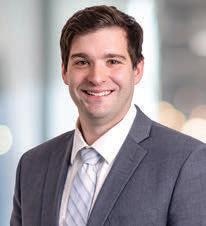

















What drew A. Vince Colella and David Moss of Southfield-based Moss & Colella, P.C., to auto law is the intersection of personal tragedy and systemic injustice. Every case represents a life fundamentally altered within seconds.
Today, with drivers able to choose their own coverage limits, there are often tragic situations where people thought they were adequately covered but face financial ruin when their medical bills exceed their policy limits. Knowledgeable in the changing landscape of auto negligence

and no-fault cases, David and Vince are at the forefront of e orts to e ect changes in Michigan law to better serve the needs of residents.
During the span of their practice, the partners have successfully litigated numerous multimillion-dollar cases and thousands of cases for clients who have been injured and in need of representation. They have achieved well over $100 million in auto accident recoveries, including a $15 million verdict for a family devastated by a drunk driver near a Detroit casino.




Estate planning isn’t just about documents — it’s about people. Schluter & Hughes Law Firm, PLLC, a woman-owned practice, is redefining estate planning by uniting legal guidance with in-house care coordination. This approach brings together attorneys, nurses, and care specialists to help provide seamless support. Using its custom Continuum LifePlanSM model, the firm creates holistic plans designed to adapt to growth, change, and the unexpected.
Attorneys Dawn Schluter and Kristin Hughes have decades

of experience helping families prepare for life’s most important transitions, whether that’s legacy planning, trust administration, navigating health care decisions, protecting assets, probate, or supporting a child’s educational journey.
This dedication to innovation and compassion has earned the firm recognition throughout the community, and co-founder Dawn Schluter a place in Michigan Lawyers Weekly ’s 2025 Hall of Fame. At Schluter & Hughes, the belief is simple: Every life’s a journey, and no one should have to navigate it alone.





DUGGAN BERTSCH, PLLC, is a premier law fi rm serving high-net-worth individuals, families, and businesses in estate planning, wealth preservation, and corporate matters. With a multidisciplinary approach integrating legal, tax, and fi nancial strategy, the fi rm delivers tailored solutions across trust and estate administration, probate, guardianship, and conservatorship.
From forming family o ces to navigating complex business structures and cross-border planning, DUGGAN BERTSCH

provides clarity and confidence at every step. Its attorneys are nationally recognized for thought leadership and unwavering commitment to excellence.
Clients rely on DUGGAN BERTSCH for personalized service, deep legal insight, and trusted counsel in an everevolving landscape. Whether protecting assets or planning for succession, the fi rm stands as a beacon of innovation and integrity.
Connect with a member of the team today!







A relentless and fierce advocate for his
is one of the foremost

malpractice and
injury attorneys in the nation. During his 43-year legal career, Brian has perennially supervised or generated Michigan’s top verdicts and settlements, including the 2024 $120 million jury verdict for a child who su ered permanent brain
and cerebral palsy due to the delay in his delivery via C-section and the 2018 $130 million verdict that won McKeen &
The National Trial Lawyers’ Trial Team of the Year Award. Brian served as co-chair of the American Association for Justice’s Medical Negligence, Professional Negligence, and Birth Trauma litigation groups from 2006 to 2008 and belongs to numerous professional associations, including the Inner Circle of Advocates, an invitation-only group limited to 100 lawyers of excellent character and integrity, representing people throughout the United States.







For nearly 40 years, Ven Johnson has been going toe to toe against insurance giants, corporate behemoths, and the government — and winning big for clients across the country. As a plainti ’s personal injury attorney specializing in civil rights, police misconduct, product liability, and medical malpractice, Ven has a sterling track record that includes jury verdicts and settlements over $1.5 billion, with 30-plus verdicts exceeding $1 million. His landmark $100 million victory in Edwards/Blasingame v. Grubbs in 2022 represents the

largest police excessive force jury verdict in the U.S. to date. Beyond the courtroom, Ven is a sought-after legal authority. Providing expert commentary on today’s top issues, he’s frequently featured by CNN, CBS News, ABC News, Fox News, The Washington Post, The New York Times, Forbes, and others.


An active member of the legal community and a recognized champion of the law, Ven and his team continue to battle relentlessly for clients every day — because justice is worth the fi ght.




Results speak louder than promises. After decades fi ghting complex cases on both sides of the courtroom, Todd Flood has learned what it takes to win.
Starting as an assistant prosecutor in Wayne County, he worked with the best people on every level — people who cared and took a vested interest in teaching. Some of the best trial lawyers in the country were in Frank Murphy Hall of Justice.

Flood has taken his decades of experience and put together a team with the same drive, passion, and heart to fi ght for justice. Flood Law delivers victories for people on every level, from the small to the catastrophic. For people who have lost loved ones or have had life-changing injuries, for people who have been assaulted or abused, for people who have su ered from a hostile work environment, the Flood Law team has fought those fi ghts and won.





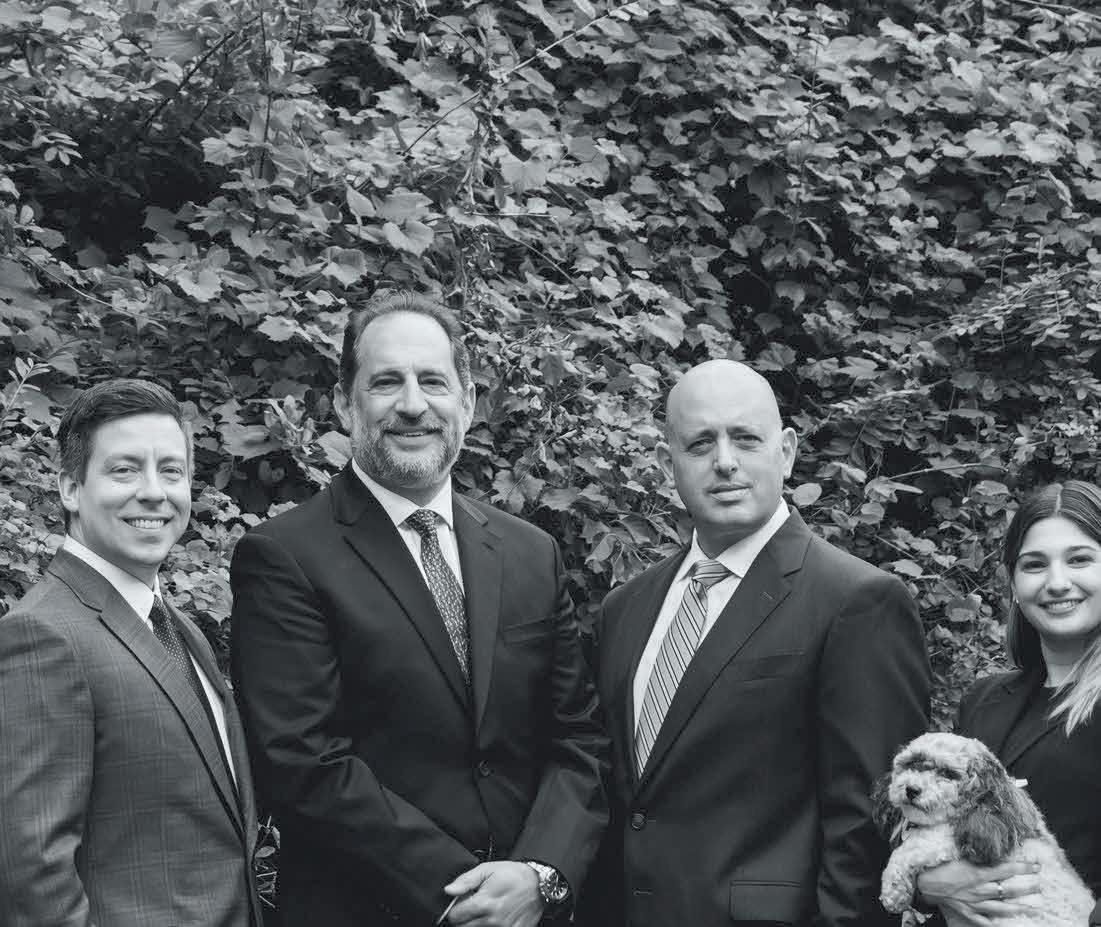







The team members at Paesano Akkashian, PC are committed to providing the highest-quality legal services with the personalized care of a boutique practice. They understand that each client has unique goals and that every matter presents specifi c challenges and opportunities. Their mission is to craft thoughtful, strategic solutions that protect their clients’ interests and drive their success.


The attorneys at Paesano Akkashian have deep and broad knowledge and experience in all aspects of business. They serve a wide range of clients, from families and entrepreneurs to established corporations. Whether navigating a complex dispute or structuring a business transaction, they approach every matter with precision, creativity, and integrity.
At their core, the team members at Paesano Akkashian are more than just legal advisers. They are partners in their clients’ success, delivering tailored counsel, safeguarding what matters most, and helping clients move forward with confidence in a constantly changing business and legal landscape.



The contemporary business landscape is evolving at an unrelenting pace. Today ’s leaders need rapid , impactful results . Since 1874, Kerr Russell has been setting the standard for legal innovation in and beyond Michigan .
kerr -russell.com













































Garmin Fenix 8
Looking to run, jog, swim, or walk in style? As a premium multisport GPS smartwatch, the Garmin Fenix 8 is just what you (or the recipient of your gift!) will need. The dive-rated watch includes a speaker and a microphone for voice messages and a built-in LED flashlight, and features leakproof buttons, a metal sensor guard cover, a scratch-resistant lens, and a titanium bezel. There’s also a round-trip routing feature that allows users to enter a preferred distance and receive suggested routes. In addition, users can view terrain contours on TopoActive Maps 3 to access preloaded maps for golf courses and ski resorts around the world. Available online or at Gazelle Sports in Northville Township.
Price: $1,099.99

Wondering what it would be like to experience signature cocktails, a lavish dinner, and dessert on a private balcony perched above Royal Street in New Orleans Square at Disneyland? Located upstairs from the Pirates of the Caribbean attraction, the 21 Royal package o ers a seven-course dinner, wine pairings, park-hopper tickets, valet parking, and luxury coach transport. To obtain the freshest ingredients, the Disney culinary team works directly with premier suppliers including farmers and fishermen, as well as other sustainable sources. Reservations are available for up to 12 guests.
Price: $18,000 for 12 people (price subject to change)


BY R.J. KING






The next big thing in sports entertainment is the Detroit City Football Club’s new 15,000-seat stadium, which is scheduled to open at the southwest corner of Michigan Avenue and 20th Street in southwest Detroit in spring 2027. To be called AlumniFi Field, the venue will o er a number of luxury suites, exclusive club access, all-inclusive premium food and beverage options, and parking. Once open, the facility will be used primarily as a soccer stadium, but there will be an opportunity to host other activities such as outdoor concerts, large conferences, and community events.
Price: $500 deposit for suites, total cost NA






Available in yellow gold or white gold, Shinola in Detroit has created its first diamond tennis necklace. The heirloom, which plays o the convergence of sport and popular culture, can be worn every day or on special occasions. The 18-inch necklace sparkles with 115 diamonds and has an average metal weight of just under 28 grams. To complement the jewelry piece, Shinola o ers a 7-inch diamond tennis bracelet (1 carat) for $2,895 or a 7-inch diamond tennis bracelet (4 carat) for $7,495. Shinola also carries watches, straps, leather goods, leather bags, other jewelry, and a lifestyle collection for the home or o ce.
Price: $17,150
No one ever spent the night at the famed Hudson’s department store in downtown Detroit, but the next best thing is to live on the upper half of a luxury tower built on the site of the famous retailer from bygone years. The 48-story tower, which will include The Detroit EDITION Hotel, is scheduled to open in 2027. The tower is separated by a walkable plaza that connects to a 12-story mixed-use structure that will include General Motors Co.’s new world headquarters, o ces for Ven Johnson Law, other Class A o ce space, retailers like Avo, new restaurants, and activated public spaces. Overall, the two buildings span more than 1.5 million square feet of space.
Price: $1M+ per condominium (exact pricing NA)




Whether arriving at an opera, a symphony, or a concert, nothing beats pulling up in an all-new 2025 Lincoln Navigator Black Label SUV. With seating for up to eight people, the Navigator Black Label o ers the highest level of luxury, space, and technology in the Lincoln lineup; the Black Label trim options include exclusive design themes, premium materials, and special features such as massaging seats, virtual scents, pre-programmed seat reclines, and calming rejuvenation modes. It also includes Lincoln’s BlueCruise technology for hands-free driving on compatible highways. Other customization includes exclusive exterior colors, special interior materials, and unique trim elements.
Price: Starts at $116,995


The Apple iPhone 17 Pro Max, which made its debut in September, features a 6.9-inch Super Retina XDR display, an A19 Pro chip for advanced performance, an upgraded 18MP Center Stage front camera, and an all-new telephoto camera with 8x optical zoom and an 8x optical quality zoom. It boasts enhanced thermal management with an Apple-designed vapor chamber and longer battery life, and supports advanced connectivity like 5G and Apple Intelligence. The smartphone also supports Hollywood-level e ects with the first-ever Genlock feature for camera synchronization. Available at local Apple stores, including the new store in downtown Detroit, online, or through mobile carriers.
Price: Starts at $1,199 for the 256GB model, $1,999 for the 2TB model

For those looking to recreate a casino setting at home, an o ce, or a local banquet hall, Las Vegas Knights in Burton o ers a range of custom-made tables for classic games like craps, roulette, blackjack, poker, or Texas hold ’em. Other games include Money Wheel, Red Dog, Baccarat (preferred by James Bond), Chuck-a-luck, and Casino War. Ryan Doyle, owner of Las Vegas Knights, began crafting casino tables with his dad in the late 1980s. Doyle says he uses multiple woods, but favors cherry wood and walnut. He also creates leather-wrapped padding. The company arrives with most everything for a casino-style event, including gaming tables and dealers. The host typically provides chairs and any prizes.
Price: Starts at $550 for two tables, gambling items, and dealers
DesignTeam Plus in Birmingham has carved out a niche for itself designing breweries across Michigan.
BY TIM KEENAN | JOSH SCOTT
For patrons of microbreweries in Michigan, there’s a good chance their favorite spot was designed by DesignTeam Plus in Birmingham, which has completed nine projects and contributed to the design of many more since 2015.
The company’s brewery projects stretch from downtown Farmington to Cheboygan, and have ranged from basic interior redesigns to historic preservations and, more recently, ground-up construction projects. Each design reflects the vision of the brewery’s owner.
“When they come to us, we ask them to give us three adjectives to describe how they want their space to look,” says Shari Stein, co-owner and principal interior designer at DesignTeam Plus. “Every single brewery that we’ve done is completely different. They all want to be different than anyplace else. No cookie-cutters.”
How did a design shop in Birmingham that opened in 2012 become a go-to for breweries? It began with the first establishment it took on: Draught Horse Brewery and Spirits in west Oakland County’s Lyon Township.
“It all starts with an individual story,” says Harold Remlinger, co-owner and principal architect at DesignTeam Plus. “In this client’s case, he and his wife are horse owners. We started looking at old equestrian barn interiors so those ideas could translate to their brand identity.”
The overall objective, according to Remlinger, was the adaptive reuse of a vacated 3,600-square-foot Mexican restaurant. DesignTeam Plus’s response was to create a horse stable tack room.
The interior tap room design incorporated:
• Blackened metal welded frames to resemble horse stalls.
• Reclaimed barnwood beams at the ceiling level with wood block tackle, to resemble a morticeand-tenon barn construction.
Harold Remlinger, co-owner and principal architect of DesignTeam Plus, specializes in crafting one-of-a-kind breweries built around themes and personal client stories.

• Wood plaster lath walls salvaged from homes demolished in Detroit as part of the city’s blight removal program.
• Double-hung windows that were reclaimed on-site.
• Tabletops and bar tops that were made from repurposed compressed straw, reinforcing the overall horse theme.
• Wall art made from a variety of the owners’ collection of antique saddles, bridles, stall doors, and hand tools.
The exterior design included:
• Preserving the building facade’s board-and-batten siding treatments.
• Installing large streetside windows to enable patrons to see the brewery equipment in production from the street.
• An entry door resembling a horse stall door with forged metal grillwork over-glazing.
• An all-season outdoor terrace with wood timber beams and a fireplace.
• Oakland County’s only township-approved horse parking lot spots, with hitching posts that meet the U.S. Department of Agriculture and U.S. Forest Service’s Equestrian Design Guidebook’s specifications.
The success of the Draught Horse Brewery and Spirits project led to others, which led to others.
“One thing we like about the beer industry is every microbrewer is a friend of another microbrewer, and they welcome each other into their community,” Remlinger says. “They help each other out.”
Word of mouth led to more projects, and once DesignTeam Plus gained added experience, it developed a proficiency.
“You have to understand it to be able to design it,” Remlinger says, especially when it comes to the brewhouse infrastructure.
“With the brewery in mind, you’re dealing with waste disposal that includes solids,” he explains. “There’s storage for used grain, glycol chillers that are going to all the fermenters, and CO2 storage, delivery, and monitoring systems. You have to understand the flow and function of the back room, from the raw materials coming in to the completed product going to distribution.”
Another notable project was Stiggs Brewery and Kitchen in Boyne City.
“Stiggs was the former Boyne City-to-Gaylord-toAlpena railroad office building,” Remlinger says. “That was a historic preservation project.”
Maintaining the character of the building’s interior and exterior was critical. The flow and organization of the interior space was guided by the original glass hallway partitions, according to Remlinger. Preservation of the original wood tongue-and-groove beadboard paneled walls, ceiling, and hardwood floors influenced the interior design.
DesignTeam Plus collaborated with a local artist to create a bottle cap mosaic on the bar face, which was reminiscent of the historic flow-through spittoon trough bar face and gutter. The designers also integrated mosaic patterns for the tabletops.
Reminiscent of 19th century life, the bar’s 31 taps were mounted to a 72-inch lumberjack cross-cut saw. The bar is a solid piece of white pine, the exterior door handle is a logging hatchet, and the plaid bottle cap design of the tabletops plays off the stereotypical plaid flannel worn by lumberjacks.
Number of breweries designed
Black Hop Brewstillery, Berkley
Cadillac Straits Brewing Co., Madison Heights
Cheboygan Brewing Co., Cheboygan
Drafting Table Brewery, Wixom
Draught Horse Brewery, Lyon Township
Heights Brewing Co., Farmington
Loaded Dice Brewing Co., Troy
Rustic Leaf Brewing Co., Waterford Township
Schmucks Brewing Co., Howell
Stiggs Brewery and Kitchen, Boyne City
Stumblebum Beer Co., Troy
Largest project: 5,546 square feet

Number of church/ synagogue projects

Number of states worked in
Source: DesignTeam Plus

Closer to home, Heights Brewing in downtown Farmington is another DesignTeam Plus project.
e clients, owners Ryan Kavanaugh and Shawn MacDonell, wanted their business to connect with the community.
“One of the things I very much wanted was for people to have the experience of being able to look in and see the fermenters, see everything going, and try to gure out what’s coming out next,” Kavanaugh says of his vision.
“I wanted a brick wall, which is part of the schtick for our lifetime mug club. Every name you see is a member of the mug club. We wanted to make people part of the establishment; put them on the wall.”
e interior design also incorporates a custom wallcovering of a “beer map” of Michigan, tagging a brewery to each beer style — all connecting back to Heights Brewing. It also features the building’s original concrete oor from the 1940s, as well as a mosaic from the restaurant’s past when it was called Steinhaus.
“ is is history,” Kavanaugh says of the establishment. “ is is gorgeous.”
Critical to the design of the brewery was the necessity to o er a gluten-free beer and food menu, creating an additional level of planning and design. To brew gluten-free beer, the brewery must shut down and all the equipment has to be thoroughly cleaned so the gluten-free beer can be safely brewed.
“We created two grain mills, regular and gluten-free,” Remlinger says. “Both rooms have exhaust systems, so they’re removing any particulates in the air.”

IT SHOULD COME AS NO SURPRISE that the state of Michigan ranks eighth in the U.S. in its number of craft breweries, with 418, and is 15th in breweries per capita at 5.5 per 100,000 people older than 21. Michigan has been a beer-brewing mecca since the 1800s, when commercial brewing took hold in places like Detroit and Milwaukee.
Between 1930 and 1950, English, Irish, and Scottish settlers brewed predominantly ales, which was reminiscent of the Old Country. In the 1850s, German brewers like Bernhard Stroh began producing the lager style that was part of their heritage.
Prohibition put a dent in the beer-brewing business between 1917 and 1933, and companies like Stroh made “near beer” and ice cream to stay afloat.
After Prohibition and World War II, Stroh, Goebel, and Pfeiffer were the major players in Detroit brewing. Through acquisition, Stroh
became the third-largest brewer in America before closing its iconic Detroit plant in 1985.
While Stroh was winding down its operations, microbrewers like the Real Ale Co. in Chelsea, Kalamazoo Brewing Co., and Frankenmuth Brewery began popping up in the 1980s. Between 1992 and 2013, the craft brewing universe grew to 151 establishments from three.
Now, with more than 400 microbrewers operating around Michigan, the industry maintains more than 14,000 jobs and generates in excess of $1.8 billion in revenue, according to a presentation made by Scott Graham, executive director of the Michigan Brewer’s Guild, which represents about 75 percent of the state’s brewers. The industry also supports local agriculture that grows raw materials like hops, barley, fruit, herbs, and vegetables.
— Tim Keenan


HOUSE OF ALE
Top and center: Heights Brewing Beer Map; Remlinger and co-owner Ryan Kavanaugh inspect the brewing process.
RIght: Remlinger and Kavanaugh with co-owner Shawn MacDonell.

At most microbreweries, the brewhouse is separated from the taproom but visible through a window, like at Heights Brewing. One exception is Cadillac Straits in Madison Heights, which also serves as a supply house for home-brewers.
“At Cadillac Straights, the brewhouse sits in the middle of the restaurant,” Remlinger says. “They wanted to do a teaching brewery for their homebrewer clubs.”
Until recently, all of the projects DesignTeam Plus has worked on have been redesigns of existing spaces. Current and future projects will feature new-builds including a brewery in Wyandotte and a distillery in Detroit, and working as a consultant on a ground-up brewery project, also in Detroit.
DesignTeam Plus has another somewhat surprising specialty in addition to its focus on breweries: Coptic Orthodox churches and other religious buildings.
To date, the company has worked on the design of St. Mark Coptic Orthodox in Troy, St. Nina Coptic Orthodox Church in Shelby Township, St. Mary and St. Anthony Coptic Orthodox Retreat and Conference Center in Newport, north of Monroe, and the Jewish Resource Center in Ann Arbor.
Remlinger, who also has projects in health care, commercial retail, law enforcement, and other sectors in the DesignTeam Plus portfolio, says, “We found that being diverse helps you ride the ebbs and flows of the industry.”
John H. and Will K. Kellogg, through their shared development of a breakfast staple, helped establish Battle Creek as an economic and health mecca.
BY NORM SINCLAIR
The history of corn flakes, the cereal that dramatically changed breakfast habits in America and worldwide, began when two brothers in Battle Creek accidentally discovered how to make flaked cereal from wheat grain 130 years ago.
It’s also a tragic tale of a bitter sibling rivalry that consumed their lives for generations until they were, literally, on their deathbeds.
John H. Kellogg, a renowned doctor and author, and his brother, Will K. Kellogg, eight years his junior, each claimed credit for the breakthrough of first making flakes from wheat crumbs before using corn to produce the iconic breakfast favorite.
Although various reports have blurred the narrative of who was first, most biographers agree a boiled batch of wheat-berry dough that John Kellogg most likely had mixed to make bread was forgotten on a counter overnight, and that oversight began a process that eventually made the Kellogg name famous.
Instead of throwing out the now-fermenting dough mixture the next morning, John and Will decided to roll the mixture flat, which caused it to break into flakes. The brothers baked the flakes and added milk, and were pleased with the positive feedback they received from their taste-testers.
A patent for “Flaked Cereals and Process of Preparing Same” was issued to John H. Kellogg on May 31, 1895. The patent recognition, however, triggered the Kelloggs’ first public spat, as Will insisted he should have been recognized and given more credit for the discovery of flaked cereal.
The invention and worldwide acclaim for corn flakes would come a few years later, when the development further fueled the dysfunctional relationship between the brothers that likely emanated from their abnormal childhood.
John Kellogg was born in 1852 on a farm in Livingston County. His brother, Will, was born after the family moved to Battle Creek. Will was the seventh of their father’s 16 children, which included six from his previous marriage.
The family’s early frontier living was hard on the


group. Six of the children died within a nine-year span of various infectious diseases.
John survived tuberculosis, although he had to deal with one functioning lung for the rest of his life. He also suffered from painful bowel and digestion disorders, precursors of his later preoccupation with diets and healthy eating habits.
Their parents, John Preston Kellogg and his wife, Ann, were reluctant to educate their children, assuming it wasn’t worth the effort since they would probably die from disease anyway. They were also converts to a newly founded religion: the Seventh-day Adventists, whose followers believed the Second Coming of Jesus was imminent. Since the world could come to an end at any time, the parents reasoned that education didn’t matter.
John was their favorite and brightest child, while Will was dismissed as unintelligent and dimwitted. His parents rarely intervened when John repeatedly bullied and verbally and physically abused his brother.
The family’s relocation to Battle Creek was spurred by the parents’ desire to join the large founding Seventh-day Adventist congregation in that city. John Preston Kellogg also saw a business opportunity to start what became a thriving broom factory.
Over time, the Kelloggs relaxed their views somewhat on education and allowed John to attend grammar school. The boy’s reading skills were so pronounced, he attracted the attention of the most influential elders in the church — James and Ellen White, the founders of the Seventh-day Adventist faith.
John was 12 years old when the Whites hired him as a novice to work in the church’s print shop. He rose from errand boy to editorial assistant, and in the process absorbed many of the articles written about the Seventh-day Adventists’ focus on healthy living and eating habits.
At age 20 he enrolled in a teaching course offered by Michigan State Normal School, now Eastern Michigan University.
With support from the Whites, John attended a
six-month medical course in New Jersey, gained admission to the University of Michigan’s medical school, and upon graduation spent a year of residency at Bellevue Hospital Medical College in New York City.
In his mid-20s, he returned to Battle Creek. With the backing of his patrons, the Whites, he was named director of a massive clinic, the Battle Creek Sanitarium, owned by the Seventh-day Adventists.
The San, as it was called, was a multifaceted facility — part hospital, rehab center, and spa. At its peak, the resort-like San accommodated 3,000 guests and patients. The newly minted doctor found it a perfect fit, as his theories for healthy living mirrored the teachings of his church.
Treatments for patients at the San espoused by Kellogg included a vegetarian diet, enemas to clear “intestinal flora,” exercise, sunbathing, fresh air, lectures on personal hygiene, drinking plenty of water, good sleep habits, and abstinence from using tobacco, alcohol, and caffeine.
He also promoted sexual abstinence, and believed that rich or spicy food stimulated sexual desires and should be avoided in favor of plain, bland-tasting food like grains and nuts.
Will Kellogg’s path to adulthood, meanwhile, was much more painful than that of his older brother. His father dismissed teaching him to read as a waste of his time, and his mother never warmed up to him.
Will was 6 years old when his father put him to work full time, six days a week, in the broom factory. Young Will had Saturday, the Seventh-day Adventist Sabbath, as his day off.
A few years later he was allowed to attend school, but his education ended in the sixth grade when his father pulled him out of class to become a salesman, peddling brooms for the family business.
In his 20s, Will discovered that his perceived lack of intelligence was the result of previously undiagnosed nearsightedness. Upon receiving corrective lenses, he engaged in extensive self-education through reading, and subsequently earned a bookkeeping certificate from Parson’s Business College in Kalamazoo.
In 1880, Will went to work for his brother at the
Battle Creek Sanitarium. In a time when Americans were obsessed with digestion and healthy bowel movements, Dr. John Kellogg had become a nationally known health guru through his extensive writing of articles and books on diets and healthy eating habits.
The doctor’s prominence attracted patients and guests from abroad as well as numerous American celebrities. Visitors to the San included President William Howard Taft, Henry Ford, Thomas Edison, playwright George Bernard Shaw, Amelia Earhart, Johnny Weissmuller, the Tarzan movie star, Black activist Sojourner Truth, and others.
Although Will was hired with the title of bookkeeper, his brother treated him as his flunky. He insisted Will always address him as Dr. Kellogg, andWill was required to follow John around with a notebook, writing down his brother’s thoughts, even during trips to the bathroom.
Visitors to the San would gape at the sight of John riding his bicycle across the campus with his brother running alongside, trying to keep pace while taking notes.
With his interest in creating digestible food and meat substitutes, John spent hours in the sanitarium’s test kitchen concocting grain-based mixtures. He was assisted by his wife, Ella Eaton Kellogg, herself the author of cookbooks devoted to vegetarian diets.
Among the 30 patents John was awarded are a peanut butter paste, soy milk, and Protose, a meat substitute he created from grain and nut cereals. Other patents were for his design of medical devices.
The brothers’ discovery of baked wheat flakes served with milk was an instant hit with patients and clients staying at the San. It also created a revenue stream, as John instructed Will to institute a mail-order service to enable former patients to buy and continue enjoying the new breakfast food at home.
One of those patients who took notice was C.W. Post, who went on to produce his own line of toasted cereals. He introduced Grape Nuts cereal based on John Kellogg’s granola biscuits, and created a cereal-based drink he named Postum, copied from Kellogg’s imitation coffee drink. Post’s Postum Cereal Co. reportedly earned $3 million in 1900.
His immediate success wasn’t lost on Will Kellogg.
Despite serving in a subordinate position to his brother, Will’s strong work ethic enabled him to become the leading manager of the sanitarium. He acted as the institution’s administrator, oversaw the publishing house responsible for distributing John’s books, and managed the new mail-order food service.
Will noted, albeit discreetly, that he was working up to 120 hours per week while receiving only a modest salary from John.
At his brother’s bidding, Will developed a small factory in the San where he sold 10-ounce packs of wheat flakes for 15 cents. In the first year of production, they sold 113,000 pounds of flakes.
Unlike his brother, whose interest in the venture was promoting good digestion, Will saw the commercial value of convenient, tasty breakfast food.
He began devoting considerable time to experimenting with various grains, adding ingredients like
sugar and salt to improve the taste. Eventually he focused on corn, which was sweeter.
In 1897, John agreed to partner with Will in forming Sanitas Food Co. to meet the growing demand for the cereal they named Granose. The following year they introduced Sanitas Toasted Corn Flakes, followed by Granose Biscuits.
In the early 1900s, Will was pushing his brother to add sugar to their corn flakes, but John balked at the idea. That disagreement prompted Will to buy John’s rights to the manufacture of corn flakes. In 1906, Will founded the Battle Creek Toasted Corn Flake Co. and hired his first 44 employees.
Will’s flair for advertising drove his new company to ship out 175,000 cases of corn flakes that first year.
Sales grew fifteen-fold during a newspaper and magazine advertising campaign he created that instructed women to “wink at your grocer and see what you get.” What you got was a free sample of Kellogg’s corn flakes.
Will Kellogg’s breakfast-served-out-of-a box cereal gained traction across the country, showing up in nearly every pantry in America. Soon, Battle Creek was nicknamed Cereal City as more than 30 cereal manufacturers, including C.W. Post, set up shop there.
In 1908, John created his own cereal company and began marketing his version of corn flakes with the name Kellogg, touching off a decade-long legal battle between the brothers.
Will was afraid consumers would confuse his brother’s corn flakes with his sweeter version. He went to court and obtained a court injunction to stop John from using the family name on his cereal boxes.
Will introduced Kellogg’s Bran Flakes in 1915 and Kellogg’s Rice Krispies a year later, even as the legal battle played out.
In 1920, the Kellogg fight reached the Michigan Supreme Court. The justices ruled in Will’s favor, upholding a lower court ruling preventing John from
An early advertisement from Will K. Kellogg distinguishing his “sweeter” flakes.

using the Kellogg name on his cereal products.
Adding more fuel to their sibling fire, the court ordered John to pay Will’s legal fees, and to pay him the profits John’s cereal business had earned in the preceding 10 years.
After that decision, the brothers rarely spoke to each other. If they had to meet, Will insisted a third person be in the room.
In 1922, Will changed the company name to the WK Kellogg Co and expanded the business to Canada, Britain, Europe, Asia, and Australia.
The private lives of both men remained chaotic. John was never able to shake off his jealousy and anger over Will’s success, while Will, despite emerging from his brother’s shadow and earning immense business success, alienated those around him as he turned bitter, paranoid, and hostile.
He married twice and had five children with his first wife before she died; two of those children also died young. His two surviving sons eventually severed their relationships with him.
Because of his celibate views, John and Ella Kellogg never consummated their marriage and maintained separate bedrooms throughout their 40-year union. And despite John’s avowed views as a segregationist, he and Ella legally adopted eight children and were foster parents to 34 others.
Will, who once complained that as a child he never learned to play, gave away much of his wealth to charities that supported youth activity.
In 1934, during the Great Depression, he donated $66 million to establish the W.K. Kellogg Foundation, to help families pay for care for their sick or injured children. The foundation remains one of the world’s largest philanthropic organizations, and has spawned other institutions such as the Kellogg Eye Institute at the University of Michigan.
According to Grand Rapids-based author Erica Emelander, the battling Kellogg brothers experienced one last tragic twist in their relationship just before each man died.
In 1943, at age 91, when John was on his deathbed, he dictated a letter to Will apologizing for his lifelong bad treatment of his brother, and asked to make amends for his mistakes.
His secretary decided, however, that the letter made John, the boss she admired, sound weak and she never delivered it until eight years later, when Will — by then also 91 years old — was near death.
Ironically, the letter had to be read to him because glaucoma had robbed him of his sight over the last 10 years of his life.
In 2023, the WK Kellogg Co was split into two independent businesses. Kellanova became a global snacking operation, based in Chicago, while the North American cereal business WK Kellogg Co. remained in Battle Creek.
Earlier this year, the Italian chocolatier Ferrero Group, which produces Nutella, Kinder, and Ferrero Roche, agreed to buy the cereal company for $3.1 billion in cash. When the deal closes at the end of the year, Battle Creek will continue as the Kellogg brand’s North American headquarters under Ferrero.
The health care industry is increasingly using artificial intelligence to improve patient care, reduce costs, and speed diagnostic accuracy.
BY DR. ANTHONY ORAHA
Arti cial intelligence is transforming health care on both the patient-facing side and behind the scenes.
From hospitals to private practices, AI is changing the way care is delivered. It improves processes and functions, and helps medical practitioners provide better patient care. e integration of AI allows more personalized and e ective treatment plans, reduces health care costs, and boosts diagnostic accuracy
IMPROVING PATIENT OUTCOMES — AI has made incredible strides in the eld of diagnostics by analyzing radiology/medical imaging, lab results, and patient data. In an emergency department in a rural location, for example, before a patient team suspects a stroke caused by a large blood clot that’s removable (curing the patient), it typically obtains a CT angiogram of the patient’s head and neck.
Upon performing a CT scan, it typically takes anywhere from 10 minutes to 30 minutes before a radiologist can make the crucial decision of whether or not to transfer the patient for a life-saving procedure.
Today, this decision can be made in seconds, thanks to an AI interpretation of the imaging. is leads not only to improved outcomes for the patient and e ciency in the emergency department, but it also reduces diagnostic error.
BEHIND THE SCENES WORKFLOW — In recent years, doctor’s o ces have improved their e ciency and accuracy by relying on an AI scribe. With consent, the doctor can use the AI scribe to spend more time communicating with the patient instead of typing and clicking off boxes on a computer.
During busy emergency department shifts, my microphone listens in and is able to di erentiate the patient, medics, and family members while accurately documenting the encounter.
Multi-site studies and real-world deployments report less after-hours charting, lower documentation burden, and better clinician focus on the patient — small gains that compound across thousands of encounters.
PERSONALIZED MEDICINE — I’ve seen this in my practice, most notably in the eld of oncology. Imagine a patient receives a life-changing cancer diagnosis. Now, using AI, the patient’s tumor is analyzed for very speci c biomarkers, which are then overlapped with hyper-focused treatments.
From there, the data is assessed alongside hundreds of clinical trials, minimizing side e ects and maximizing patient outcomes.
PREVENTIVE CARE — As wearable devices continue to grow, doctors are using the data to their advantage to track biometrics that may re ect chronic conditions. We now have the ability to collect and analyze real-time data using AI, which can be used to notify physicians and predict complications before hospital admissions are required.
rough these AI-driven monitoring systems, hospitals can provide better care and reduce the strain on their limited resources.
In private practices, preventive care has been enhanced using AI. At my longevity and preventive health practice, we use AI tools to get in-depth pictures of coronary arteries — the vessels that supply blood and nutrients — to understand risk, create a comprehensive plan, and assess plaque by the cubic millimeter. is was previously impossible.
THE OPERATING ROOM — Recently, a robot autonomously and successfully removed the gallbladder of a cadaver pig after watching (or mimicking) surgeons at Johns Hopkins University. While more time is needed before we see robots operating independently in the operating room, today AI is augmenting surgeons and the di cult decisions they may face in the operating room.
With the assistance of AI, patients may reduce surgery complications by 20 percent and improve recovery times by 15 percent.
candidates to be included in experimental trials for medications — a current hurdle across the entire pharmaceutical industry.
PATIENT EXPERIENCE — AI-powered assistants and virtual chatbots have eased the process of making appointments, sending reminders for medications, and following patients after they’re discharged. AI reminders and prompts have improved patient compliance and reduced no-shows for appointments.
In turn, AI-driven apps allow patients to see their results and health trends in real time. In my practice, we’ve implemented an AI-driven app that’s physician-led and enables my patients to trend their datapoints, and enables me to assess this in real time.
Looking ahead, AI is absolutely revolutionizing health care, enhancing diagnostics, adjuncting physician skills, accelerating drug discovery, and assisting with administrative tasks.
e end goal is clear: improve patient outcomes, reduce costs, and increase e ciency.
As AI evolves, so will its challenges. In the future, I see a health care model where we can instantaneously run clinical ndings, labs, imaging, and other biomarkers alongside thousands, if not millions, of other biodata points for diagnostics, treatment, and predictive models for patients.



IMPACT ON PHARMA — Most notably (and impressively), AI has been implemented in the pharmaceutical industry. It has been able to increase the speed of drug discovery as well as clinical trials. AI now gives us the ability to analyze large data sets, identify potentially promising drugs, and predict their e cacy.
Discovering new drugs, a process that can take years, now takes weeks. Most statistics predict that AI will reduce drug discovery time by as much as 50 percent. With its ability to analyze millions of data points, AI can predict successful patient outcomes more accurately, and it can quickly screen patients who are







As the technology continues to grow, so will its potential to impact health care.






PATRICK GLORIA
The Community House of Birmingham hosted its annual Pillars of Vibrancy Jubilee on Sept. 27 at the Community House. The event included a plated dinner and a program that included a keynote interview between the organization’s chair, Camille Jayne, and Ret. Judge Gerald E. Rosen, chief mediator in the Detroit bankruptcy and author of “Grand Bargain: The Inside Story of Detroit’s Dramatic Journey from Bankruptcy to Rebirth.” Six community leaders, including Rosen, were honored. They included Sheri Mark, Anthony Marsalese, Lisa Phillips, Ed Siaje, and Dr. Jesse Selber.
1. Lisa Phillips, Tresa Galloway
2. Sherry Singer, Anthony Marsalese, Bobbie Tweddle, Deric Righter
3. Ed and Noell Siaje
4. Malak Fawaz, Moe Hammoud
5. Lindsay Shanahan, Dr. Jesse Selber






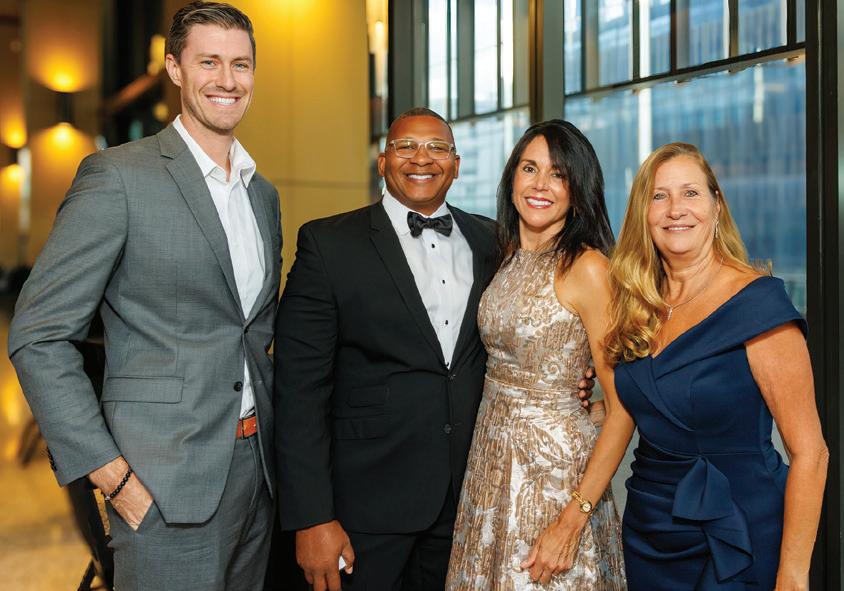

PATRICK GLORIA
Fair Lane: Home of Clara and Henry Ford in Dearborn hosted its annual An Evening for Fair Lane fundraiser on Aug. 27. The event began on Fair Lane’s outdoor north patio and continued through the estate’s restored first and second floors. From there, guests strolled through Clara’s gardens before enjoying a strolling dinner beneath the stars in the tented Bowling Green. Andrew Frick, president of Ford Blue and Model e, and his wife, Marci, and Edsel B. Ford II, great-grandson of Clara and Henry Ford, hosted the evening.
11. Andrew Frick, Elena Ford, Callie Rippolone, Marci Frick
12. Robert Bury, Patricia Mooradian, Ellen Hill Zeringue, Spence Medford, Mary Ann Bury
13. Gary and Christine Gonzalez, Linzie and Jon Rimanelli
14. Alfred Miller, Mark Douglas
15. Carol and Mike Ritchie




PATRICK GLORIA
The Automotive Hall of Fame in Dearborn conducted its 2025 Induction Ceremony on Sept. 25 at The Department at Hudson’s in downtown Detroit. Inductees included legendary automotive journalist David E. Davis Jr.; Ayrton Senna, one of history’s greatest Formula 1 drivers; Betty Skelton, a trailblazer in American motorsports and aviation who broke barriers for women in male-dominated industries and helped develop and promote the Chevrolet Corvette; and former top Daimler and Mercedes-Benz executive Dieter Zetsche, who was introduced by Roger Penske, founder and chairman of Penske Corp. in Bloomfield Township. More than 500 guests enjoyed a strolling cocktail party, a plated dinner, and the induction ceremony.
6. Don Husby, Dieter Zetsche, Roger Penske, Sarah Cook
7. Alex Copenhaver, Aaron River, Lori Lancaster, Joann Barber
8. Bianca Senna
9. Mark Royce, Robbie Buhl
10. Sean Silver, Ajay and Anna Chawla


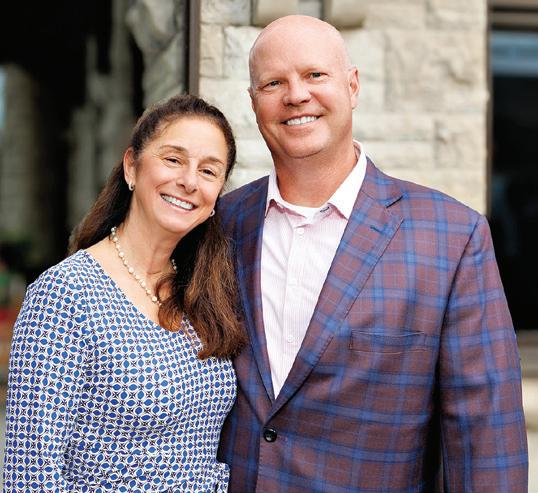










PATRICK GLORIA
DBusiness magazine hosted its third Detroit 500 Soirée at The War Memorial in Grosse Pointe Farms on Sept. 4. The event celebrated those listed in the magazine’s annual list of the 500 most powerful business leaders in more than 30 industries across metro Detroit and Michigan. Guests enjoyed a strolling dinner, champagne, cocktails, live music, a casino, and a cigar lounge. The event was sponsored by Walsh College, Bellisario Florist, the Detroit Pistons, Great Lakes Landscape Design, Hylant, Mercantile Bank, the Michigan Economic Development Corp., Quix Chocolate, Plunkett Cooney, Fifth Third Bank, Kitch Attorneys & Counselors, First Independence Bank, Shenandoah Country Club, and others.
1. Patty and John Crowe
2. The Snethkamp Family
3. Angelica Zerka, Anthony Oraha
4. Craig Catallo, Hassan Yazbek
5. Suzy Siegle, David Petosky








PATRICK GLORIA
M1 Concourse in Pontiac hosted its fifth annual Checkered Flag Ball at the Event Center at the motorsport’s track and private garage campus on Oct. 4, in conjunction with the annual American Speed Festival. Civic and industry leaders from across metro Detroit enjoyed a plated dinner, live entertainment, and an awards program. The evening’s honored guest was the 2025 American Speed Festival’s Master of Motorsports award recipient Al Unser Jr., a two-time winner of the Indianapolis 500 and the CART championship. The ball supports the Pontiac Community Foundation through M1 Mobility, which provides free van rides to almost 20,000 people in need.
11. Ralf Lindackers, Riya and Adrian Nalichowski
12. Al Unser Jr., Paul Zlotoff
13. Steve and Robin Palazzolo
14. Kassandra and Antoine Jackson
15. David Beattie, Chris Keats




PATRICK GLORIA
The Crystal Ball Neon Nights fundraiser for the McLaren Macomb Foundation took place on Sept. 20 at the MGM Grand Detroit. The black-tie evening featured a cocktail reception, a gourmet dinner, an auction, entertainment, and dancing. The event honored long-serving McLaren Macomb physicians and recognized several nurses with the annual Daisy Award for excellence in nursing care. The foundation promotes philanthropic support of McLaren Macomb in Mount Clemens.
6. Michelle Linebach, Laura Atsoff, Rachel Schick, Allison Wankitisu
7. Suzanne and Dino Marra, Judy and John Line
8. Hannah Chong, Sam Reenders
9. Alana and Tim Donohue, Pat Keigher
10. Robert and Shirley Butts













Q: What are the most common mistakes you see businesses make with securities compliance, and how can we avoid them?

A: The biggest mistake I see is treating compliance as a fire drill — something you scramble to do only when raising capital or getting contacted by regulators. That approach almost guarantees mistakes, whether it’s outdated offering documents or sloppy recordkeeping. The best-run companies bake compliance into their routine day-to-day operations pursuant to a written standard of procedure, and it pays off. A little discipline up front can save you from very expensive headaches later.
Paesano Akkashian, PC
Anthony Paesano, Founding Partner 7457 Franklin Road, Suite 200, Bloomfield Hills, MI 48301 248-792-6886 | apaesano@palawyers.com | palawyers.com






















OCTOBER 29, 2025 | 5:00 PM - 7:30 PM







BARTON HILLS COUNTRY CLUB
730 Country Club Rd. Ann Arbor
734-663-8511
bartonhillscc.com
Members: 600 (est.)
Initiation fee: Social $15,000, Resident $40,000
Monthly fee: Social $361, Resident $811
Offerings: Signature Donald Ross golf course; tennis & pickleball courts; fitness center; renovated dining room, wine bar, and resort-style pool complex with an outdoor pavilion.
BAYVIEW YACHT CLUB
100 Clairpointe St. Detroit 313-822-1853 byc.com
Members: 700
Initiation fee: $2,500
Monthly fee: $220, $150 quarterly club fee
Offerings: Indoor and outdoor dining, banquet space, marina, sailing lessons and races, regattas, and cruising activities.
BIRMINGHAM ATHLETIC CLUB
4033 W. Maple Rd. Bloomfield Township 248-646-5050
bacmi.net
Members: 600
Initiation fee: $15,000, multiple membership classifications
Monthly fee: $695
Offerings: Recently renovated indoor and outdoor dining areas,
two pools, nine clay tennis courts, six squash courts including one international court, four paddle tennis courts, four brand-new pickleball courts, two-level fitness center.
BIRMINGHAM COUNTRY CLUB
1750 Saxon Dr. Birmingham 248-644-4111 bhamcc.com
Members: 624
Initiation fee: Social $20,000, Corporate $60,000
Monthly fee: Social $745, Corporate $1,085
Offerings: Golf course, pool, tennis, fitness facilities, indoor and outdoor dining, pickleball, banquet space.
BLOOMFIELD HILLS COUNTRY CLUB
350 W. Long Lake Rd. Bloomfield Hills 248-644-6262 bloomfieldhillscc.org
Members: Limited, must be nominated by member
Initiation fee: $75,000
Monthly fee: $1,275
Offerings: Golf course, dining facilities.
BLOOMFIELD OPEN HUNT
405 E. Long Lake Rd. Bloomfield Hills 248-644-9411 bohclub.com
Members: 250
Initiation fee: Social $7,500,
Stockholding $15,900
Monthly fee: Social $550, Stockholding $750
Offerings: Dining room, swimming pool, fitness studio and yoga center, indoor and outdoor tennis, platform tennis, stables, indoor and outdoor equestrian facilities, kids’ activity center, social and holiday events for members.
COUNTRY
220 Country Club Dr. Grosse Pointe Farms
313-881-8000
ccofd.com
Private club, keeps information private.
Members: 800+
Initiation fee: NA
Monthly fee: NA
Offerings: Golf course, cross-country skiing, clubhouse, indoor and outdoor dining, tennis, paddle tennis, pickleball, pool, bowling, fitness center, children’s day camp, guest rooms, dog park.
DEARBORN COUNTRY CLUB
Only gives out information through members.
800 N. Military Dearborn
313-561-0800
dearborncountryclub.net
Members: 300
Initiation fee: NA
Monthly fee: NA
Offerings: Donald Ross golf course, swimming, fitness area,
dining, banquet facilities, junior golf, swim team.
241 Madison St. Detroit 313-963-9200
thedac.com
Members: 4,000
Initiation fee: Resident $13,500 (34 and older), Intermediate A $4,050 (age 29-30), Intermediate B $3,375 (age 26-28), Intermediate C $1,350 (age 21-25)
Monthly fee: Resident $582 (34 and older), Intermediate A $304 (age 29-30), Intermediate B $266 (age 26-28), Intermediate C $239 (age 21-25)
Offerings: Fully restored Albert Kahn-designed clubhouse built in 1915, full-service athletic facilities, pool, restaurants, ballrooms, meeting rooms, guest rooms, newly renovated bowling alley, salon, pavilion. Named No. 1 athletic club in the country from 2018-2025 by Platinum Clubs of America.
DETROIT GOLF CLUB
17911 Hamilton Rd. Detroit 313-345-4400
detroitgolfclub.org
Members: 800
Initiation fee: Available upon membership inquiry
Monthly fee: Available upon membership inquiry
Offerings: Two 18-hole golf courses, clubhouse, three dining

venues, swimming pool, swim team, tennis courts, fitness center, weddings, private events. The club hosts the annual Rocket Classic.
DETROIT YACHT CLUB
One Riverbank Rd., Belle Isle Detroit 313-824-1200
dyc.com
Members: More than 800; less than half are boating members
Initiation fee: Active members
$1,500, Boating active members
$3,000
Monthly fee: Active members
$434, Boating active members
$474
Offerings: Restaurant and bar, outdoor and indoor pools, swim team, adult and junior sailing, kayaking, tennis courts, social activities, weddings, events, more than 300 boat slips for boating members.
EDGEWOOD COUNTRY CLUB
8399 Commerce Rd. Commerce Township 248-363-7112
edgewoodcountryclub.org
Members: 450
Initiation fee: Class A $23,000, Social $4,000
Monthly fee: Class A $845, Social $390
Offerings: Golf course, golf simulation, casual and fine dining, outdoor pool, fitness center, massage therapist, event space.
FRANKLIN HILLS COUNTRY CLUB
31675 Inkster Rd. Franklin 248-851-2200 franklinhills.com
Members: 500; New members must be nominated by five members, with one acting as lead
Initiation fee: NA
Monthly fee: NA
Offerings: Albert Kahn-designed clubhouse, Donald Ross golf course, tennis, swimming, banquet space, dining room.
GROSSE ILE GOLF AND COUNTRY CLUB
9339 Bellevue Grosse Ile 734-676-1166
gigcc.com
Members: NA
Initiation fee: NA
Monthly fee: NA
Offerings: Donald Ross golf course; two full-service dining rooms; swimming pool; GIGCC swim team; clay and hard surface tennis courts featuring adult and
youth leagues, individual instruction, and professional tennis staff; social events year-round for all ages.
GROSSE POINTE YACHT CLUB
788 Lake Shore Rd. Grosse Pointe Shores 313-884-2500
gpyc.org
Members: 800
Initiation fee: Active (boating)
$15,000, Social $9,500
Monthly fee: Active (boating)
$703, Social $570
Offerings: Three dining rooms with views of Lake St. Clair; ballroom and main dining room with Italian architecture perfect for weddings, special occasions, or corporate events; fitness center; Olympic-size pool, bowling recreation center, and family activity center; 2,440-square-foot Marine Activity Center with sailing, watersports, and boat rentals. Named a Platinum Club of the World.
INDIANWOOD GOLF AND COUNTRY CLUB
1081 Indianwood Rd. Lake Orion 248-693-2598
iwgcc.com
Members: 500+
Initiation fee: Class A membership (NA), Class B membership $3,500, Family fitness membership $1,500, Social/Pool family membership $899
Monthly fee: Class A membership (NA), Class B membership $130, Family fitness membership $130, Social/Pool family membership $130
Offerings: 18-hole New and Old golf courses, driving range, Junior Golf Program for children, clubhouse, dining areas including Pipers Pub and Men’s Grill, health club, variety of club and social events.
KNOLLWOOD COUNTRY CLUB
5050 West Maple Rd. West Bloomfield Township 248-855-1800
knollwoodcountryclub.net
Members: 250
Initiation fee: Golf $35,000, Social $17,500
Monthly fee: Golf $1,500, Social $750
Offerings: Golf course; three Har-Tru clay tennis courts; four hard surface pickleball courts; aquatics center with new zero-entry kids pool and splash features, snack bar, and outdoor dining; 55,000-square-foot clubhouse; fitness center; pickleball; golf
simulator studio; banquet space for 350 people; Troon Privé – Private Clubs of Distinction; member golfing privileges at Troon-managed clubs, resorts, and courses worldwide. Newly renovated ballroom opening May 2026.
LOCHMOOR CLUB
1018 Sunningdale Dr. Grosse Pointe Woods
313-885-6966
lochmoorclub.com
Members: 450
Initiation fee: Full golf $30,000, Social $5,000
Monthly fee: Full golf $995, Social $442
Offerings: Golf course; men and women’s golf leagues; creative pop-up dining events and seasonal menus; seasonal pool bar and patio area with outdoor dining; wine club that features wine tastings/dinners; swim team for children; tennis programs; junior sports such as golf and tennis; Lochmoor Athletic Center with year-round golf training; four Trackman simulators; 1,000-square-foot indoor golf practice area with chipping, putting green, and sand bunker; fitness center; fitness trainers and physical therapy; two indoor tennis courts and two indoor pickleball courts; bar; food service.
1 Concourse Dr. Pontiac
248-326-9999
m1concourse.com
Members: 210
Initiation fee: NA
Monthly fee: NA
Offerings: Cost information reserved for members who own a garage at the track. Seven hours of track time per week; use of M1 Fleet Vehicles such as Dodge Hellcats and Lexus Performance Coupes; instruction provided by high-level driving instructors, including notable racers such as Johnny O’Connell; autocross competitions; guest events for friends/family of members to drive; exclusive social events.
MEADOWBROOK COUNTRY CLUB
40941 W. Eight Mile Rd. Northville Township
248-349-3600
meadowbrookcountryclub.com
Members: 698 (there is a two-year waiting list)
Initiation fee: Social $12,500, Golf $65,000
Monthly fees: Social $480,
quarterly food and beverage
$600, golf $710, monthly capital $250
Offerings: Golf course; 25-meter pool, lap pool, and wading pool; fountain and wading pool for little ones; private tennis programs led by Wayne Jackson; tennis events, lessons, and tournaments; indoor and outdoor dining options.
OAKHURST GOLF AND COUNTRY CLUB
7000 Oakhurst Lane Clarkston 248-391-3300 clubcorp.com
Members: NA
Initiation fee: NA
Monthly fee: NA
Offerings: Golf course, four tennis courts with USPTA pro available for clinics or private lessons, six pickleball courts, executive chef, cabana bar, junior Olympic-size resort-style pool, 1,600-square-foot fitness center, variety of social functions.
OAKLAND HILLS COUNTRY CLUB
3951 West Maple Rd. Bloomfield Township 248-644-2500 oaklandhillscc.com
Members: 500
Initiation fee: NA
Monthly fee: NA
Offerings: South and North 18-hole golf courses, tennis, swimming. Using temporary facilities while new clubhouse is under construction.
ORCHARD LAKE COUNTRY CLUB
5000 West Shore Dr. Orchard Lake Village 248-682-0100 orchardlakecountryclub.com
Members: NA
Initiation fee: NA
Monthly fee: NA
Offerings: Golf course and driving range; six-tiered clay tennis courts and four platform tennis courts; seasonal menus prepared by award-winning chefs; lakefront dining; ballroom for wedding celebrations; racquet classes, competitions, and tournament training for all ages; personal training and group fitness programs; sailing clinics; swim lessons for children.
PAINT CREEK COUNTRY CLUB
2375 Stanton Rd. Lake Orion
248-693-4695 paintcreekgolf.com
Members: 70
Initiation fee: None
Annual fees: Pool and fitness
$1,100, Corporate membership
$3,900, Family membership
$3,700
Offerings: Golf course, fitness center, pool, 20,000-square-foot clubhouse, 300-seat dining room.
PINE LAKE COUNTRY CLUB
3300 Pine Lake Rd. Orchard Lake 248-682-1300 pinelakecc.com
Members: 550
Initiation fee: Social $20,000, Stock $45,000
Monthly fee: Social $886, Stock
$1,270
Offerings: Golf course, indoor and outdoor tennis courts, Olympic-size pool, fitness center, clubhouse, dining room, grill. Waiting list for boat slips for stock members.
PLUM HOLLOW COUNTRY
CLUB
21631 Lahser Rd. Southfield
248-357-5353 plumhollowcc.com
Members: 400
Initiation fee: Stock $20,000, Social $1,500
Monthly fee: Varies based on membership category
Offerings: Golf course, caddie program, three Har-Tru clay tennis courts, Olympic-size pool, swim teams, casual and fine dining options.
POLO FIELDS GOLF AND COUNTRY CLUB
5200 Polo Fields Dr. Ann Arbor
734-998-1555
polofieldsccmi.com
Members: NA
Initiation fee: Full golf family
$7,300, Single golf $4,800, Non-resident social $1,000, Dining only $100
Monthly fee: Full golf family
$640, Single golf $420, Non-residential social $90, Dining only $150 (quarterly)
Offerings: Golf course, clubhouse, indoor and outdoor dining, pool, lounge area, fully equipped fitness center, snack bar, patio, golf simulator, year-round events.
RED RUN COUNTRY CLUB
2036 Rochester Rd. Royal Oak 248-548-7500 redrungolfclub.com
Members: 690 families
Initiation fee: Social $35,000, Stock $7,500
Monthly fee: Social $350, Stock $720
Offerings: Golf course, Olympic-size pool, indoor and outdoor tennis courts, fitness center, indoor golf practice area, bowling leagues, casual and formal dining.
SHENANDOAH COUNTRY CLUB
5600 Walnut Lake Rd. West Bloomfield Township 248-683-6363 shenandoahcc.net
Members: 1,800; membership restricted to Chaldeans or the spouses of Chaldeans
Initiation fee: $25,000
Annual fee: $2,500
Offerings: Golf course; clubhouse; dining; partitionable 11,336-square-foot banquet
room; two pre-function areas; 4,000-square-foot outdoor terrace, pool, and splash pad; fitness center. The general public can hold banquets, weddings, and other events at the club.
TAM-O-SHANTER COUNTRY CLUB
5051 Orchard Lake Rd. West Bloomfield Township 248-855-1900, ext. 408 tamoshantercc.org
Members: 350
Initiation fee: $20,000
Monthly fee: $1,000
Offerings: Golf course, clubhouse, dining, four hydro-clay and two hard-surface tennis courts, Olympic-size heated pool, fitness center, banquet facilities, youth programs, pickleball.
WABEEK CLUB
4000 Clubgate Dr. Bloomfield Township 248-855-0700 wabeekcc.com
Members: 600
Initiation fee: Social $4,000, Golf $12,500
Monthly fee: Social $325, Golf
$795
Offerings: Golf course designed by Jack Nicklaus and Pete Dye; clubhouse; formal and casual dining; pool; pickleball; fitness center; spa; banquet and private event space; kids room; TrackMan golf simulators; outdoor sport court, volleyball, and youth tennis configurations.
WESTERN GOLF AND COUNTRY CLUB
14600 Kinloch Redford Township
313-531-1240
westerngcc.com
Members: 400
Initiation fee: Full membership
$15,000, Anyone 21-38 $8,250, Athletic social $4,400
Monthly fee: Full membership
$695, Anyone 21-38 $395, Athletic social $275
Offerings: Donald Ross golf course, year-round events, four dining rooms, swimming pool, tennis, pickleball, snack bars, Kid Kamp, golf simulators, junior programs, and a brand-new clubhouse that opened in 2021. Celebrating its 100th Anniversary in 2026.
WYNDGATE COUNTRY CLUB
1975 W. Gunn Rd. Rochester Hills
248-652-4283
thewyndgate.com
Members: NA
Initiation fee: NA
Monthly fee: NA
Offerings: Two 18-hole golf courses, clubhouse, gardens, banquet and event facilities, junior golf program, golf lessons, club fitting, club repair, Olympic-size pool, splash pad, 3-foot-deep transitional pool, swim team.
Source: DBusiness research

WYNDGATE COUNTRY CLUB, ROCHESTER HILLS
ONE CAMPUS MARTIUS
1 Campus Martius, Detroit
Total Sq. Ft.: 1.3M
Avail. Sq. Ft.: NA
Office Rent Avg.: NA
Owner/Broker: Bedrock
Contact: LeasingInquiry@ bedrockdetroit.com
PENOBSCOT BUILDING
645 Griswold St., Detroit
Total Sq. Ft.: 1.2M
Avail. Sq. Ft.: Less than
300,000
Office Rent Avg.: $25
Owner/Broker: Triple Properties
Detroit
Contact: Alex Loewy, 313-961-8800
ALLY DETROIT CENTER
500 Woodward Ave., Detroit
Total Sq. Ft.: 1M
Avail. Sq. Ft.: NA
Office Rent Avg.: NA
Owner/Broker: Bedrock
Contact: LeasingInquiry@ bedrockdetroit.com, 888-300-9833
DOMINO’S FARM OFFICE PARK
24 Frank Lloyd Wright Dr., Ann Arbor
Total Sq. Ft.: 920,000
Avail. Sq. Ft.: 55,717
Office Rent Avg.: $34-36
Owner/Broker: Domino’s Farms Office Park
Contact: Margaret Parkinson, 734-930-4425
FIRST NATIONAL BUILDING
660 Woodward Ave., Detroit
Total Sq. Ft.: 830,000
Avail. Sq. Ft.: NA
Office Rent Avg.: NA
Owner/Broker: Bedrock
Contact: LeasingInquiry@ bedrockdetroit.com, 888-300-9833
COREWELL HEALTH CENTER (FORMERLY FIRST CENTER OFFICE PLAZA)
26901 Beaumont Blvd., Southfield
Total Sq. Ft.: 680,000
Avail. Sq. Ft.: 0
Office Rent Avg.: NA
Owner/Broker: Corewell Health
Contact: NA
THE FISHER BUILDING
3011 W. Grand Blvd., Detroit
Total Sq. Ft.: 634,819
Avail. Sq. Ft.: 66,841
Office Rent Avg.: $24
Owner/Broker: JLL
Contact: AJ Weiner, 248-581-3335
DETROIT EXECUTIVE PLAZA
1200 Sixth St., Detroit
Total Sq. Ft.: 612,890
Avail. Sq. Ft.: Vacant
Office Rent Avg.: NA
Owner/Broker: Detroit Executive Plaza
Contact: Derrick Danou, 313-962-9595
SOUTHFIELD TOWN CENTER –
1000 TOWN CENTER
1000 Town Center, Southfield
Total Sq. Ft.: 597,346
Avail. Sq. Ft.: 183,000
Office Rent Avg.: $22-24 + electric
Owner/Broker: Transwestern Management
Contact: Clarence Gleeson, 248-440-1411; Patrick Schlenke, 248-440-1448
PNC CENTER
755 W. Big Beaver Rd., Troy
Total Sq. Ft.: 597,000
Avail. Sq. Ft.: 119,839
Office Rent Avg.: Floors 1-13, $21.50; Floors 14 and above, $24,50
Owner/Broker: Friedman Real Estate
Contact: Steve Eisenshtadt, 248-848-3535
RENCEN – TOWER 200
200 Renaissance Center, Detroit
Total Sq. Ft.: 593,480
Avail. Sq. Ft.: 277,000
Office Rent Avg.: $25.50
Owner/Broker: CBRE
Contact: Jasper Hanifi, 248-351-2020
RENCEN – TOWER 100
100 Renaissance Center, Detroit
Total Sq. Ft.: 587,973
Avail. Sq. Ft.: 88,000
Office Rent Avg.: $25.50
Owner/Broker: CBRE
Contact: Jasper Hanifi, 248-351-2020
SOUTHFIELD TOWN CENTER
– 3000 TOWN CENTER
3000 Town Center, Southfield
Total Sq. Ft.: 586,038
Avail. Sq. Ft.: 35,600
Office Rent Avg.: $22-24 + electric
Owner/Broker: Transwestern Management
Contact: Clarence Gleeson, 248-440-1411; Patrick Schlenke, 248-440-1448
RENCEN – TOWER 300
300 Renaissance Center, Detroit
Total Sq. Ft.: 584,531
Avail. Sq. Ft.: 0
Office Rent Avg.: $25.50
Owner/Broker: CBRE
Contact: Jasper Hanifi, 248-351-2020
RENCEN – TOWER 400
400 Renaissance Center, Detroit
Total Sq. Ft.: 576,449
Avail. Sq. Ft.: 55,000
Office Rent Avg.: $25.50
Owner/Broker: CBRE
Contact: Jasper Hanifi, 248-351-2020
SOUTHFIELD TOWN CENTER –
2000 TOWN CENTER
2000 Town Center, Southfield
Total Sq. Ft.: 556,014
Avail. Sq. Ft.: 101,600
Office Rent Avg.: $22-24 + electric
Owner/Broker: Transwestern Management
Contact: Clarence Gleeson, 248-440-1411; Patrick Schlenke, 248-440-1448
444 MICHIGAN AVE.
444 Michigan Ave., Detroit
Total Sq. Ft.: 551,453
Avail. Sq. Ft.: 402,538
Office Rent Avg.: NA
Owner/Broker: Reign CO1 Propco Contact: NA
MASONIC TEMPLE
434-500 Temple St., Detroit
Total Sq. Ft.: 550,000
Avail. Sq. Ft.: NA
Office Rent Avg.: NA
Owner/Broker: Masonic Temple Association
Contact: Ryan Groat, 313-832-7100
THE QUBE (CHASE)
611 Woodward Ave., Detroit
Total Sq. Ft.: 530,000
Avail. Sq. Ft.: NA
Office Rent Avg.: NA
Owner/Broker: Bedrock Contact: LeasingInquiry@ bedrockdetroit.com, 888-300-9833
AMERICAN CENTER
27777 Franklin Rd., Southfield
Total Sq. Ft.: 512,374
Avail. Sq. Ft.: 97,878
Office Rent Avg.: $19.95 gross
Owner/Broker: REDICO
Contact: 248-827-1700
NEW CENTER ONE BUILDING
3031 W. Grand Blvd., Detroit
Total Sq. Ft.: 510,000
Avail. Sq. Ft.: Approximately 100,000
Office Rent Avg.: NA
Owner/Broker: NAI Farbman
Group Contact: Andy Gutman
150 W JEFFERSON
150 W Jefferson, Detroit
Total Sq. Ft.: 489,786
Avail. Sq. Ft.: 64,061
Office Rent Avg.: $28.50 gross
Owner/Broker: REDICO
Contact: NA
300 RIVER PLACE
300 River Place, Detroit
Total Sq. Ft.: 455,000
Avail. Sq. Ft.: NA
Office Rent Avg.: NA
Owner/Broker: Bedrock
Contact: LeasingInquiry@ bedrockdetroit.com, 888-300-9833
ONE TOWN SQUARE
1 Towne Square, Southfield
Total Sq. Ft.: 427,013
Avail. Sq. Ft.: 65,611
Office Rent Avg.: $14.50
Owner/Broker: REDICO Contact: NA
SOUTHFIELD TOWN CENTER –
4000 Town Center
4000 Town Center, Southfield
Total Sq. Ft.: 383,005
Avail. Sq. Ft.: 65,653
Office Rent Avg.: $22-24 + electric
Owner/Broker: Transwestern Management Contact: Clarence Gleeson, 248-440-1411; Patrick Schlenke, 248-440-1448
HUDSONS DETROIT
1240 Woodward Ave., Detroit
Total Sq. Ft.: 366,000
Avail. Sq. Ft.: NA
Office Rent Avg.: NA
Owner/Broker: Bedrock Contact: LeasingInquiry@ bedrockdetroit.com, 888-300-9833
Source: DBusiness research

(LISTED BY 2024 OPERATING REVENUE)
1. COREWELL HEALTH
100 Michigan Ave. NE Grand Rapids
866-989-7999
26901 Beaumont Blvd.
Southfield
248-898-500
corewellhealth.org
President/CEO: Tina Freese
Decker
2024 Revenue $16.4B
2023 Revenue: $15.1B
2022 Revenue: $14.7B
2024 Employees: 67,409
Operations: Corewell Health
Beaumont Troy Hospital (Beaumont Hospital Troy); Corewell Health
Beaumont Grosse Pointe Hospital (Beaumont Hospital Grosse Pointe); Corewell Health Dearborn Hospital (Beaumont Hospital Dearborn); Corewell Health Farmington Hills Hospital (Beaumont Hospital Farmington Hills); Corewell Health Taylor Hospital (Beaumont Hospital Taylor); Corewell Health Trenton Hospital (Beaumont Hospital Trenton); Corewell Health Wayne Hospital (Beaumont Hospital Wayne); Corewell Health William
Beaumont University Hospital (Beaumont Hospital Royal Oak)
2. UNIVERSITY OF MICHIGAN HEALTH
1500 E. Medical Center Dr. Ann Arbor 734-936-4000
uofmhealth.org
Executive Vice President for Medical Affairs, University of Michigan; CEO, Michigan
Medicine: David C. Miller, M.D., M.P.H.
Dean, U-M Medical School: Thomas J. Wang, M.D.
2024 Revenue: $7.9B
2023 Revenue: $7.9B (July 2023-June 30, 2024)
2022 Revenue: $5.5B
2024 Employees: 47,000
Operations: University Hospital; C.S. Mott Children’s Hospital; Von Voightlander Women’s Hospital; Frankel Cardiovascular Center; Rogel Cancer Center; Kellogg Eye Center; University of Michigan Health–West; University of Michigan–Sparrow
3. HENRY FORD HEALTH
1 Ford Place Detroit
800-436-7936
henryford.com
President/CEO: Bob Riney
2024 Revenue: $6.5B
2023 Revenue: $4.95B
2022 Revenue: $4.2B
2024 Employees: 51,772
Operations: Henry Ford Hospital; Henry Ford Allegiance Health; Henry Ford Macomb Hospital–Clinton Township; Henry Ford West Bloomfield Hospital; Henry Ford Wyandotte Hospital; Henry Ford Kingswood Hospital
4. ASCENSION MICHIGAN
28000 Dequindre Rd. Warren 586-753-0911
President/CEO/Interim
Ministry Market Executive, Ascension Michigan: Carol Schmidt
2024 Revenue: (Entered into joint venture with Henry Ford Health on Oct. 1, 2024)
2023 Revenue: $4.51B
2022 Revenue: $4.5B
2024 Employees: 50,693
Operations: Sixteen hospitals and hundreds of related health care facilities including Ascension Borgess Hospital; Ascension Borgess – Allegan Hospital; Ascension Borgess – Lee Hospital; Ascension Borgess – Pipp Hospital; Ascension Brighton Center for Recovery; Ascension Genesys
Hospital; Ascension Macomb-Oakland Hospital (Madison Heights Campus and Warren Campus); Ascension Providence Hospital (Novi Campus and Southfield Campus); Ascension Providence Rochester Hospital; Ascension River District Hospital; Ascension St. John Hospital; Ascension St. Joseph Hospital; Ascension St. Mary’s Hospital; Ascension Standish Hospital
5. TRINITY HEALTH MICHIGAN
1600 S. Canton Center Rd., Ste. 310 Canton Township 844-237-3627
stjoeshealth.org; mercyhealth.com
President/CEO: Shannon Striebich
2024 Revenue: $4.74B
2023 Revenue: $4.34B
2022 Revenue: $4.16B
2024 Employees: 25,681
Operations: St. Joseph Mercy Ann Arbor; St. Joseph Mercy Chelsea; St. Joseph Mercy Livingston; St. Joseph Mercy Oakland; St. Mary Mercy Livonia; Mercy Health Muskegon; Mercy Health Grand Rapids; Mercy Health Lakeshore Campus
6. MCLAREN HEALTH CARE
One McLaren Parkway Grand Blanc 810-342-1100 mclaren.org
President/CEO: Philip Incarnati
2024 Revenue: 6.65B
2023 Revenue: NA
2022 Revenue: $3.8B
2024 Employees: 18,725
Operations: McLaren Bay Region; McLaren Caro Region; McLaren Central Michigan; McLaren Flint; McLaren Greater Lansing; McLaren Lapeer Region; McLaren Macomb; McLaren Northern Michigan; McLaren Oakland; McLaren Port Huron; McLaren Thumb Region; Karmanos Cancer Institute
7. BRONSON HEALTHCARE
301 John St. Kalamazoo 269-341-6000 bronsonhealth.com
President/CEO: Bill Manns
2024 Revenue: $1.9B
2023 Revenue: $1.76B
2022 Revenue: $1.62B
2024 Employees: 9,300+
Operations: Bronson Methodist Hospital; Bronson Battle Creek Hospital; Bronson LakeView

Hospital; Bronson South Haven Hospital; Bronson Medical Group; Bronson at Home; Bronson Commons; Bronson Athletic Club; Bronson Wellness Center; Bronson Health Foundation
8. MYMICHIGAN HEALTH
4000 Wellness Dr. Midland
989-839-3000
mydmichigan.org
President/CEO: Dr. Lydia Watson
2024 Revenue: $1.49B
2023 Revenue: $1.33B
2022 Revenue: $1.2B
2024 Employees: 6,032
Operations: MyMichigan Medical Center Alma; MyMichigan Medical Center Alpena; MyMichigan Medical Center Clare; MyMichigan Medical Center Gladwin; MyMichigan Medical Center Midland; MyMichigan Medical Center Mount Pleasant; MyMichigan Medical Center Sault; MyMichigan Medical Center West Branch; Mackinac Straits Hospital, Health System; Mackinac Island Medical Center (not affiliated with University of Michigan Health)
9. DETROIT MEDICAL CENTER
3990 John R St. Detroit
313-745-1250 dmc.org
CEO: Brittany Lavis
2024 Revenue: $1B (est.)
2023 Revenue: $1B (est.)
2022 Revenue: $1B (est.)
2024 Employees: 9,033
Operations: DMC Children’s Hospital of Michigan; DMC Detroit Receiving Hospital; DMC Harper University Hospital; DMC Heart Hospital; DMC Huron Valley-Sinai Hospital; DMC Hutzel Women’s Hospital; DMC Rehabilitation Institute of Michigan; DMC Sinai-Grace Hospital
Source: DBusiness research

Nov. 21, 6:30 to 10:30 p.m. theparade.org/hob-nobble-gobble/
As the most magical annual fundraiser for The Parade Co., Hob Nobble Gobble presented by Ford Motor Co. is on Friday, Nov. 21, from 6:30 to 10:30 p.m. at Ford Field. Produced by and benefiting The Parade Co., the evening includes a fabulous carnival midway, exceptional food and delights, and live entertainment from end zone to end zone for kids and adults alike. Hob Nobble Gobble helps to raise important funds for The Parade Co. to produce the iconic America’s Thanksgiving Parade presented by Gardner White. Tickets to the black-tie evening are limited. To reserve your tickets or tables, please contact CarolAnn at cbarbb@theparade.org or 313-432-7831.
Nov. 13, 5:30 to 9 p.m. afpdetroit.org
The National Philanthropy Day Strolling Dinner & Awards Ceremony, presented by the Kresge Foundation, will be held Nov. 13 from 5:30 to 9 p.m. at the Henry Ford Museum in Dearborn. Hosted by the Association of Fundraising Professionals Greater Detroit Chapter, the event includes networking, a strolling dinner, and the presentation of annual awards and recognition of Distinguished Volunteers. Proceeds support AFP’s year-round programs for fundraising professionals. Registration is now open.
Nov. 13, 5:30 to 8:30 p.m. detroitpublicsafety.org/above-beyond
The 13th annual Above & Beyond Awards Ceremony, hosted by the Detroit Public Safety Foundation, will take place Nov. 13 at Ford Field. The event honors Detroit Police and Fire Department members for acts of bravery, service, and sacrifice. Awards include the Medal of Valor, Purple Heart, and Public Safety Distinguished Service Award. Community nominations are accepted, and additional honors recognize emergency medical services personnel and public safety partners.
Nov. 21, 11 a.m. to 8:30 p.m. powerconnectionsco.com
The annual Power Connections Cannabis event will be held Nov. 21 at the Suburban Collection Showplace in Novi. The one-day conference brings together cannabis industry professionals for networking, expert-led panel discussions, and one of the region’s largest speed networking sessions. More than 500 attendees are expected to connect, share insights, and explore business opportunities.
Nov. 22, 6 p.m. to 1 a.m. nkfm.org
The National Kidney Foundation of Michigan will host its 20th annual Kidney Ball on Nov. 22 at The Monarch ballroom at Saint John’s Resort in Plymouth. The evening begins with a cocktail reception at 6 p.m., followed by dinner, dessert, live entertainment, and silent and live auctions. Known as “the most fun black-tie event in metro Detroit,” the ball draws more than 500 guests in support of kidney health initiatives.







Dec. 4, 9 a.m. to noon auburnhillschamber.com
The Auburn Hills Chamber of Commerce will host its annual Silver & Gold Awards on Dec. 4 from 9 a.m. to noon. Held during a festive holiday brunch, the event honors outstanding businesses and professionals in the Auburn Hills community. More than 350 business and community leaders are expected to attend. Award nominees and recipients will be announced.

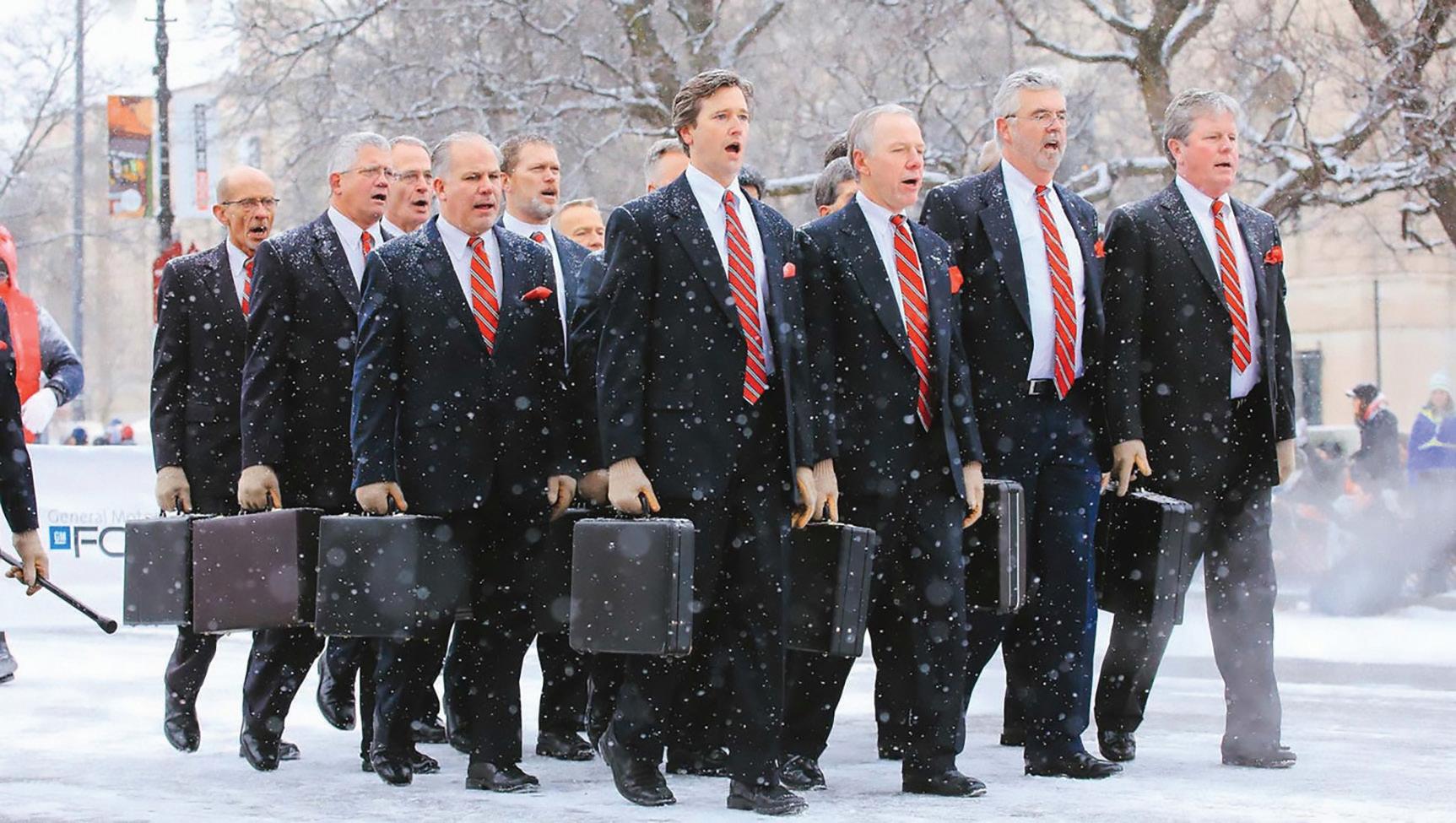
The DAC Briefcase Drill Team takes up the mantle from the Fred Hill Briefcase Drill Team on Nov. 27 for America’s Thanksgiving Parade in Detroit.
BY RONALD AHRENS
For a hometown Plymouth act that launched in 1985 as a spoof, the Fred Hill Briefcase Drill Team ultimately marched far from its Main Street starting point in the Fourth of July parade. It might be said the concept of self-deprecating businessmen left room for development.
After getting the team on its feet for Independence Day, and then other celebrations, Hill approached The Parade Co. in 1988 about joining America’s Thanksgiving Parade, but was rebuffed. He was told the act just seemed too kooky.
A timely story in The Wall Street Journal raised the team’s profile, and with a coincidental change of parade management, an invitation to the group went out in 1989. The team of 16, representing all walks of professional life and ranging widely in age, donned their dark suits, red ties, and Santa caps for the threemile sojourn over Woodward Avenue.
“We’re like an army of IRS agents,” Hill, a former Green Beret in the U.S. Army, said in 1996. “It’s an absolute hoot — our version of going hunting.”
The owner of Fred Hill Haberdashers took initial inspiration from the 1981 film “Stripes” and a lawnmower consort in another parade. At first Hill’s team wielded umbrellas, but they eventually embraced briefcases, and gave five performances per year after receiving up to 40 invitations.
Sometimes they marched for free. When a fee was received, it went to charity.
Following two heralds with a banner, the 16 marchers went four abreast as Hill directed the team with a drum major’s precision. Besides Detroit at Thanksgiving, they celebrated in the Red Wings’ Stanley Cup parades, commemorated Detroit Metro
The Fred Hill Briefcase Drill Team, above, which appeared in multiple parades from 1985 to 2012, is being recreated by the Detroit Athletic Club. The new group, the DAC Briefcase Drill Team, will make its debut at America’s Thanksgiving Parade Presented by Gardner White on Nov. 27. The parade route follows Woodward Avenue from Midtown to downtown Detroit.
Airport’s new runway in Romulus, and took a regular spot in Traverse City’s Cherry Festival Parade.
Their routines included singing “Do-Wah-Diddy-Diddy,” Manfred Mann’s No. 1 hit from 1964.
Hill closed his store by 1992, went into real estate, and continued leading the group of men. They perfected such sarabandes as the stutter-stepping “Businessman Boogie” and the “Airport Delay,” in which they sat on their briefcases.
Hailed far and wide, they marched at the Fiesta Bowl in Tempe, Ariz., and the Indianapolis 500. Macy’s Thanksgiving Day Parade included them in 2008 and 2012, before the aging team disbanded to rest their aching backs and knees.
“If you notice, people don’t carry briefcases anymore,” Hill told DBusiness in 2014. He passed away in 2021.
Before too long, though, a drill team revival was conceived. Longtime banker David Provost had belonged to Hill’s unit for a time in the 1980s, until he got married and moved from Plymouth.
“It was a well-tuned fighting machine,” says Provost, the 2025 president of the Detroit Athletic Club. “We had a couple of times where briefcases would get dropped, but it was interesting because we actually practiced (what to do) if somebody dropped their briefcase. One time the parade was really slow, and we had to stand in one spot for 20 minutes.”
Capable of a limited number of routines, they improvised. “We put our briefcases down and went around and shook hands with the crowd,” Provost says. “We’re going to incorporate that into this year’s parade.”
For the 2025 America’s Thanksgiving Parade Presented by Gardner White along Woodward Avenue from Midtown to downtown Detroit, the DAC Briefcase Drill Team will field more than 20 team members carrying briefcases.
“I think the most challenging thing was to find the drum major,” Provost says. “I was very lucky to get a gentleman named Scott Idle who has a lot of drill team experience and a loud voice.”
For Provost, putting the team together substantiates the inkling he had about reconstituting the act.
“We have new members, we have seasoned members, and we’re forming a nice bond in a nice group,” he says. “It’s just another way that the DAC is really a connector in the community.”










